I recently came across two humorous ophicleide images from 19th century France (1847 and 1862, below) while doing some trombone history research. The ophicleide, by the way, is a fellow low brass instrument—a 19th century invention that is considered a predecessor to the modern tuba. It looks something like a cross between a bari sax, a keyed bugle, and a tuba. Below are the two images I recently found, as well as several other images and entries that include ophicleide from the Trombone History Timeline. I have also added a number of other ophicleide pictures that I have found along the way. My personal favorite of all the ophicleide images is probably the one by French painter Fernand Pelez, an artist known for depicting characters from Paris’s everyday life (see 1888; notice especially the detail of the musicians). As always, full citations for sources can be found in the Trombone History Bibliography.
Update #1: I have also decided to add a number of serpent images and references to this post. The serpent, the bass member of the cornetto family, is, like the ophicleide, a fellow low brass instrument and predecessor to the tuba. The ophicleide and serpent are closely related; in fact, the original meaning of ophicleide is “keyed serpent,” and the ophicleide developed as a keyed version of the instrument. Many serpent enthusiasts are also ophicleide enthusiasts (and vice-versa).
Update #2: This serpent and ophicleide post, which now features the largest online collection of serpent and ophicleide pictures, has also become one of the primary suppliers of images for the Serpent Newsletter! I’m pleased the pictures are being used!
______________________
17th century—An anonymous painting depicting numerous angel-musicians with Mary and Christ child includes two serpents. I have been able to find very little information about the painting; 17th century is simply my best guess (art.com sells a reproduction and calls the painting “A Concert of Angels”) (see detail and full image below; public domain). Another art reproduction company lists the artist as “Spanish school.”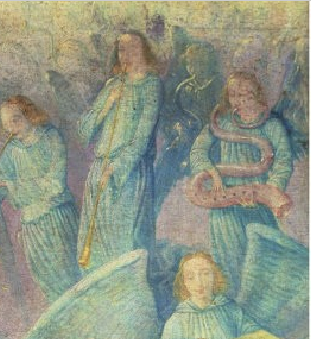
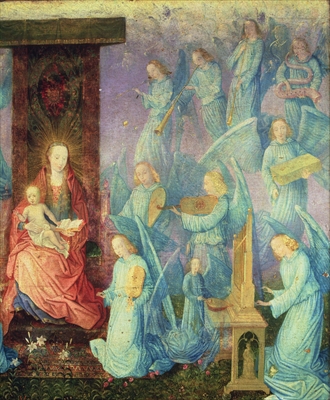
1600—Avignon, France: A triumph wagon for the entry procession of King Henry IV of France and Marie de’ Medici carries a music ensemble that includes what appears to be a serpent (see detail and full image below; public domain) (Bowles, Musical Ensembles 151).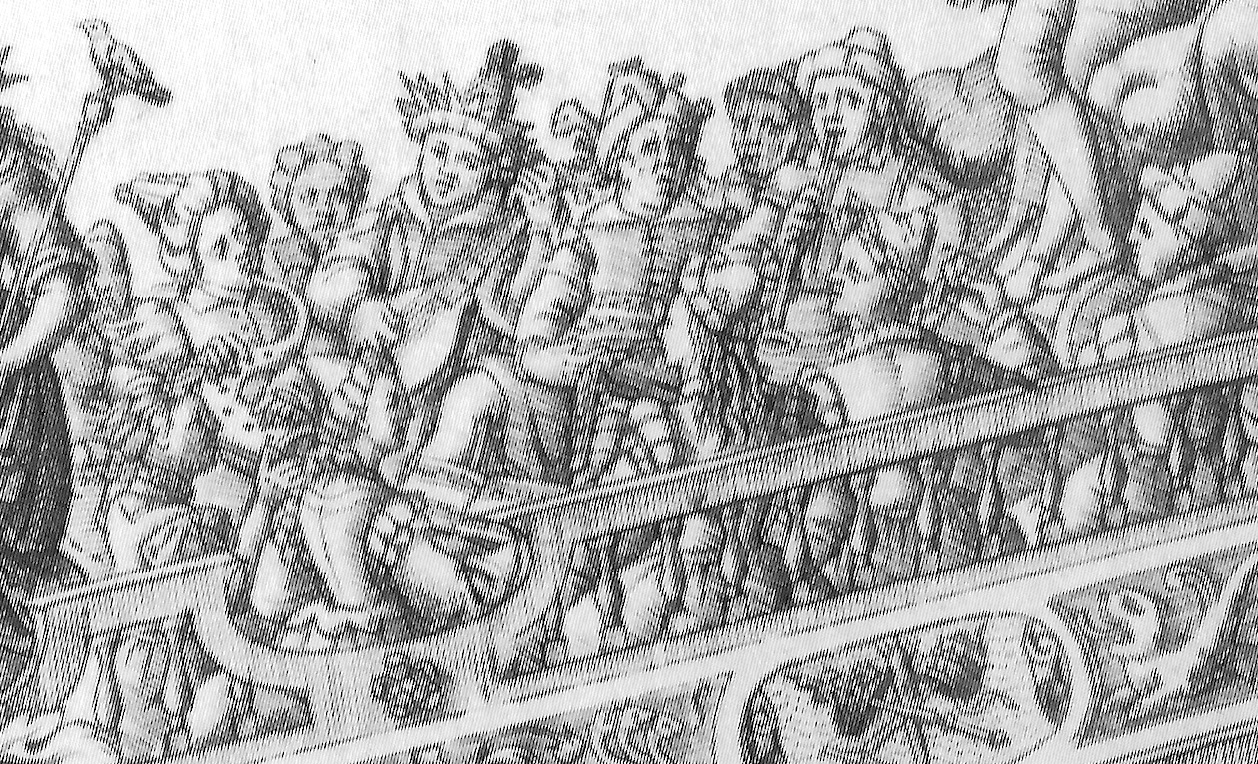
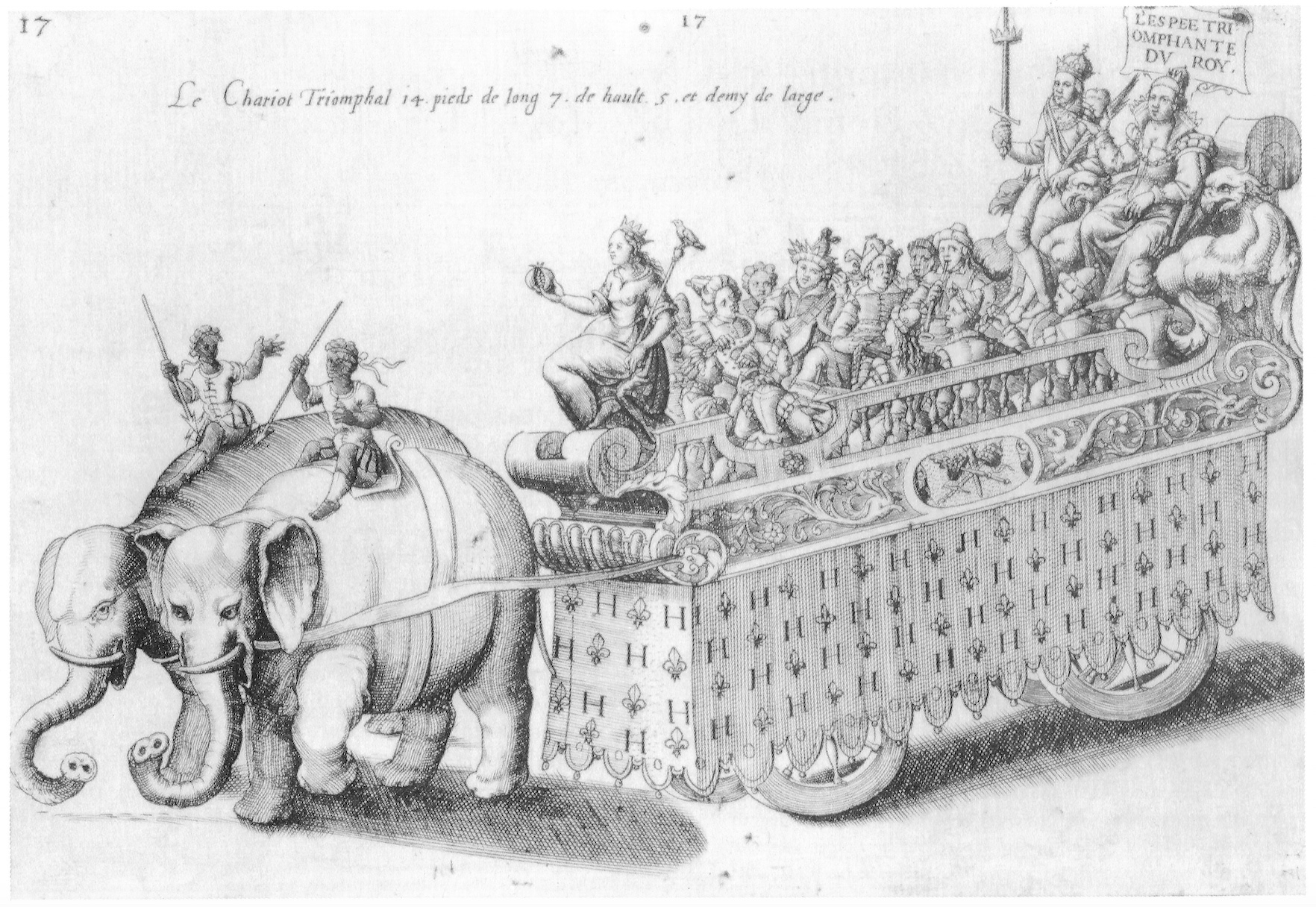
1616—Stuttgart, Germany: Festivities celebrating the baptism of Prince Friedrich von Württemberg include serpent. First, at the service itself, the “Assum Version” festival book records that, following the baptism, a Te Deum by Salomon is sung, utilizing three ensembles: “The first, with a positive organ, four fiddles, two lutes, a small pipe and large contrabass viols, besides four singers. The other, with regal, one cornett, two trombones, a bassoon and four vocal soloists. The third also with a regal, three trombones, a serpent, in addition to four musicians” (Bowles 199-200, 207).
c. 1630—Rome, Italy: An etching from the series Figure con instrumenti musicali e boscarecci by Giovanni Battista Bracelli features a trombone and a serpent (see below image; public domain) (Falletti 107).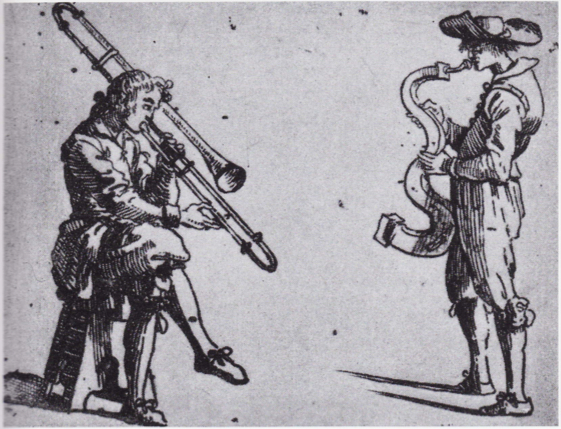
1636—Paris, France: Marin Mersenne discusses serpent and includes a woodcut of the instrument in his Harmonie universelle (see below image; public domain). Among other comments, he says the following in describing the serpent: “To accompany as many as twenty of the most powerful singers and yet play the softest chamber music with the most delicate grace notes,” “But the true bass of the cornett is performed with the Serpent, so that one can say that one without the other is a body without a soul,” “Even when played by a boy it is sufficient to support the voices of twenty robust monks,” and “It seems that the irregular distance of the holes of the Serpent makes its diapason more difficult than that of the other instruments.”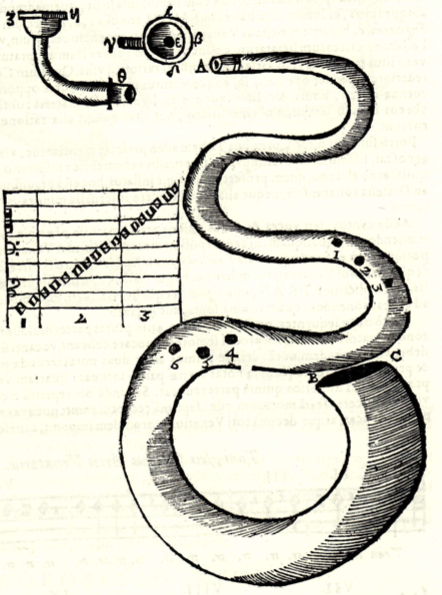
1637—Italy: A frontispiece for a collection of instrumental works by Girolamo Frescobaldi shows two serpents among the decorative clusters of instruments (see middle-left and middle-right, below; public domain) (Emilia Romagna 67).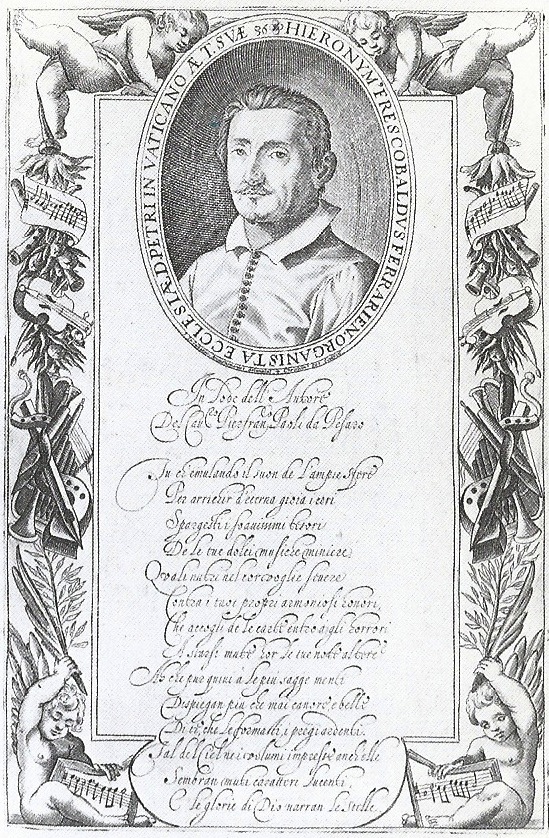
1648-1652—Denis Gaultier’s lute manuscript, La Rhetorique des dieux, features several illustrations that accompany various modes. Three of the illustrations include depictions of the serpent (see plates 19, 9, and 10, below; public domain) (David J. Buch, Coordination of Text, pl. 19, 9, 10).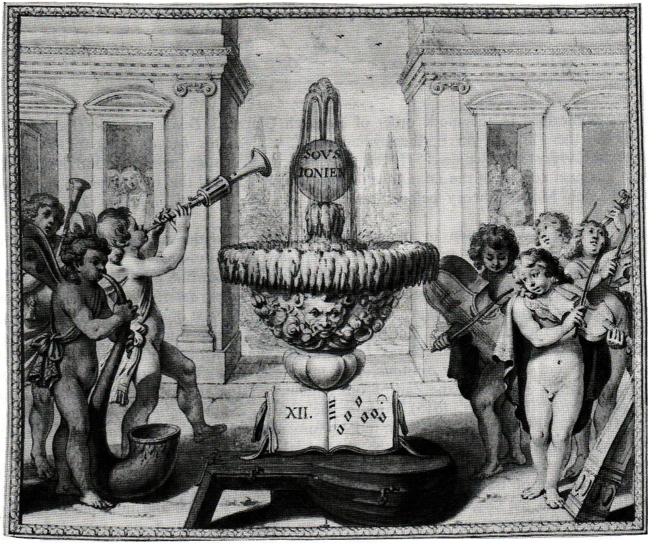
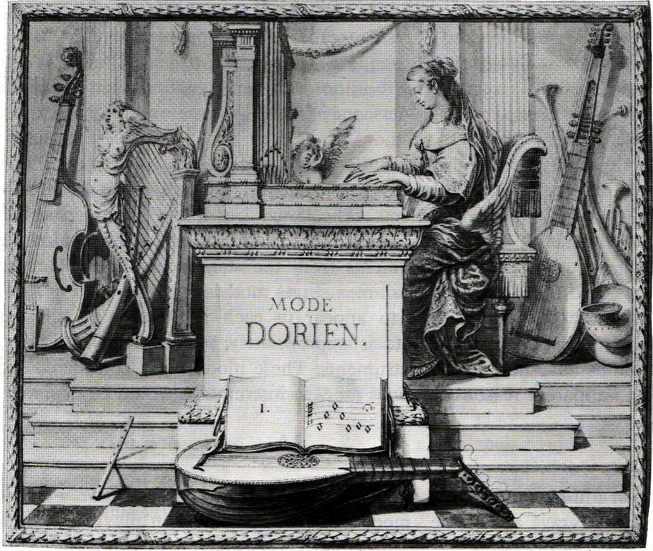
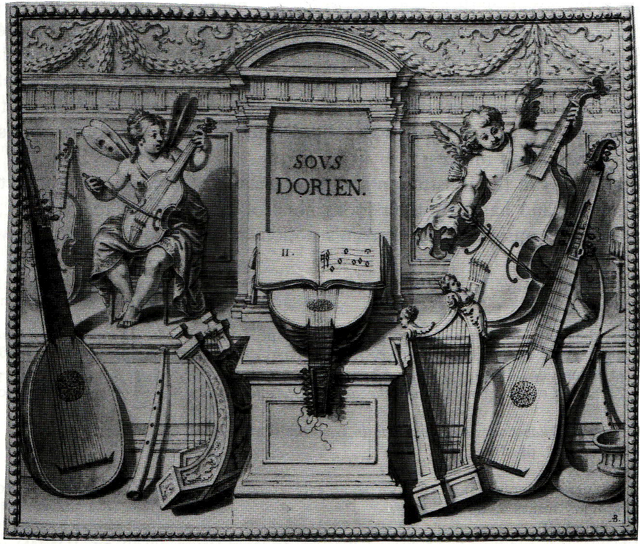
c. 1660—Pierre Paul Sevin’s drawing of a performance of a mass for 4 choirs includes a serpent (see far right of image below; public domain) (Marx, The Instrumentation of Handel’s Early Italian Works).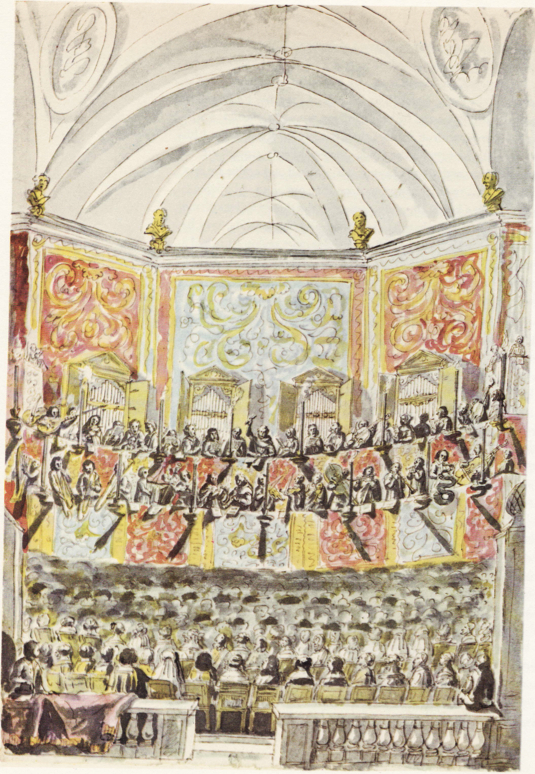
1673—Rome, Italy: Athanasius Kircher includes a print and description of the serpent in his treatise, Phonurgia nova (see below image; public domain) (source: European Cultural Heritage Online).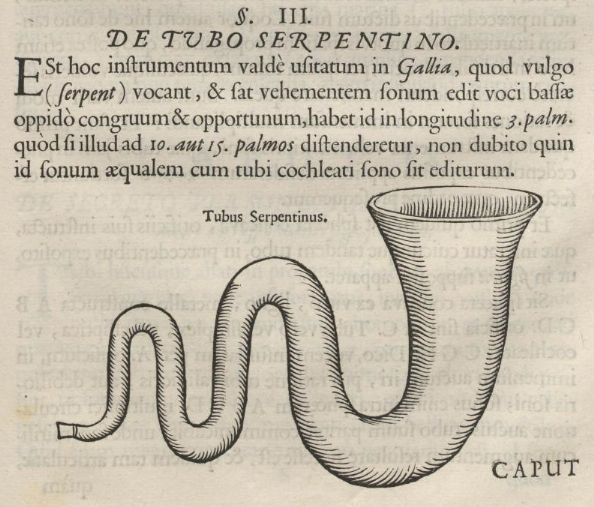
Late 17th century—France: An engraving by Nicolas de Larmessin from a series called Les costumes grotesques et les métiers, a series of fanciful trade costumes, includes what appears to be a serpent among numerous instruments comprising the musician’s costume (see below image; public domain).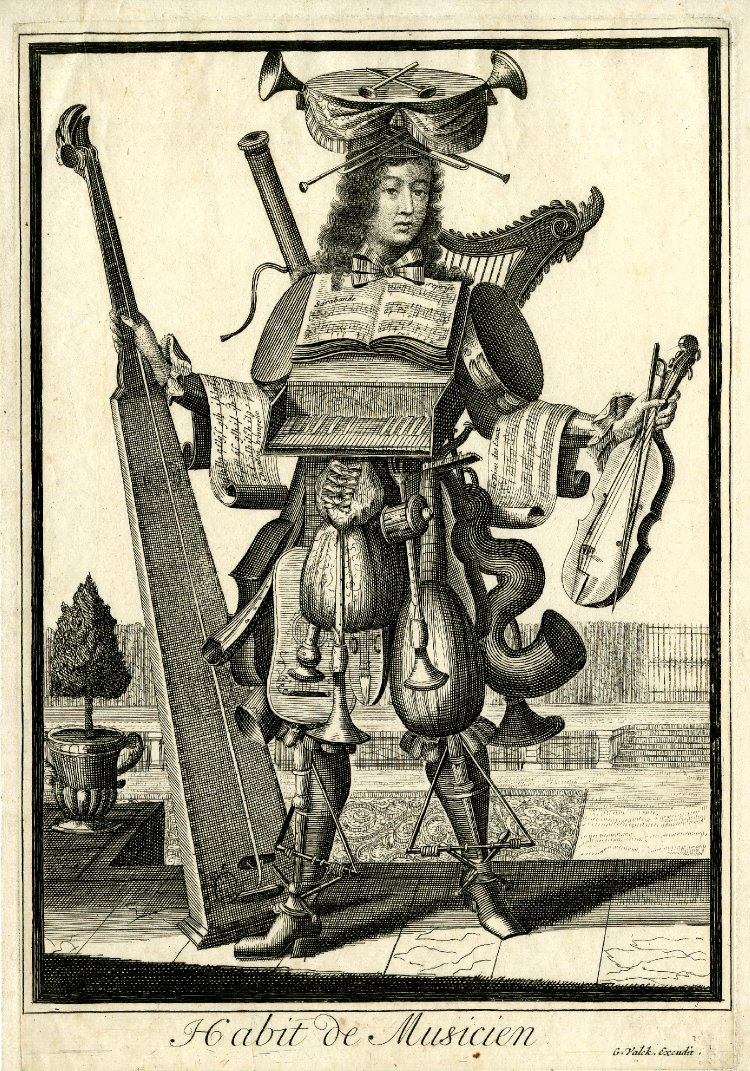
1704-14—Saalfeld, Germany: Carlo Ludovico Castelli paints an angel playing a serpent in Saalfeld’s Schlosskapelle (see below image; public domain).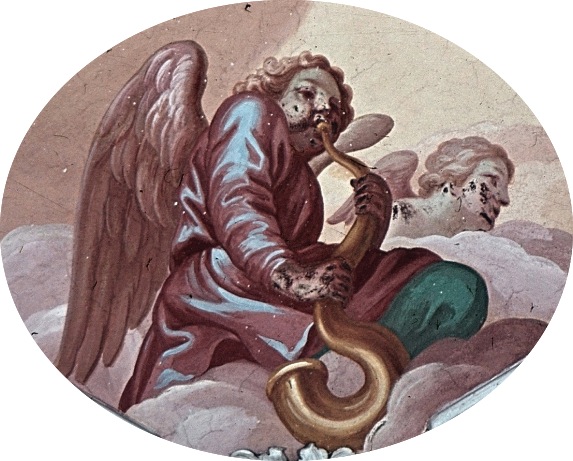
1709—Paris, France: Marc Antoine Charpentier’s Motets melez de symphonie, published posthumously, features an engraving with a cluster of instruments, including a serpent (see upper middle of below image; public domain) (Pincherle 102).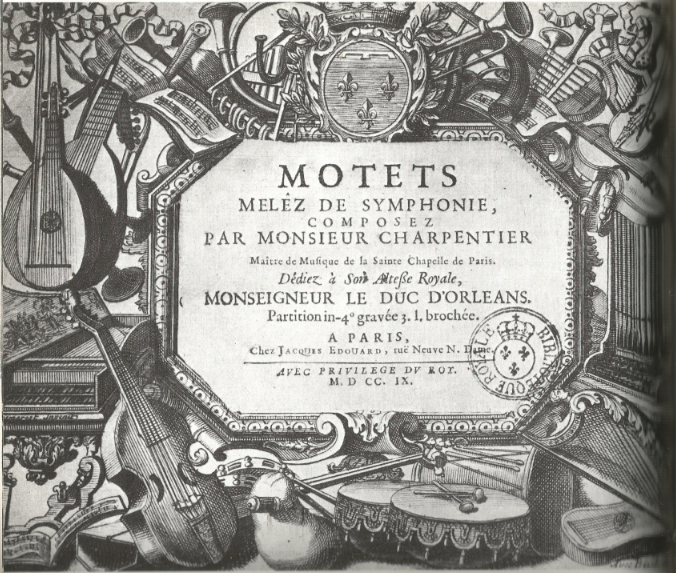
1723—Rome, Italy: An engraving from Filippo Bonanni’s Gabinetto Armonico pieno d’Instromenti depicts a serpent player (see below image; public domain).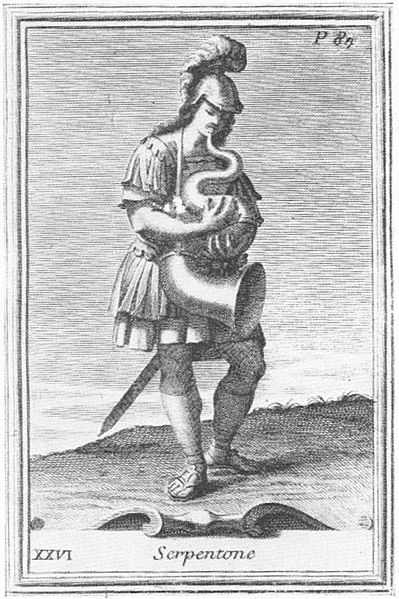
1756—France: Jean-Jacques Rousseau, in the entry on trombone in his Encyclopédie, our Dictionnaire raisonné, says the following: “It serves as the bass in all kinds of consorts of wind instruments, as do the serpent and the bassoon…” (Guion, Trombone 67).
1762-1765—Paris, France: Denis Diderot includes the below graphic of the serpent in his famous Encyclopédie (see below image; public domain).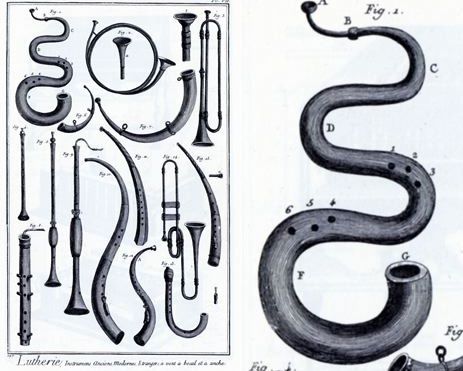
Another plate (pl. XVIII) from Diderot’s encyclopedia, this one illustrating an instrument maker’s workshop, shows a serpent hanging on the workshop wall (see below image; click on image to expand; public domain).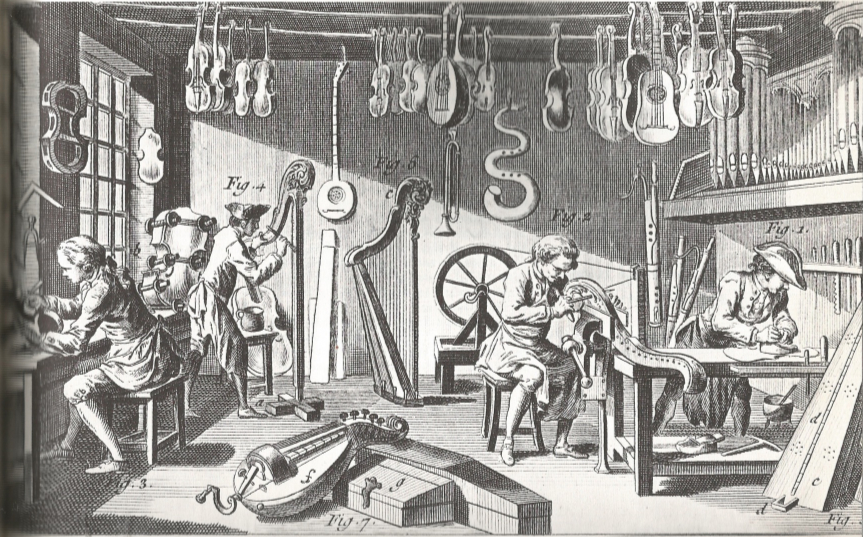
1779-1781—London, England: Johann Zoffany’s portrait of the Sharp family, a musical family that holds regular concerts in London and on board their sailing barge, includes James Sharp holding a serpent (see below image; click picture for large image; public domain) (source: National Portrait Gallery, London).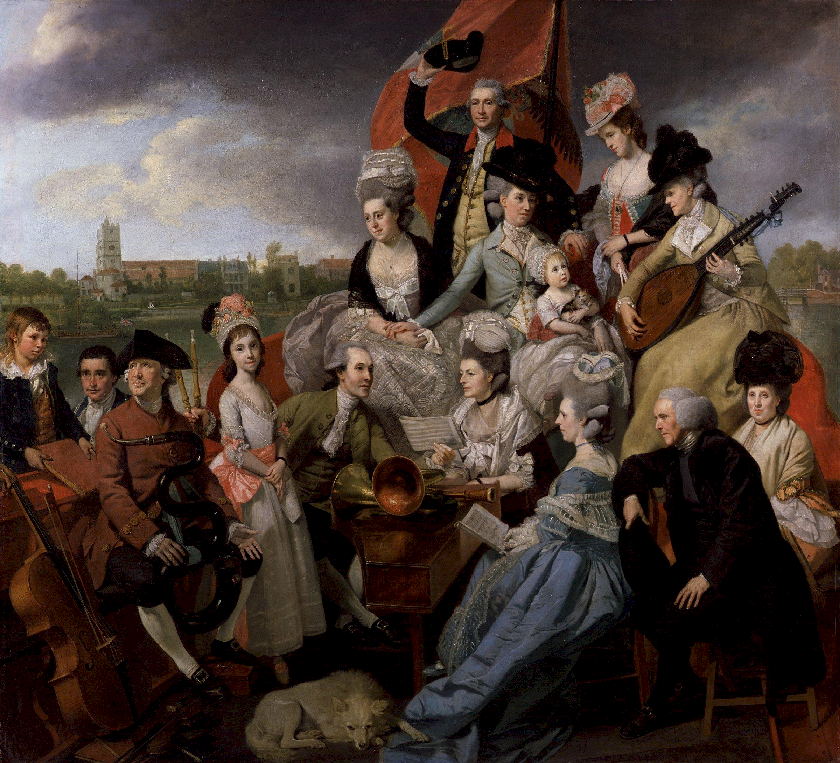
1781-1854—Amsterdam, Netherlands: Military Music, a catchpenny print produced by Erve H. Rijnders, includes a serpent (see below detail; public domain) (Catchpenny Prints of the Dutch Royal Library).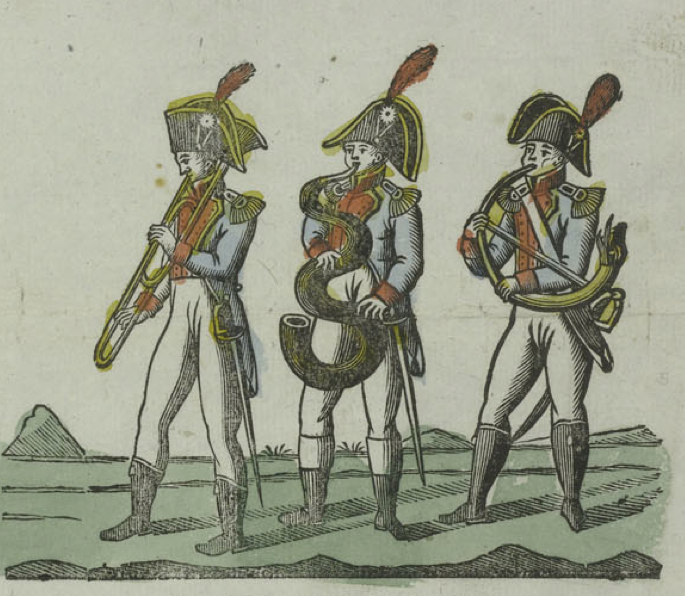
1789—Paris, France: An image labeled Le Concert features a serpent performing with trio (see below image; public domain) (French National Library).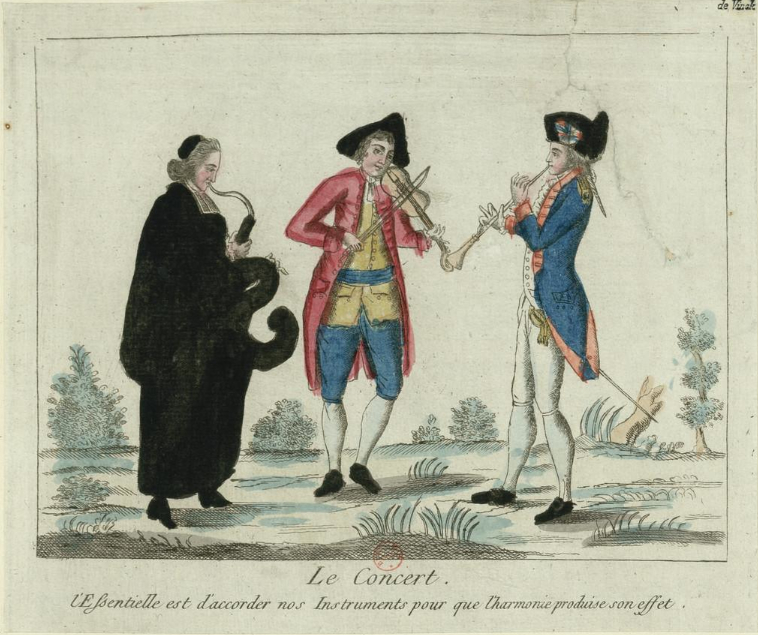
c. 1790—London, England: An engraving depicts a regiment of Foot Guards in front of St. James’s Palace. Included among the soldier-musicians is a serpent player (see below detail; public domain; Strachan, British Military Uniforms, pl. 27) (Scottish United Services Museum).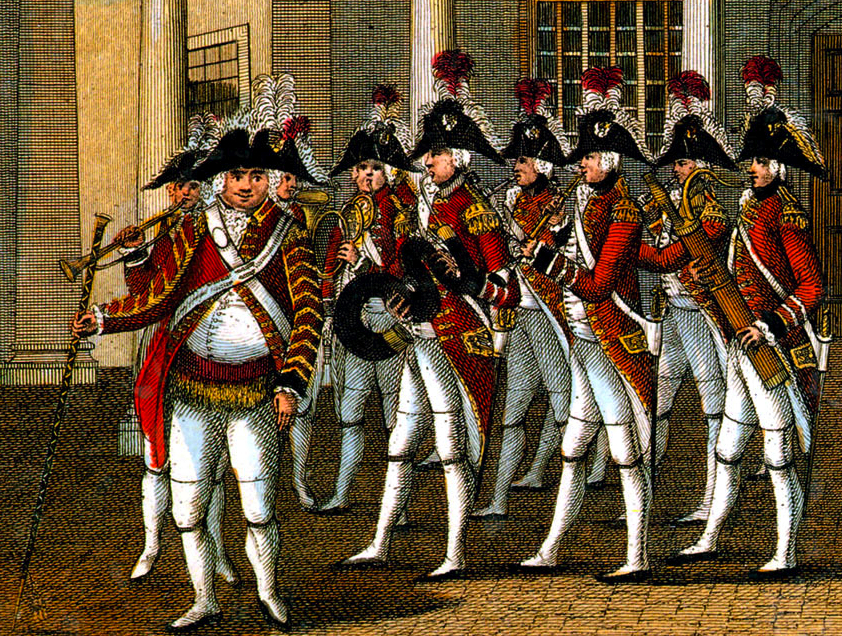
19th century—France: An anonymous painting, now held in Musée des Civilisations de l’Europe et de la Méditerranée (Paris) depicts a man playing serpent (see below image; public domain).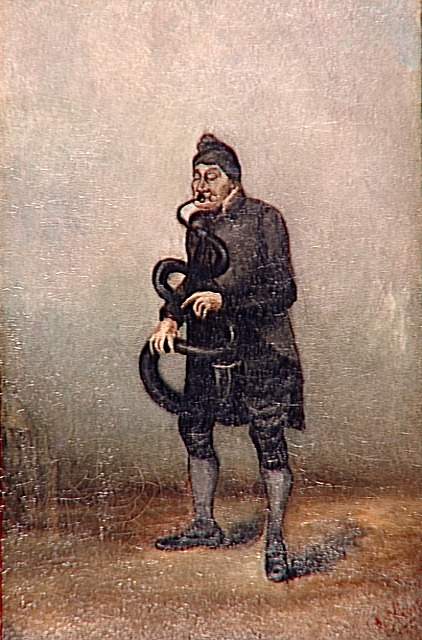
19th century—France: Le Serpent de la Paroisse, with music by Charles Plantade and text by Charles Delange, is published by J. Meissonnier & Fils in Paris (see below image; public domain).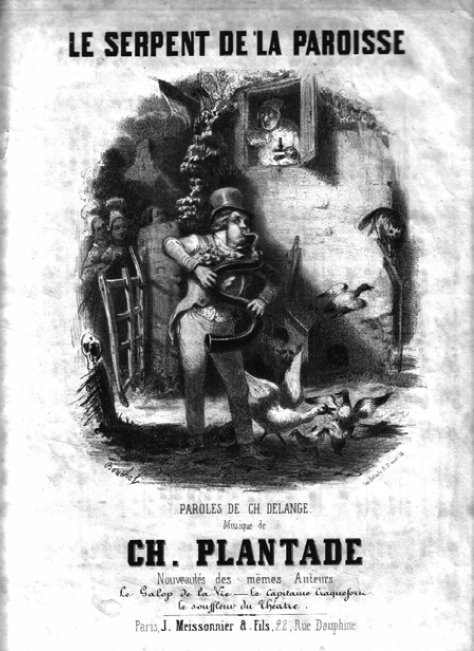
c. 1800—Nuremberg, Germany: An image depicting Nuremberg military musicians includes a serpent player (see below image; public domain) (Nuremberg, German National Museum).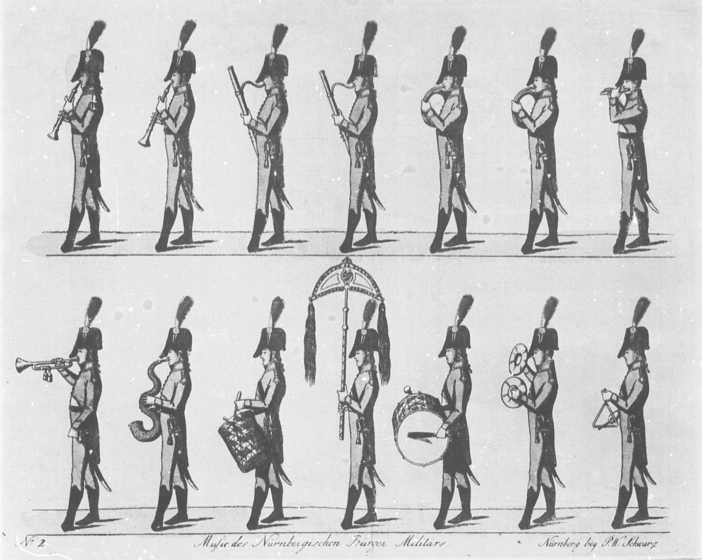
c. 1800—Germany: A print of military musicians entitled Turkische Musick der K. Baierischen Grendier Garde, now held in the German National Museum, includes a serpent (see below detail; public domain).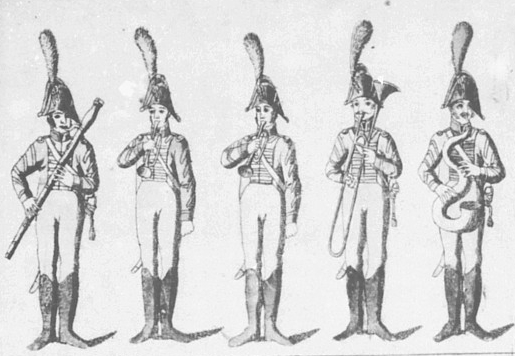
c. 1800—Frankfurt am Main, Germany: Philipp Jakob Döring publishes a sheet of cut-outs of military musicians that includes a man playing serpent (see below detail; public domain) (German National Museum).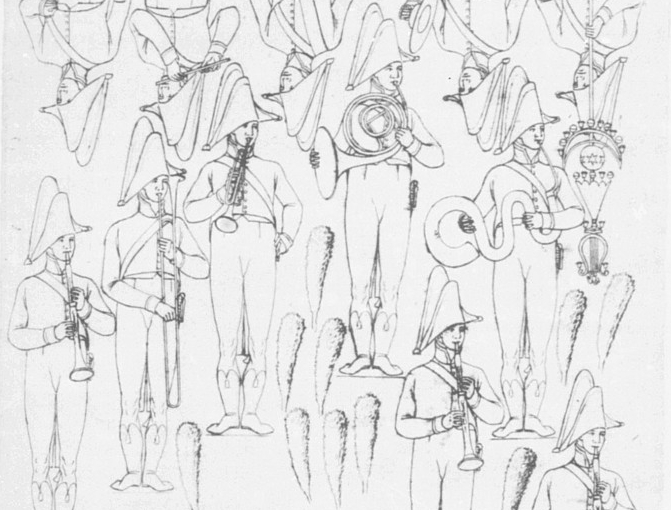 1800s—France: A print entitled Macédoines—Jongleurs—Tours de force et d’adresse features a row of musicians, including a a man playing ophicleide (see below detail; public domain) (Paris, Musée des Civilisations de l’Europe et de la Méditerranée).
1800s—France: A print entitled Macédoines—Jongleurs—Tours de force et d’adresse features a row of musicians, including a a man playing ophicleide (see below detail; public domain) (Paris, Musée des Civilisations de l’Europe et de la Méditerranée). 1804-1815—France: A military illustration labeled French Napoleonic Band depicts the foot grenadiers of the 1st Regimental Imperial Army Old Guard, including a serpent player (see fourth row of image below; public domain) (Cassin-Scott and Fabb 15).
1804-1815—France: A military illustration labeled French Napoleonic Band depicts the foot grenadiers of the 1st Regimental Imperial Army Old Guard, including a serpent player (see fourth row of image below; public domain) (Cassin-Scott and Fabb 15).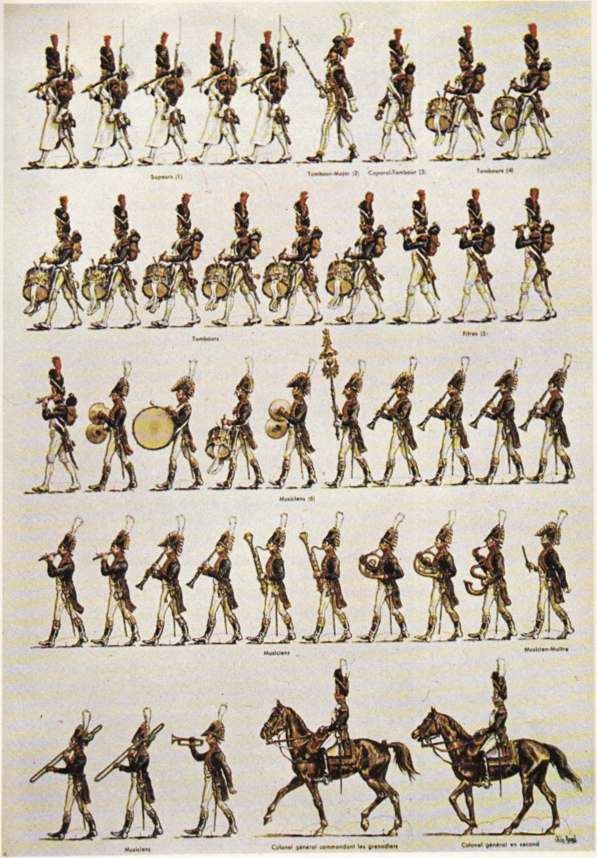
1806—France: An image depicting 7 French military musicians includes a soldier playing a serpent (see below image; public domain) (New York Public Library Digital Gallery).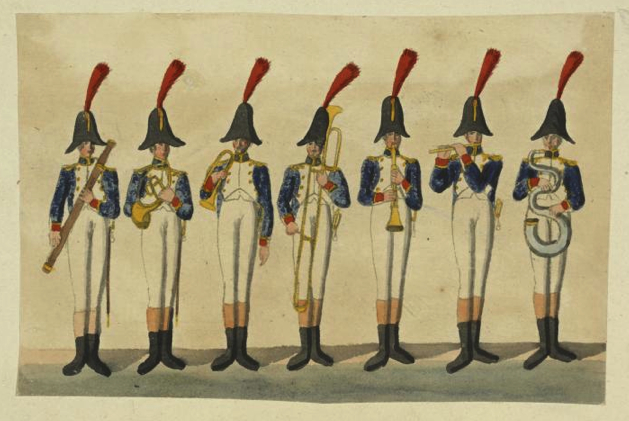
1807-08—Hamburg, Germany: A painting from a series of military depictions by Christoph and Cornelius Suhr published in the 1820s in the book, Abbildung der uniformen aller in Hamburg seit den jahren 1806-1815 einquartiert gewesener truppen, portrays a group of musicians from the Catalonia Light Infantry Regiment from 1808-08 (see below image; public domain).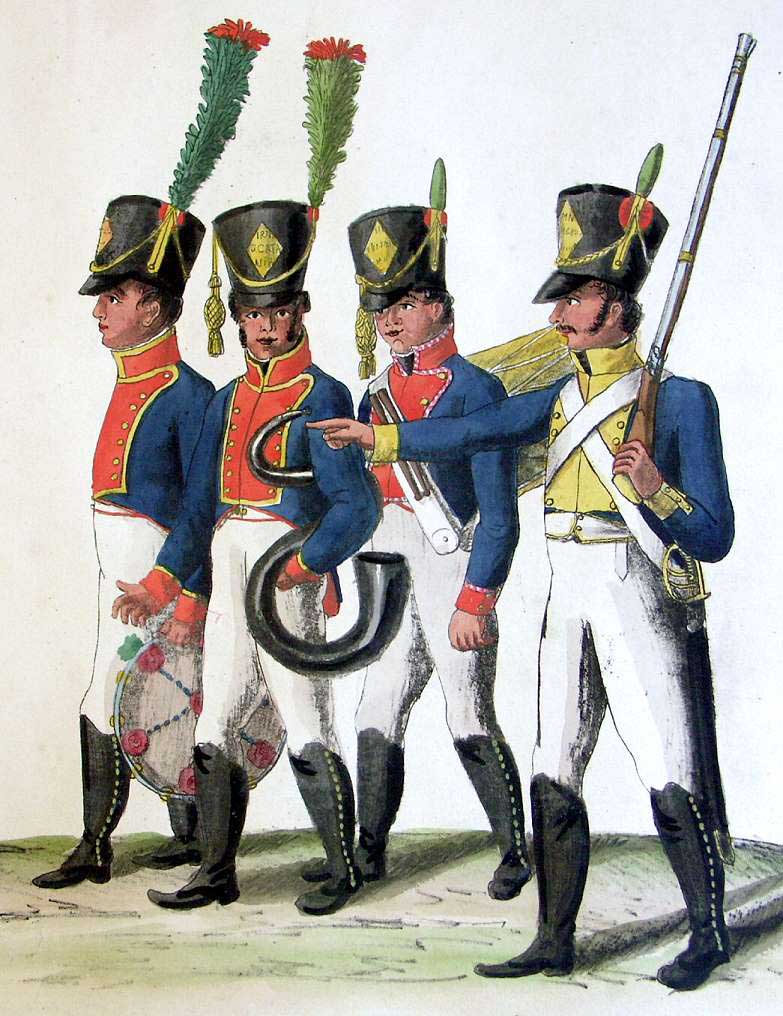
1807-08—Strasbourg, France: A print published by J. Gottfried Gerhardt illustrates, among a variety of soldiers from the Napoleonic army, an infantry regiment band that includes a serpent (see below image; public domain) (Ryan 21).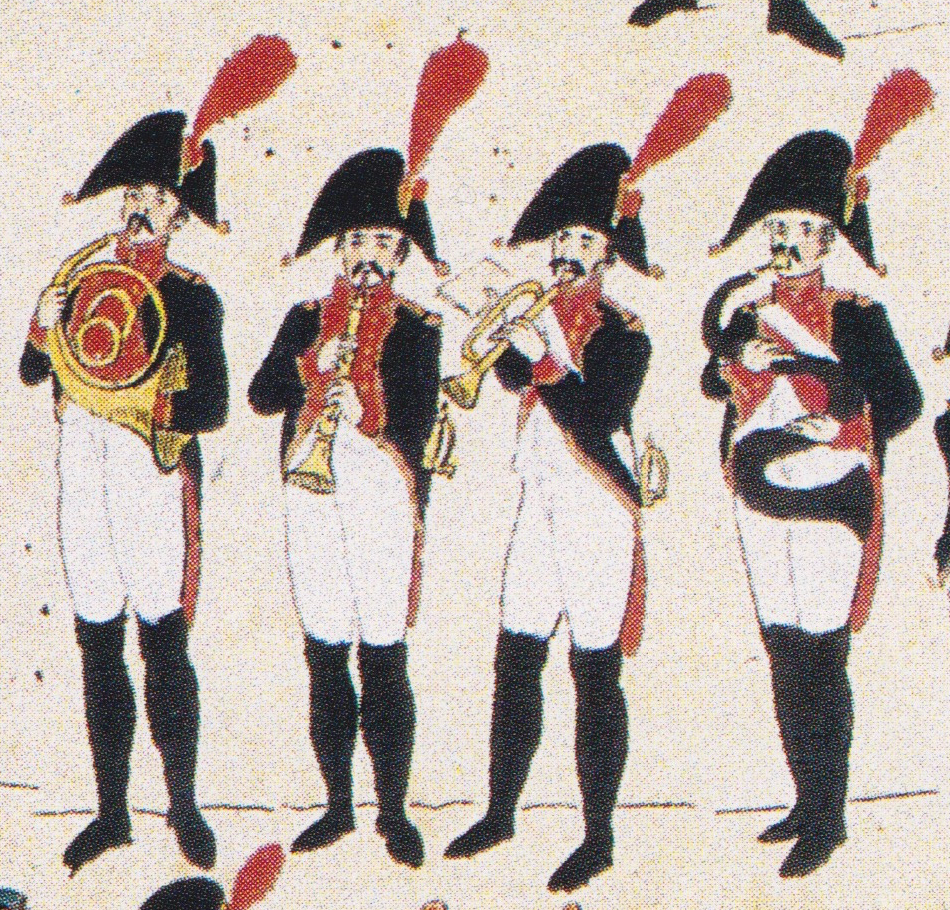
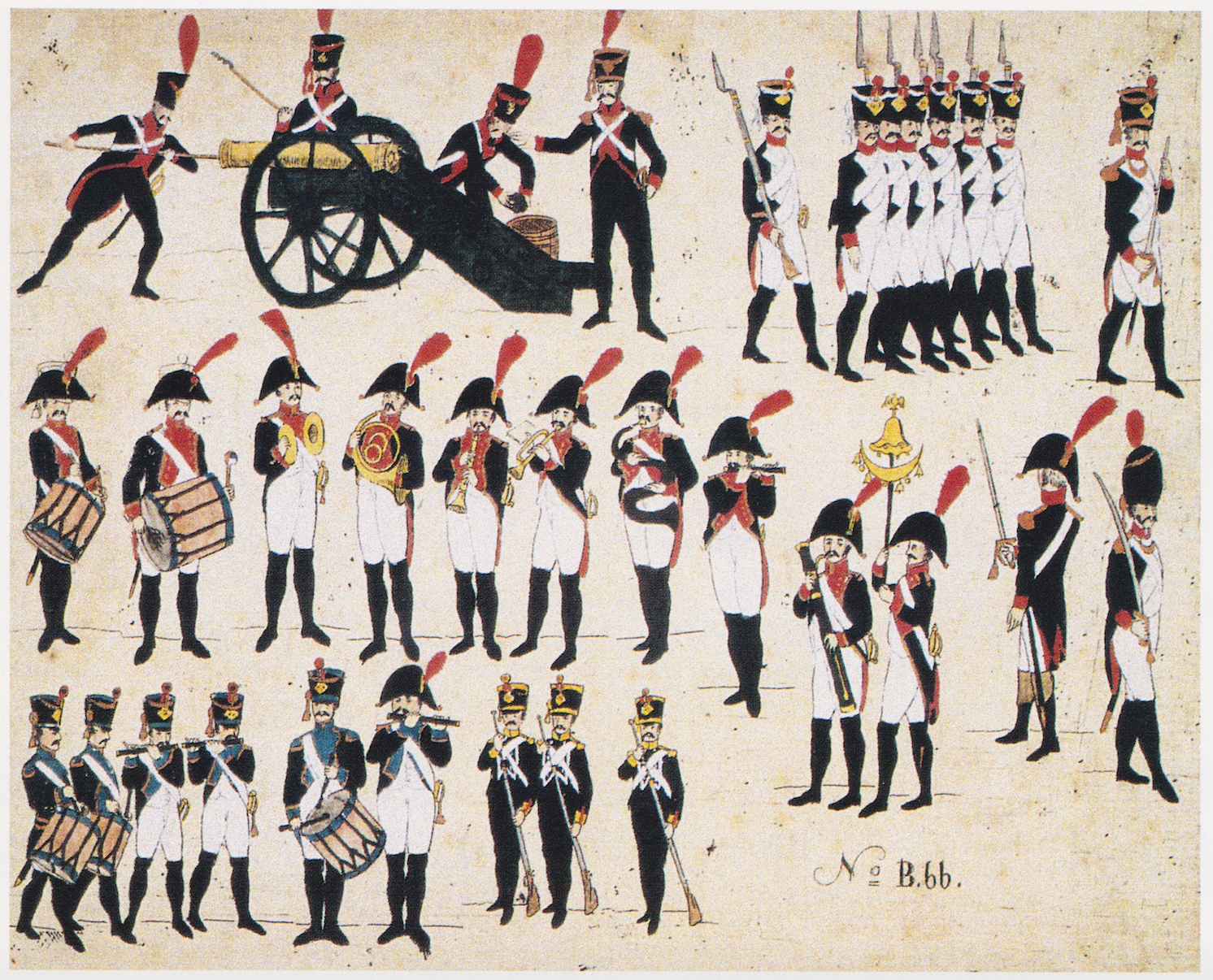
1809-1837—France: A printed entitled Planche de militaires, published by Jean-Baptiste Castiaux, includes a depiction of a military serpent player (see below image; public domain) (Paris, Museum of Civilization in Europe and the Mediterranean).
c. 1810—France: A print entitled Musique de la Garde Imperiale features military musicians from the 1st empire, including a serpent player (see bottom-right of below image; public domain).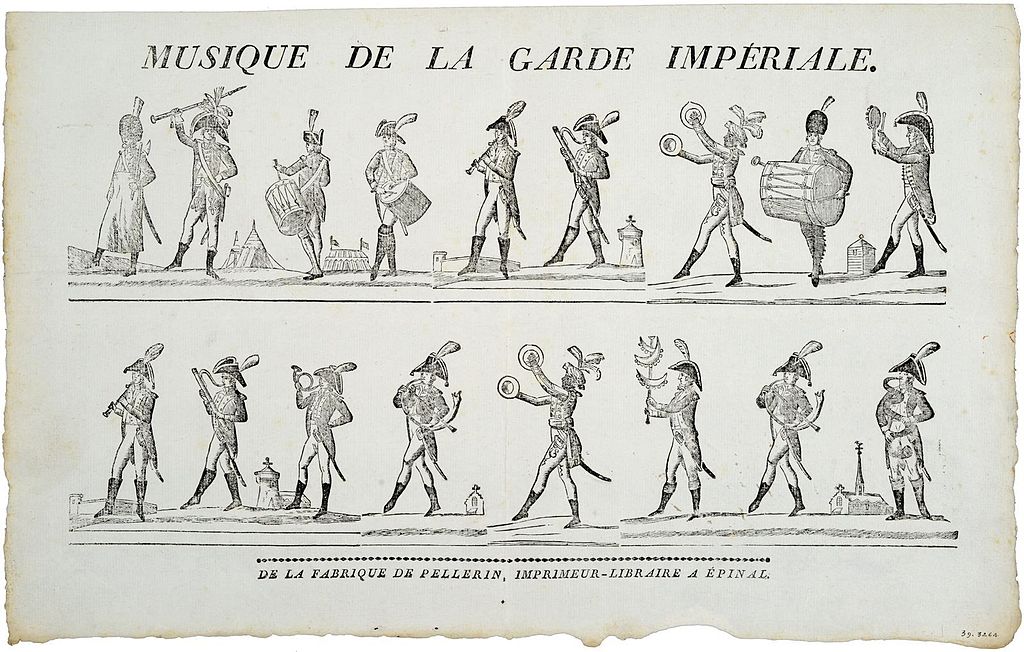
1810-18—Nürnberg, Germany: Music des Nürnbergischen Bürger Militärs, a print published by Paul Wolfgang Schwartz, includes a serpent player (see below image; public domain) (Ryan 155).
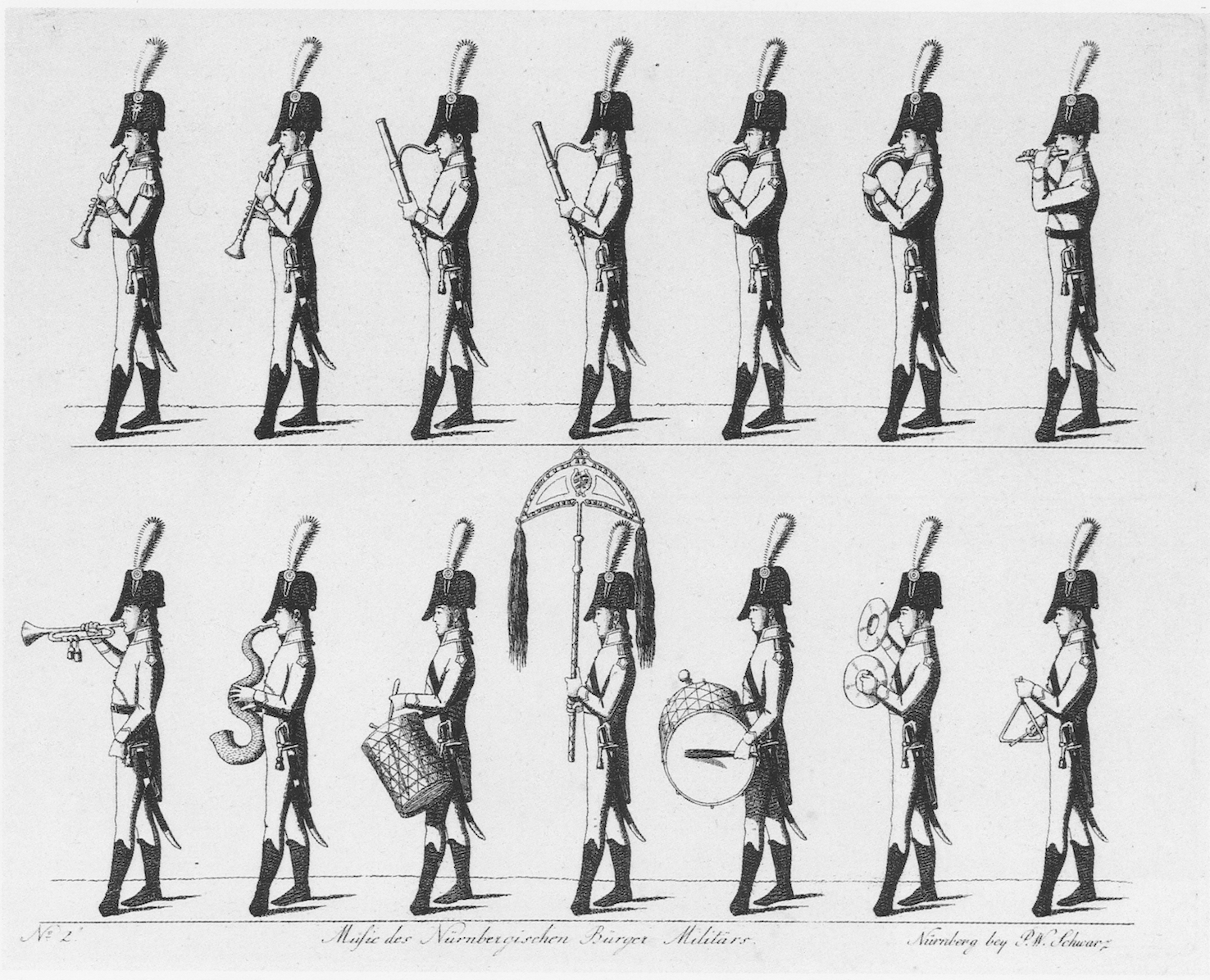
1811—Paris, France: A print published by Aaron Martinet in his series, Troupes Françaises, depicts a military serpent player. One of 296 prints in the collection, the image is titled “Garde Impériale: Musicien des Grenadiers a pied” (see below image; public domain).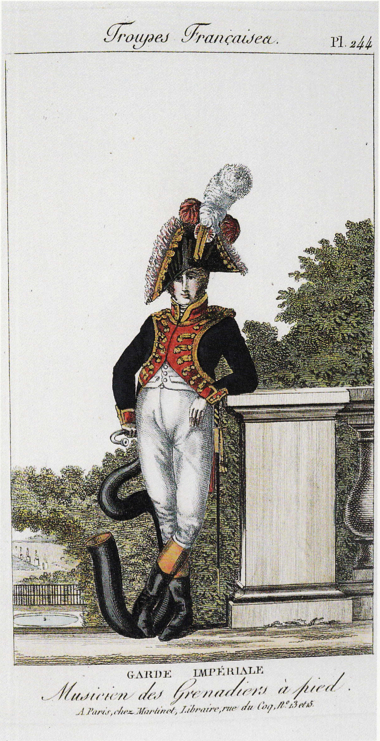
1811—An illustration of the Duke of Gloucester’s Band, an ensemble associated with the 3rd regiment of the Scots Guards, includes a serpent (see below image; public domain).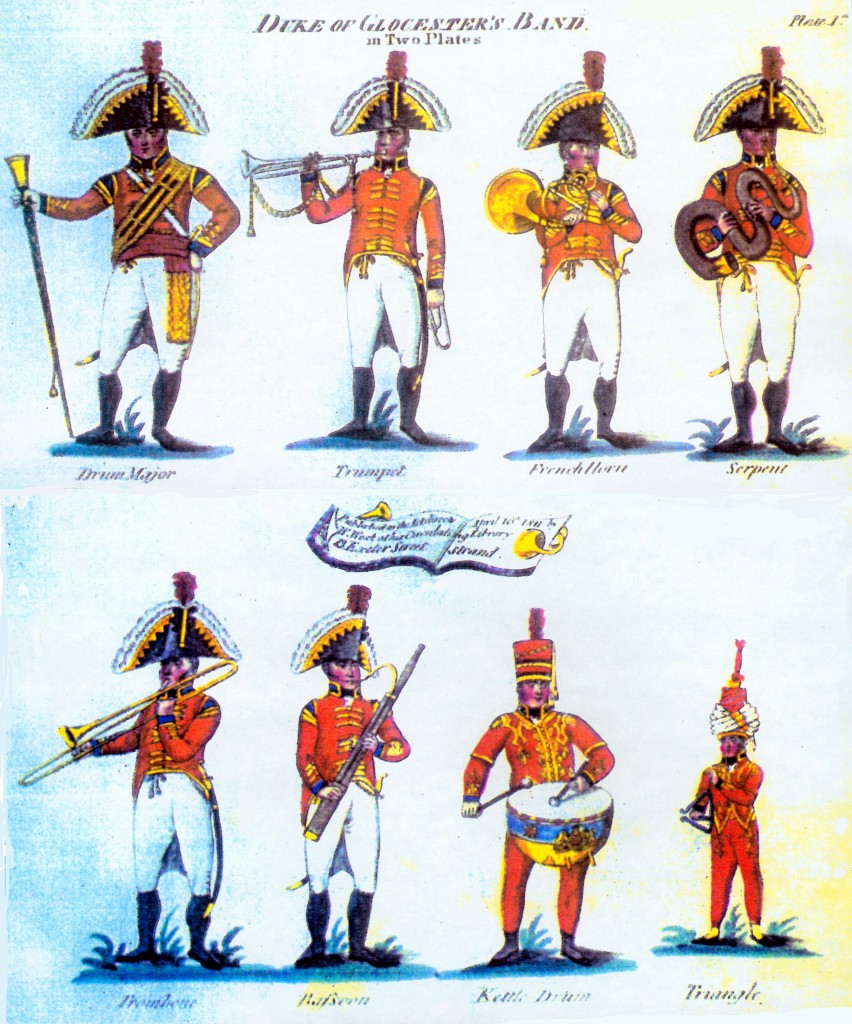
1812—Paris, France: Carle Vernet, a leading French military artist, is commissioned to provide paintings of Napoleon’s new military uniforms for use by the military and its tailors. Among the series of paintings, assembled in the collection Le Grande Armée de 1812, is a picture of military musicians that includes a serpent hanging on a wall in the background (see below image; public domain) (source: wikimedia).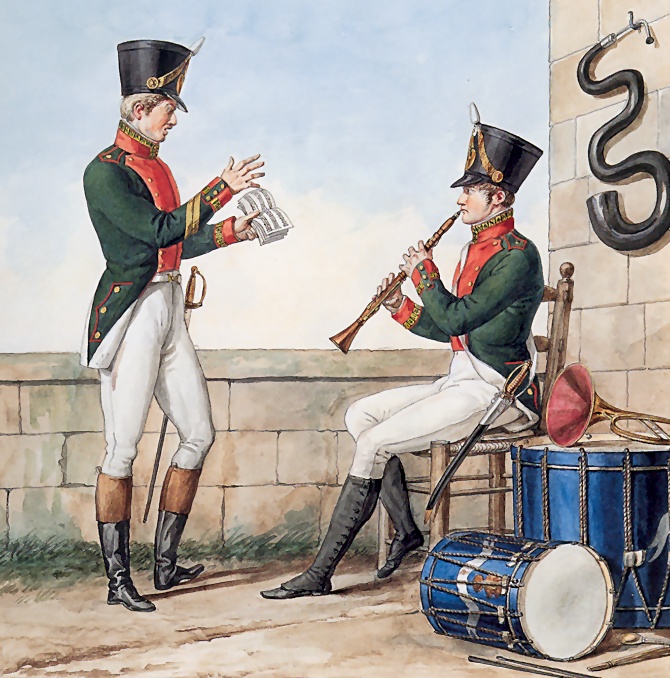
c. 1814—Paris, France: An anonymous method book, Méthode de Serpent adoptée par le Conservatoire de musique, includes, among other materials, a fingering chart for serpent (see below image; public domain) (National Library of France).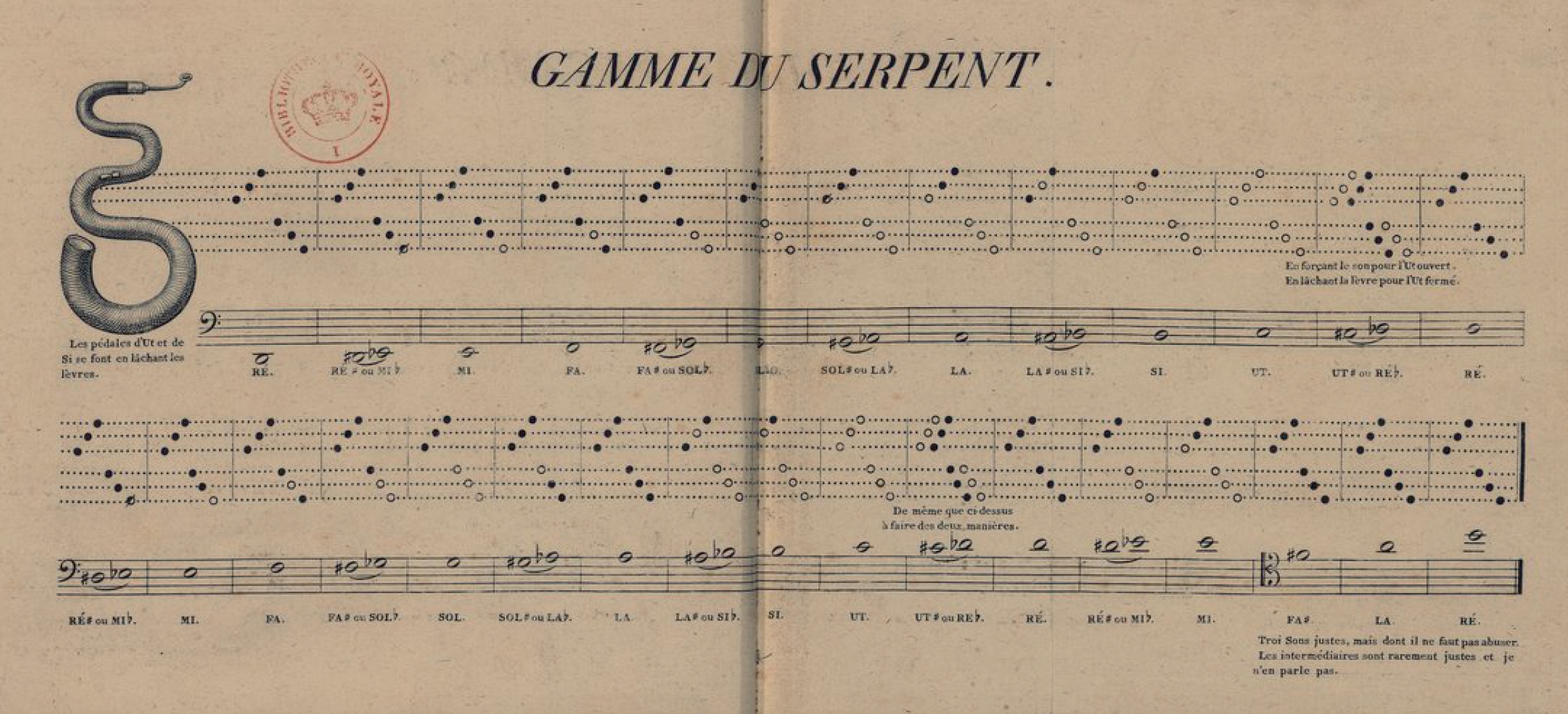
1814—Luigi Cherubini, who later becomes director of the Paris Conservatoire, writes a work for five brass instruments titled Pas redoubles et marches pour la Garde du Roi de Prusse. Scored for natural trumpet, three hand-horns, and serpent or trombone, it is conceived in the French Revolutionary military band tradition (Wallace, Brass Solo 240).
1824—Milan, Italy: Francesco Mirecki, a Polish musician active in Italy, mentions serpent in his treatise, the earliest known Italian orchestration treatise. He considers bass trombone a useful alternative to serpent as the effective bass of the brass family (Meucci).
1820—Milan, Italy: A hand-colored engraving entitled Banda degli Ulani Francesi (Band of French Lancers) features a number of mounted musicians, including a pair of ophicleides (see detail below; public domain) (source: Oberlin Conservatory Library Special Collections).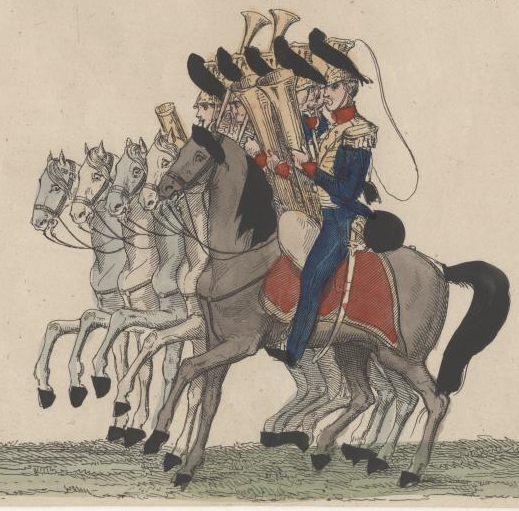 1821—George IV, King of England, Entering Dublin, a painting by William Turner, depicts a band of cavalry musicians, including trombones and serpents (see detail and full image below; public domain) (National Gallery of Ireland).
1821—George IV, King of England, Entering Dublin, a painting by William Turner, depicts a band of cavalry musicians, including trombones and serpents (see detail and full image below; public domain) (National Gallery of Ireland).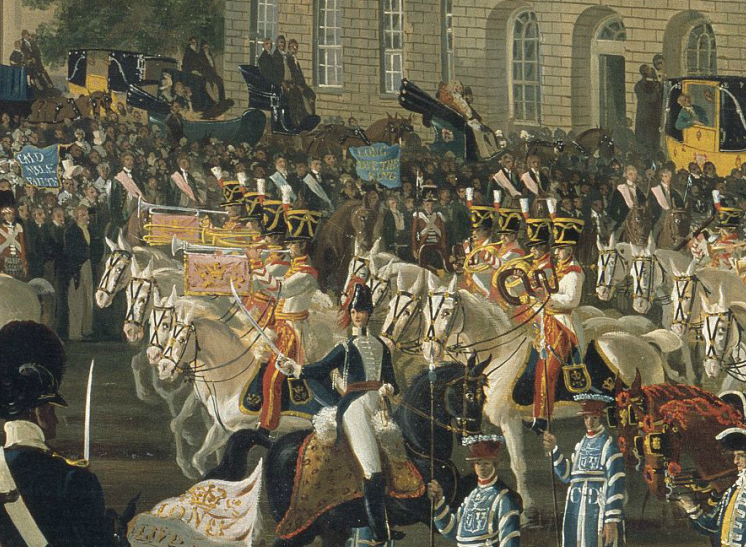
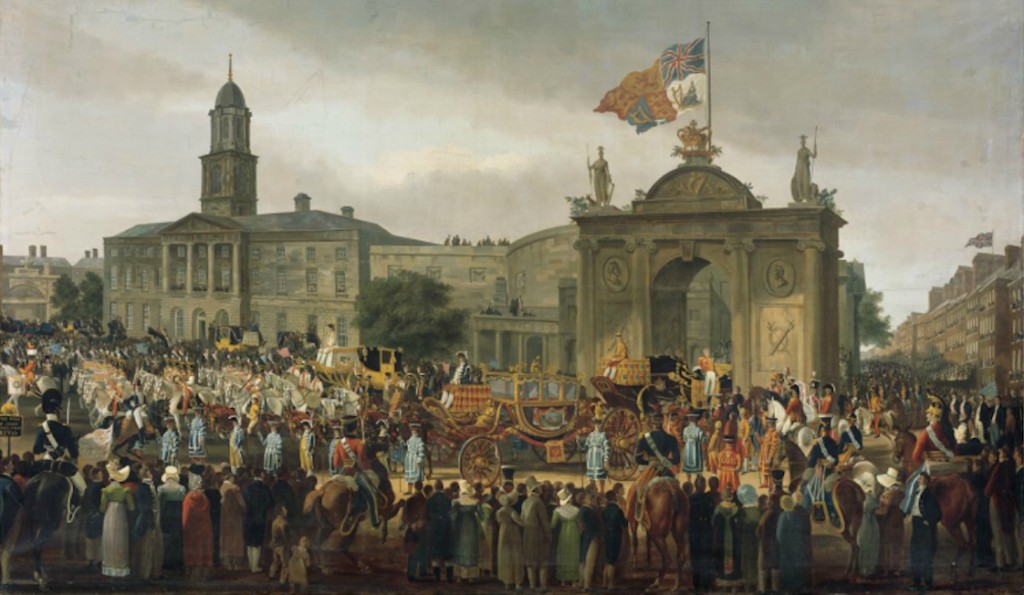
1823—France: An image labeled Infanterie de ligne depicts a military musician playing ophicleide (see below image; public domain) (New York Public Library Digital Library).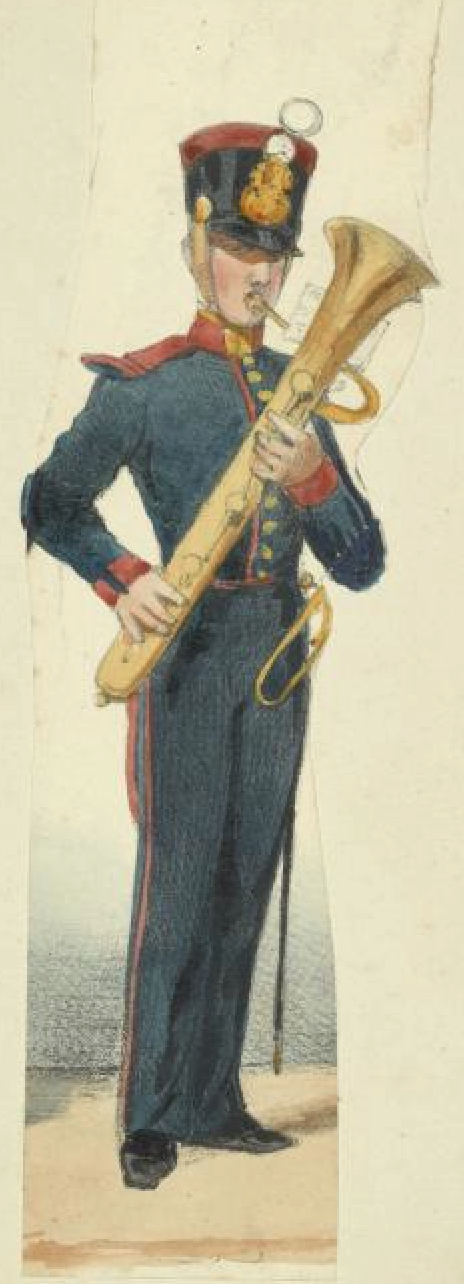
c. 1825—France: Pellerin, publisher of French popular prints, publishes an image titled Musique d’Infanterie Francaise, which includes both a serpent and an ophicleide—often the latter is thought of as a replacement for the former, making it somewhat unusual to include both (see below detail; public domain) (Paris, Museum of Civilization in Europe and the Mediterranean).
1825—New York: The brass section of the Independent Band consists of horns, trumpets, trombones, and serpent (Mendoza da Arce 185).
c. 1825—England: A sketch by George Scharf depicts several musical instruments, including serpent and ophicleide (see below image; public domain) (British Museum).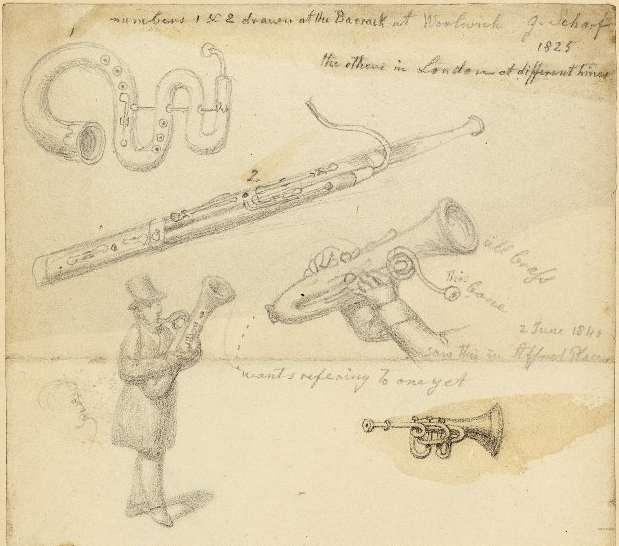
1825—An image, labeled Musicanti austriaci, depicts two military musicians, including an ophicleide player (see below image; public domain) (Instituto per la storia del Risorgimento italiano, Rome).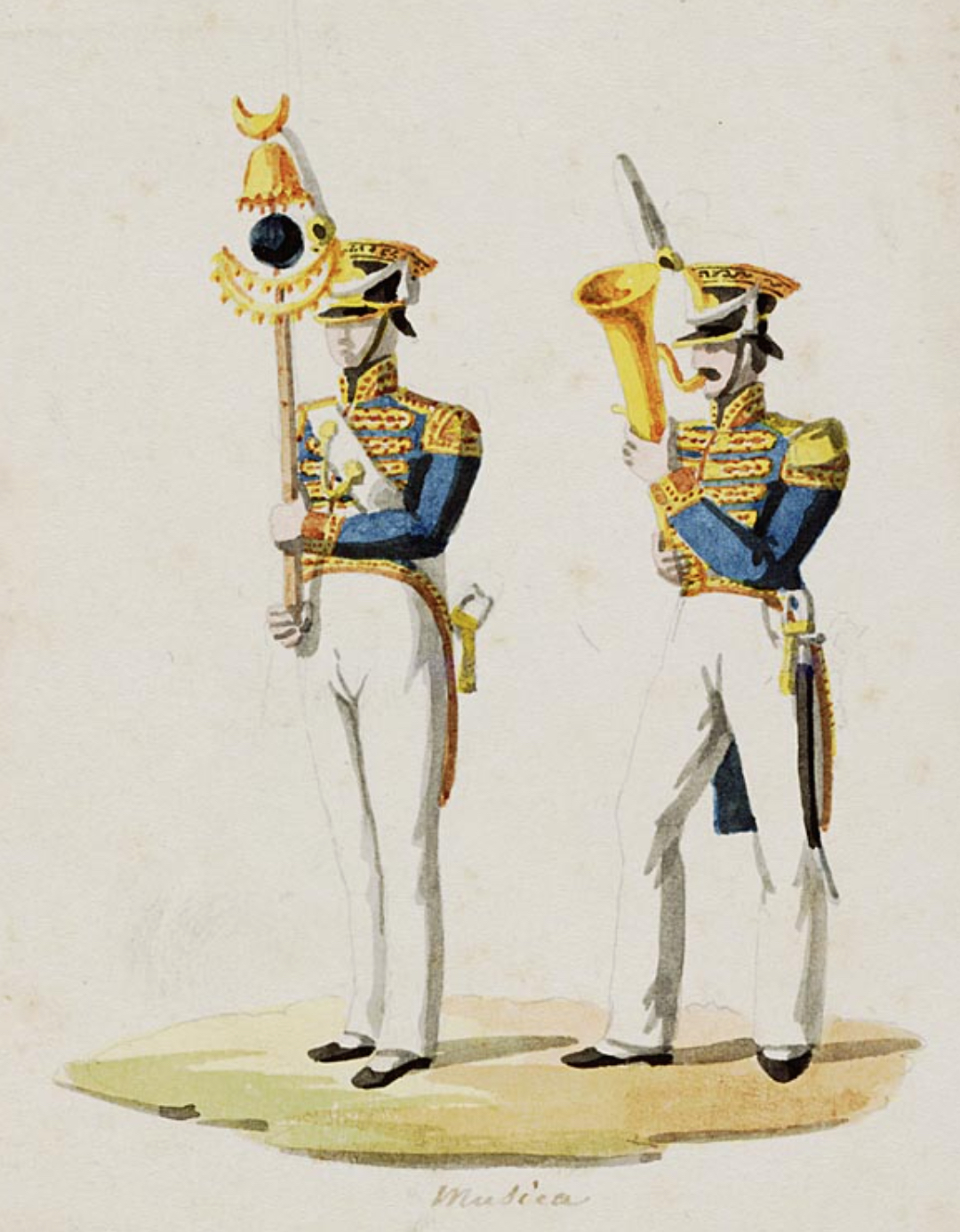
1825-50—Strasbourg, France: A watercolor by Wurtz and Pees, part of a collection of military figurines, depicts a serpent player of the regiment of mounted grenadiers of the Imperial Guard (see below image; public domain) (Paris, musée de l’Armée).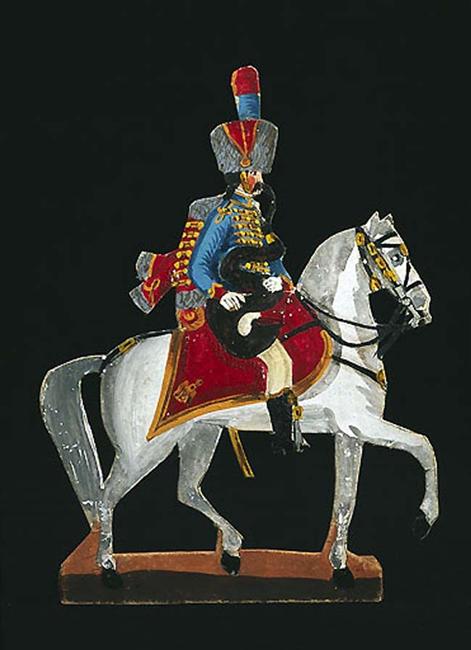
1825-50—Strasbourg, France: A watercolor by Wurtz and Pees, part of a collection of military figurines, includes depictions of 2 serpent players of the battalion of Neufchatel of 1808 (see below image; public domain) (Paris, musée de l’Armée).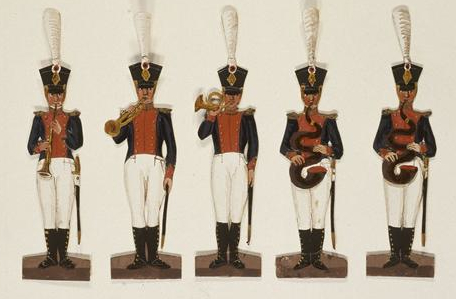
1825-50—Strasbourg, France: A watercolor by Wurtz and Pees, part of a collection of military figurines, includes a depiction of a serpent player on horseback with the 7th regiment of cuirassiers (see below image; public domain) (Paris, musée de l’Armée).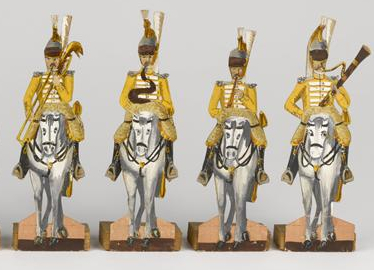
1825-50—Strasbourg, France: A watercolor by Wurtz and Pees, part of a collection of military figurines, includes a depiction of a serpent player with the musicians of the “régiment Irlandais, 1809-1811” (see below detail; public domain) (Paris, musée de l’Armée).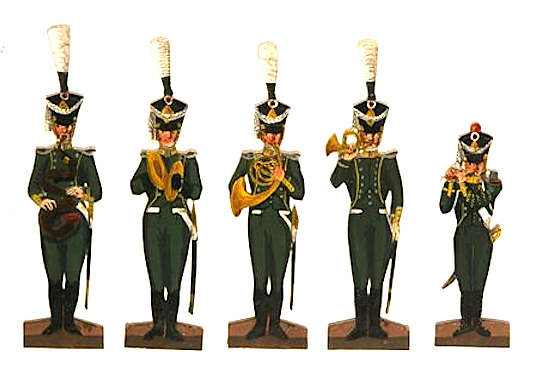
1825-1850—Strasbourg, France: The Wurtz and Pées family produces paper figurines of various military units. Among them are the below cavalry musicians, which include a serpent player (see below image; public domain).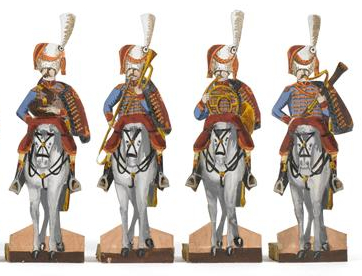
1826—A drawing by George Scharf features military musicians playing various instruments, including both serpent and trombone. The writing below the drawing reads, “At the Marine Officers Mess Room, at Woolwich, during Dinner” (see below image; public domain) (British Museum).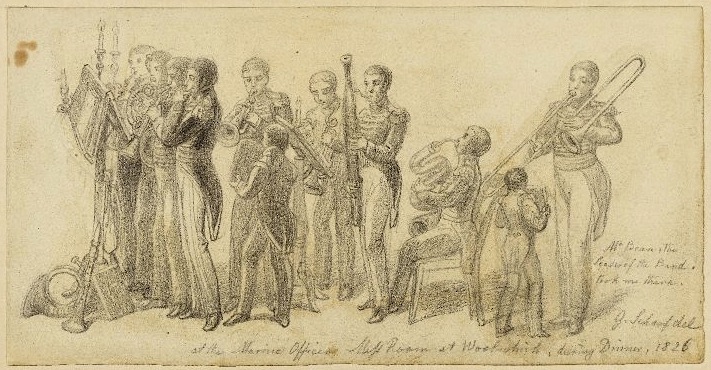
1828—Great Britain: A military image features a British serpent player in full military garb (see below image; public domain) (New York Public Library Digital Gallery).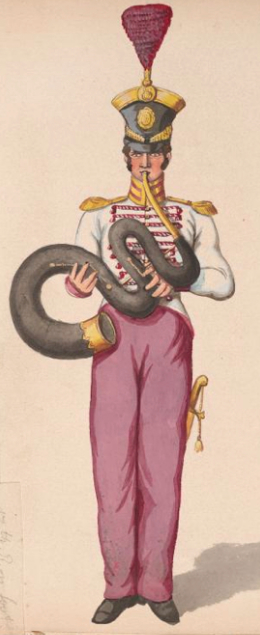
c. 1829—Mainz, Germany: Artist Joseph Scholz depicts a group of 4 military musicians of the Prussian Army on horseback in an image titled Preussisches Heer–Garde Artillerie (see below image; public domain) (Ryan, Paper Soldiers).
c. 1830—Vienna, Austria: K.k. Österreichischer Militair Leichen-Conduct, lithograph no. 8 from a series edited by Michael Tretsentsky, shows a military band that includes multiple ophicleides (see below image; public domain) (Pirker).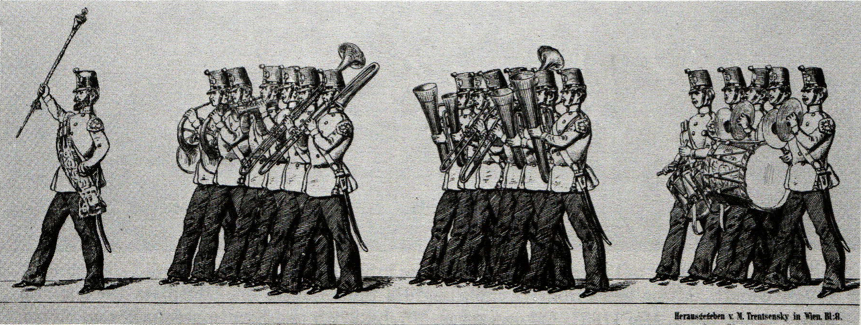
1830—France: Garde Imperiale: Regiments des Grenadiers a pieds, an image created by G. David in 1830 but meant to depict 1804, includes a military serpent player (see below image; public domain).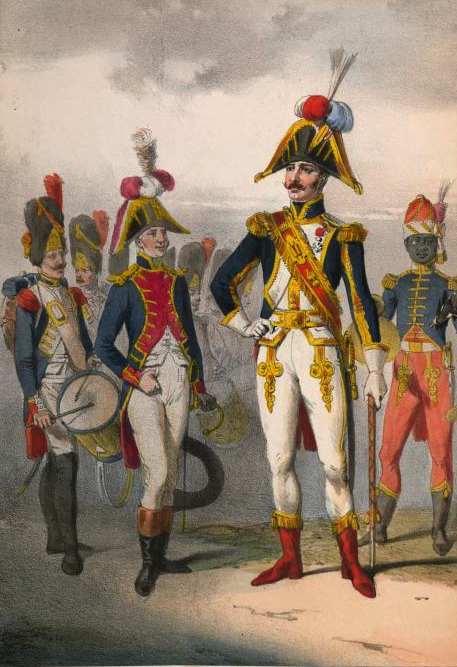
1831-1870—Paris, France: Regiment d’Infanterie de Ligne, a print published by Fournier, features a serpent with a zoomorphic bell (see detail and full image below; public domain) (Ryan 121).
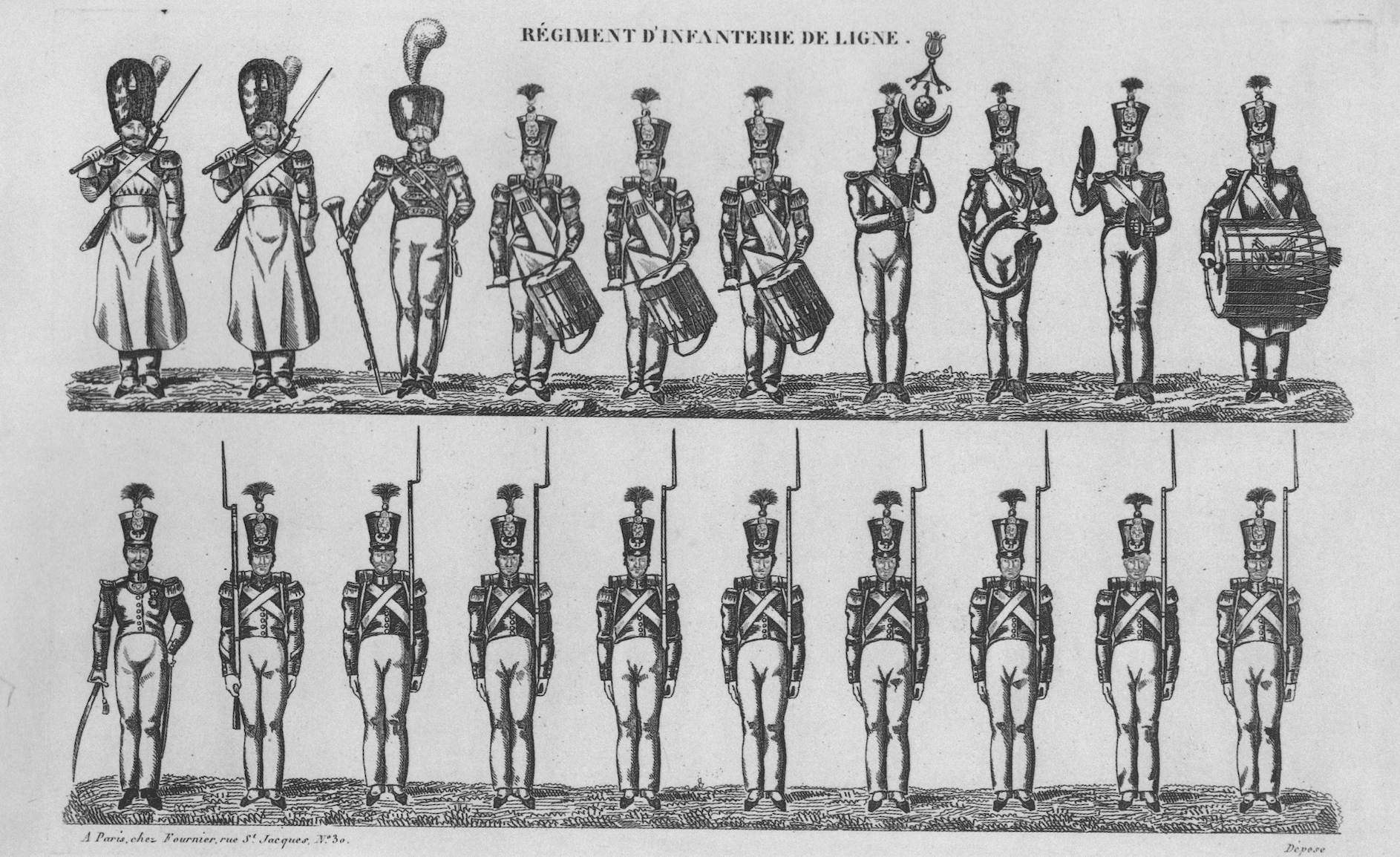
1833-1900—Turnhout, Belgium: A catchpenny print entitled Harmonie, probably published by Glenisson and Van Genechten, features musicians playing various instruments, including an ophicleide (see below detail; public domain) (Catchpenny Prints of the Dutch Royal Library).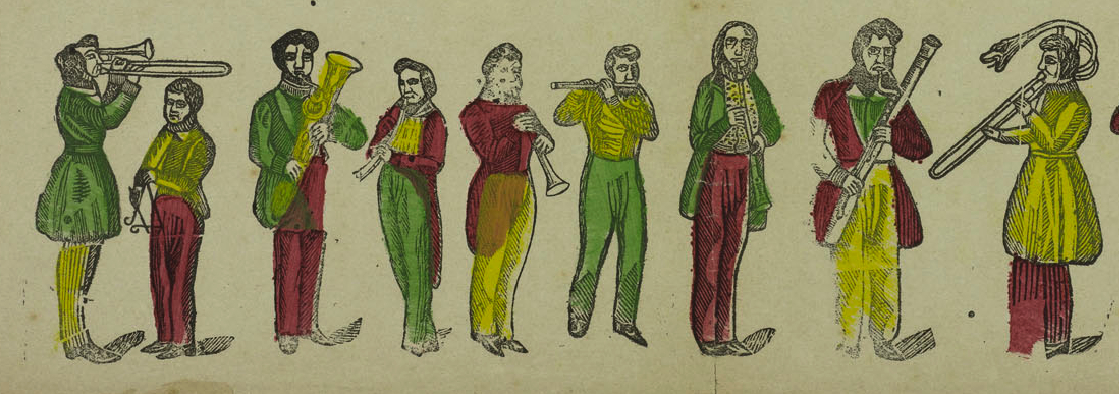
c. 1835—Paris, France: Un Serpent de Paroisse (a parish serpent), a satirical lithograph by Delaunois, is published in a Paris periodical (see below image; public domain) (source: Douglas Yeo, personal communication).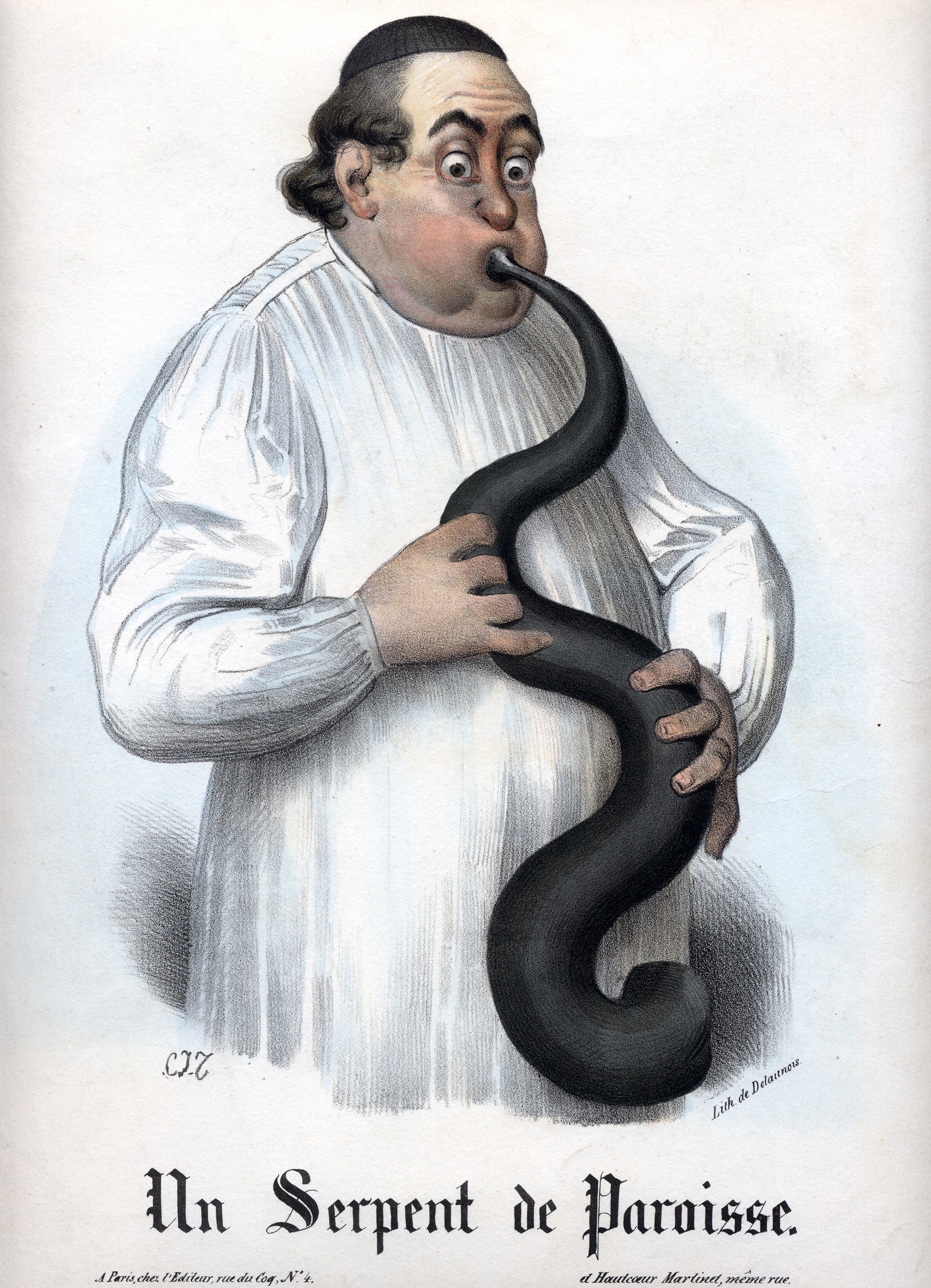
c. 1835—France: Victor Cornette writes his Methode d’Ophycleide Alto et Basse. It includes a print signed by V. Bretonnierie (dated 1835) and a fingering chart (see below 2 images; public domain).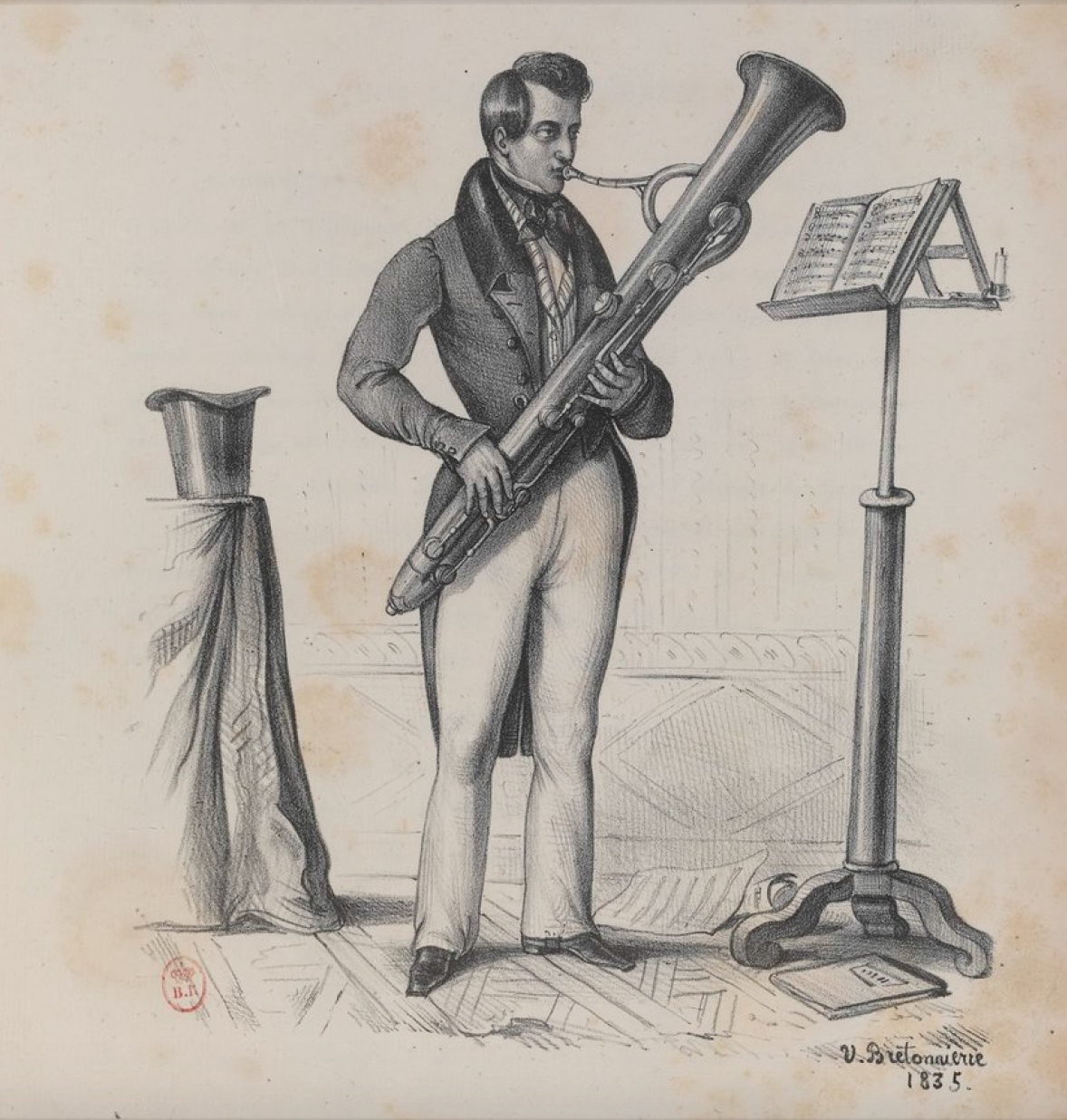
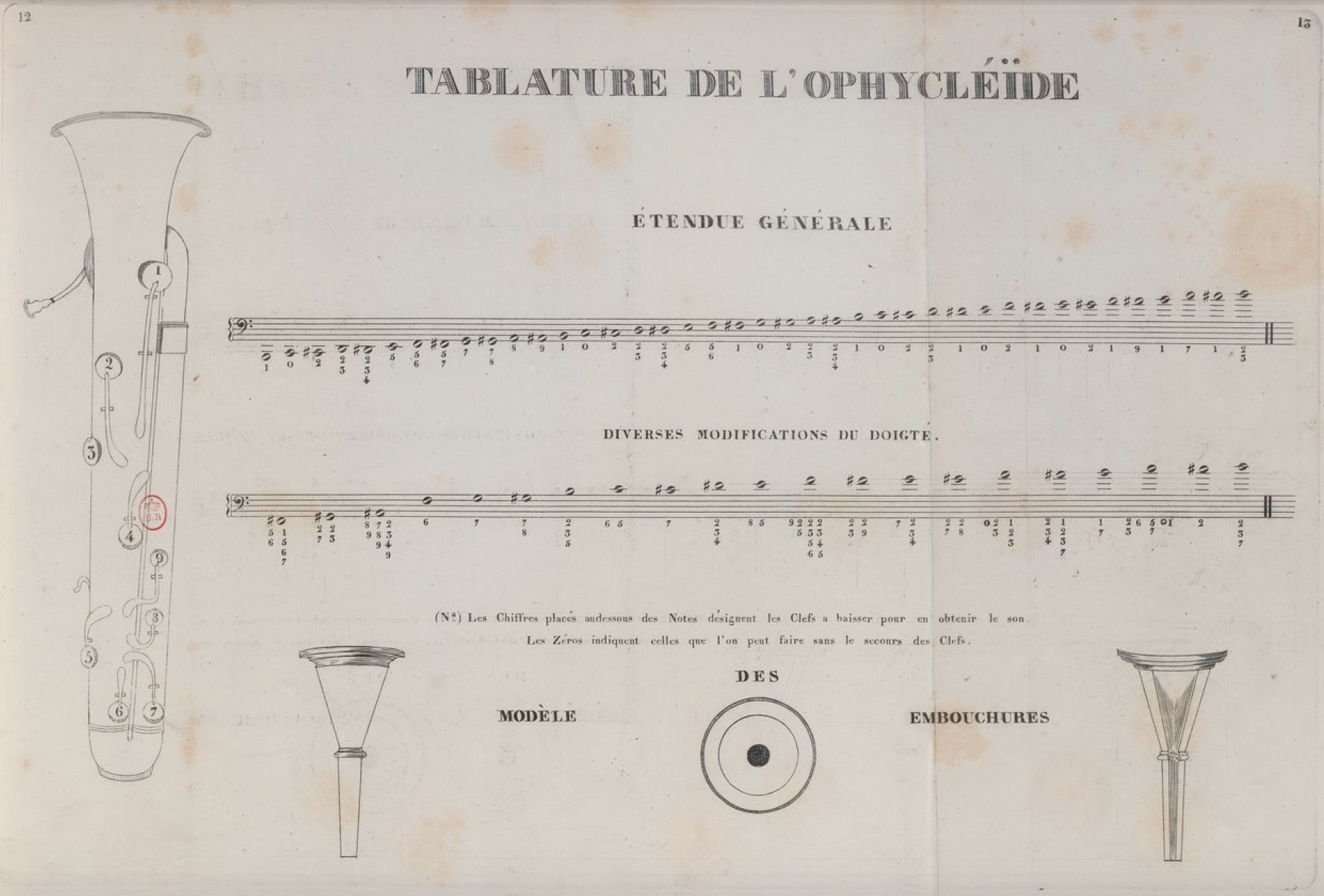
1840—Epinal, France: An engraving entitled Musique d’Amateurs, published by Pellerin, includes an ophicleide among 27 figures with various musical instruments (see below image; click picture for larger version; public domain).
c. 1840—Paris, France: Félix Vobaron’s New Method for Bass Ophicleide includes the below depiction of a military band featuring an ophicleide in the foreground with what may be another ophicleide in the background (far left) (see below image; public domain).
1841—Paris, France: Sistermann’s ophicleide method, Nouvelle méthode d’ophicléide, is published by Joly (see cover and fingering chart, below; public domain) (source: French National Library).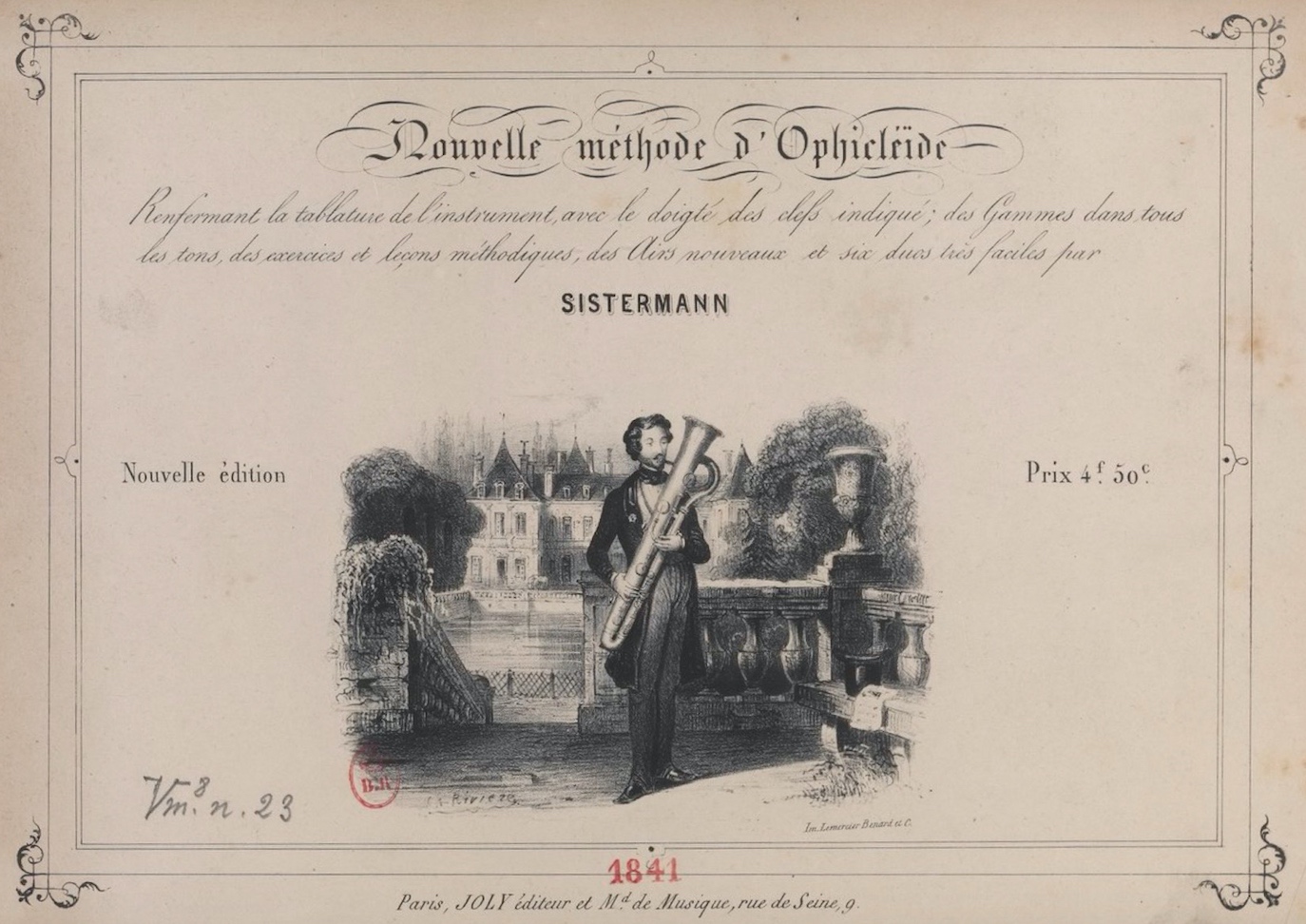
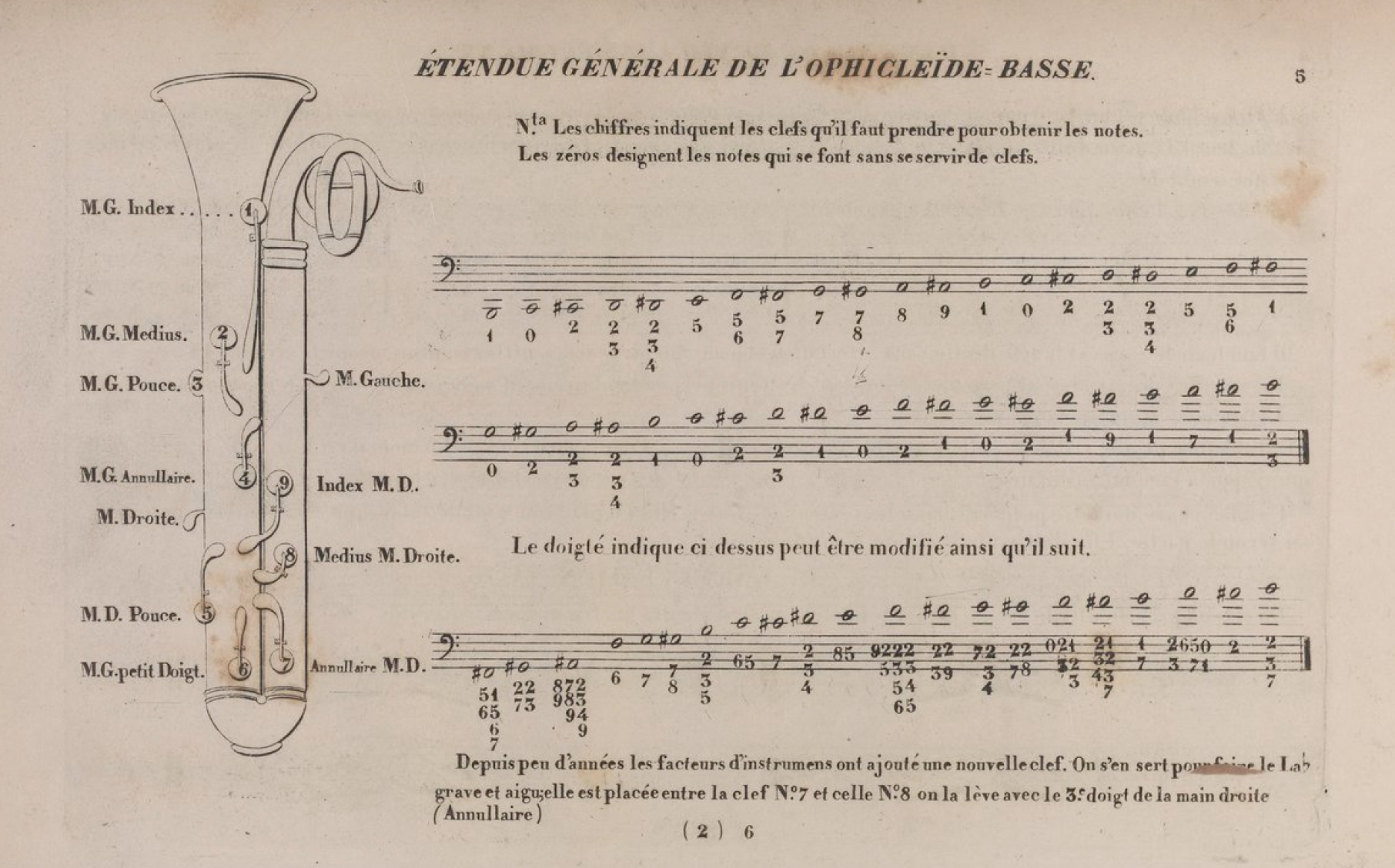
1842—Mannheim, Germany: Berlioz, on a tour of Germany, visits Mannheim, where he uses a valve trombone as a substitute for ophicleide: “There is no ophicleide; Lachner [the regular conductor] had attempted to devise a substitute for this instrument, which is used in all modern scores, by having a valve trombone made with a compass extending to bottom C or B. In my opinion it would have been simpler to send for an ophicleide and much better from the musical point of view, as the two instruments have little in common” (Berlioz-Cairns 288).
1842—Leipzig, Germany: Berlioz, on a tour of Germany, visits Liepzig. He reports in his Memoirs that “the ophicleide, or rather the meager brass object masquerading under that name, bore no resemblance to the French variety, having practically no tone,” so it was “replaced, after a fashion, by a fourth trombone” (Berlioz-Cairns 300).
1843—France: A depiction of a theatre orchestra includes what may be an ophicleide. The image is printed in “La Parodie de la Vestale,” Chants et Chansons Populaires de la France II, 1843 (see below image; public domain) (London, British Library; Remnant, Musical Instruments of the West 216).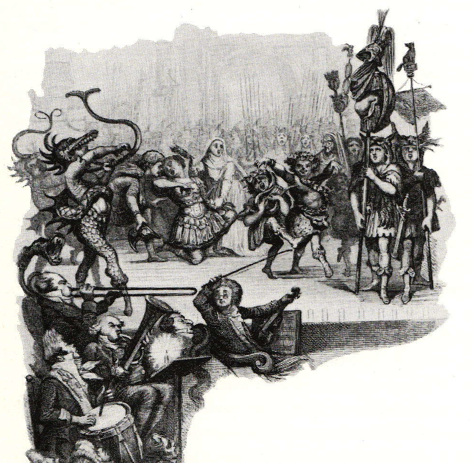 1843—Berlin, Germany: Hector Berlioz visits Berlin, where he hears 2 bass trombones in the opera orchestra. Complaining that there are none in Paris, he says, “Parisian musicians refuse to play an instrument that is so tiring to the chest. Prussian lungs are evidently more robust than ours.” He is not, however, impressed with the balance of the trombone section there; he reports: “Their combined volume of tone is so great as to obliterate the alto and tenor trombones playing the two upper parts. The aggressive tone of one bass trombone would be enough to upset the balance of the three trombone parts as written by composers nowadays. But there being no ophicleide at the Berlin Opera, they give the part to a second bass trombone. The effect of having two of these formidable instruments one above the other (the ophicleide part being frequently written an octave below the third trombone) is disastrous. You hear nothing but the bottom line; even the trumpets are all but drowned. When I came to give my concerts I found that the bass trombone was much too prominent—although in the symphonies I was using only one—and had to ask the player to sit so that the bell of the instrument was facing into his stand, which acted as a sort of mute, while the alto and tenor trombonists stood up to play with their bells pointing over the top of their stands. Only in this way could all three parts be heard” (Macdonald 213).
1843—Berlin, Germany: Hector Berlioz visits Berlin, where he hears 2 bass trombones in the opera orchestra. Complaining that there are none in Paris, he says, “Parisian musicians refuse to play an instrument that is so tiring to the chest. Prussian lungs are evidently more robust than ours.” He is not, however, impressed with the balance of the trombone section there; he reports: “Their combined volume of tone is so great as to obliterate the alto and tenor trombones playing the two upper parts. The aggressive tone of one bass trombone would be enough to upset the balance of the three trombone parts as written by composers nowadays. But there being no ophicleide at the Berlin Opera, they give the part to a second bass trombone. The effect of having two of these formidable instruments one above the other (the ophicleide part being frequently written an octave below the third trombone) is disastrous. You hear nothing but the bottom line; even the trumpets are all but drowned. When I came to give my concerts I found that the bass trombone was much too prominent—although in the symphonies I was using only one—and had to ask the player to sit so that the bell of the instrument was facing into his stand, which acted as a sort of mute, while the alto and tenor trombonists stood up to play with their bells pointing over the top of their stands. Only in this way could all three parts be heard” (Macdonald 213).
1843—London, England: A cartoon in Punch magazine featuring an enormous ophicleide accompanies the complaint, “The ophycliedes [sic] get bigger and bigger each day, and it is impossible to tell at what pitch of monstrous magnitude they will ultimately arrive. We shall not be surprised if they finally form the abodes of the men who play them: an accommodation which will be very valuable to perambulating musicians at the seasons of the various Festivals” (see below image; public domain) (vol. IV, p. 235).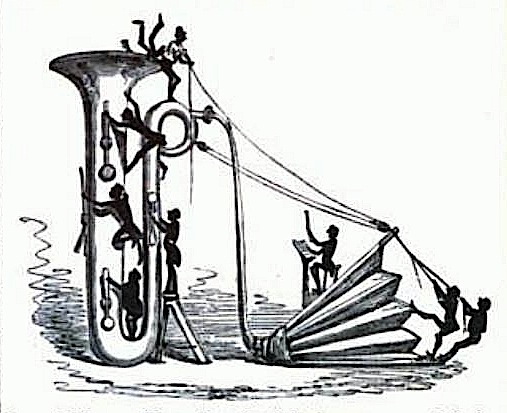 1844—A depiction of Prospere (Jean Prospere Guivier), one of the great ophicleide players of the 19th century, shows him playing a “monster” ophicleide at Hanover Square Rooms. It is later reprinted in the Musical Times in June, 1894 (see below image; public domain).
1844—A depiction of Prospere (Jean Prospere Guivier), one of the great ophicleide players of the 19th century, shows him playing a “monster” ophicleide at Hanover Square Rooms. It is later reprinted in the Musical Times in June, 1894 (see below image; public domain).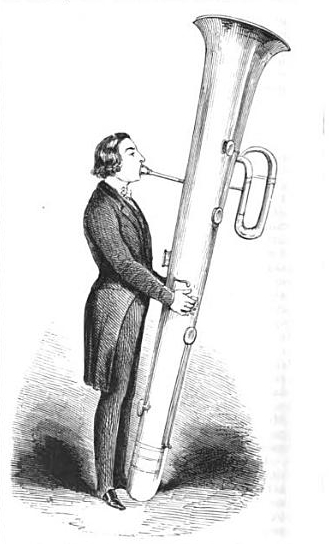 1844—Boston, Massachusetts: Simon Knaebel publishes brass quartet arrangements for 2 bugles in B-flat, trombone, and ophicleide in Keith’s Collection of Instrumental Music (Dudgeon, Keyed Bugle 173).
1844—Boston, Massachusetts: Simon Knaebel publishes brass quartet arrangements for 2 bugles in B-flat, trombone, and ophicleide in Keith’s Collection of Instrumental Music (Dudgeon, Keyed Bugle 173).
1844—Milan, Italy: Fermo Bellini’s Teoriche musicali discusses the use of trombone with ophicleide: “The modern custom, adopted by some composers, of forming a quartet consisting of three trombones and an ophicleide does not seem very sensible, given that the tone colour of the trombones, so dominant and in high relief, is very different from that of the ophicleide; it would be better for this instrument to double the bottom line, or else to find some way to give the trombones a good cantabile bass whenever they are on their own” (Meucci).
1844—France: An illustration by J. J. Grandville in Un autre Monde depicts an ophicleide gone awry, as described by Grandville: “An accident marked the end of the concert. During the fireworks in D, where the fugue ended smorzando in a sweet and dreamy melody, an ophicleide, overloaded with harmony, suddenly exploded like a bomb, launching the blacks, the whites, the grupetti of sharps, eight- and sixteenth notes; the clouds of musical smoke and the flames of melody were dispersed into the air. Many dilettantes had their ears blown out, while others were injured by the shrapnel of the F and G clefs. Measures have been take to ensure that such an accident does not happen again” (see below image; public domain).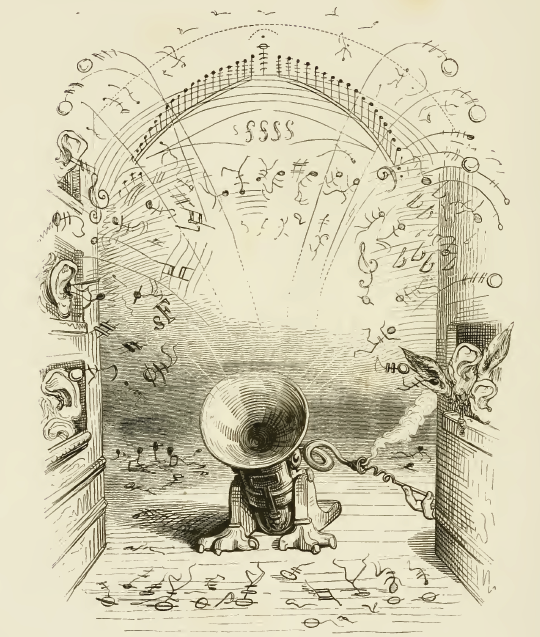
1844—France: Another illustration by J. J. Grandville in Un autre Monde depicts a Concert of Steam (Concert a la vapeur) in response to a prediction about steam changing the world. Included in the “steam orchestra” is an ophicleide (see below image; public domain) (Fromrich 133).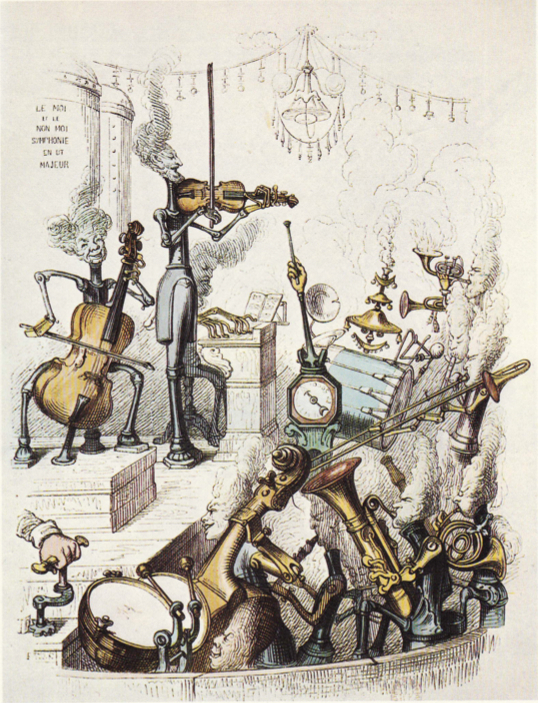
1844-50—Boucherville, Québec, Canada: Interior decorations by Louis-Thomas Berlinguet and his son Louis-Favien in Église Sainte-Famille (Church of the Holy Family) include 2 different depictions of serpents, both set in trophies, or decorative clusters of instruments (see below image; special thanks to Maximilien Brisson).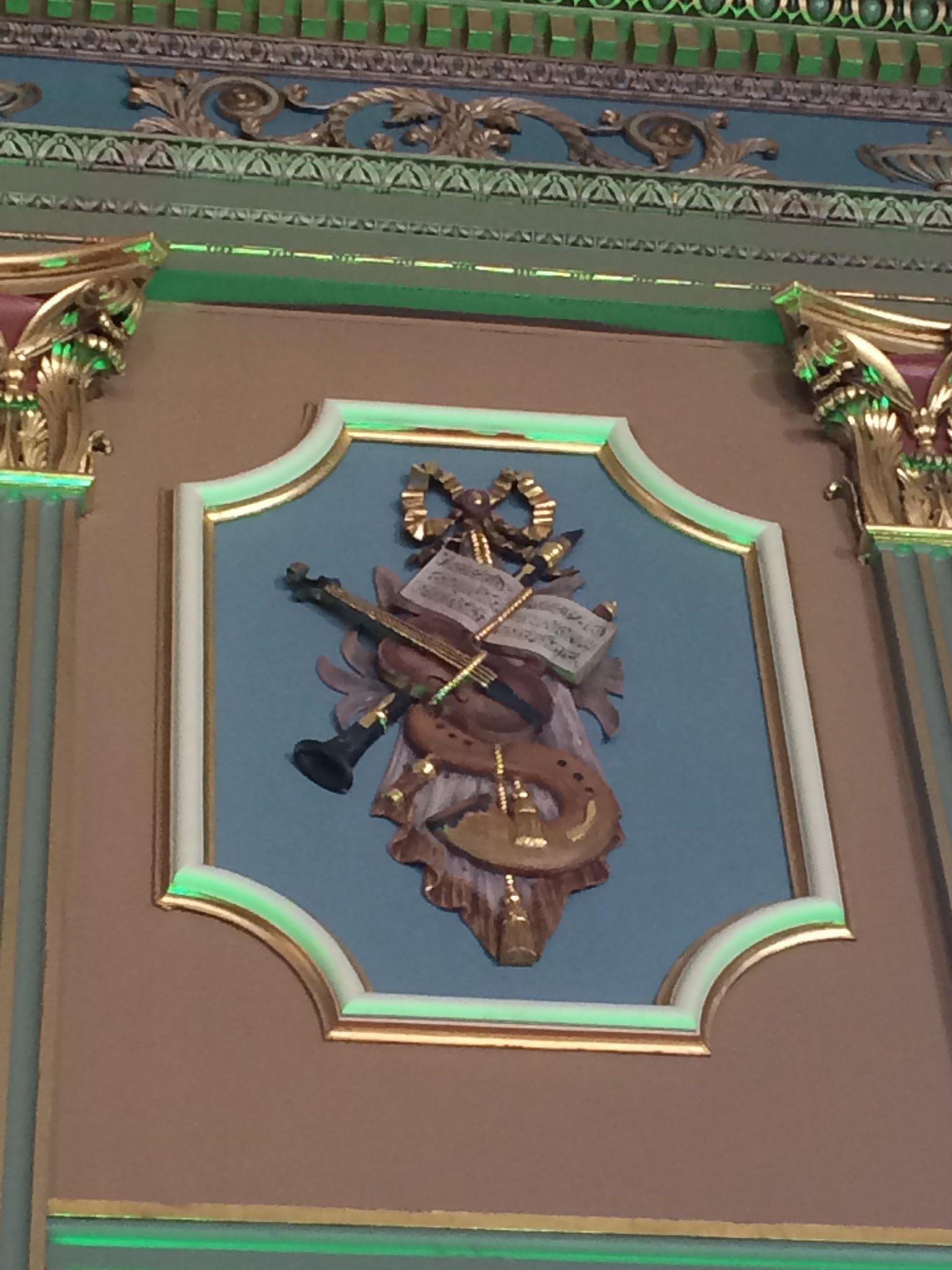
c. 1845—Paris, France: An illustration by Charles Vernier, Uniforms of the French Army, Musicians, features numerous military musicians, including a soldier with what appears to be an ophicleide (see below image; public domain) (Mardaga 119).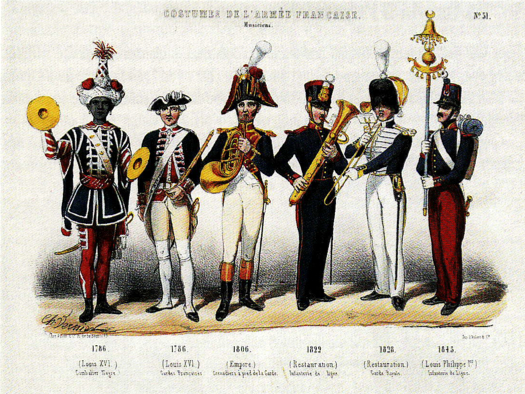
1846—A concert poster for “Adams’ Brass Band attached to the ‘Rochester Union Grays'” indicates two different ophicleide solos (see below image; public domain).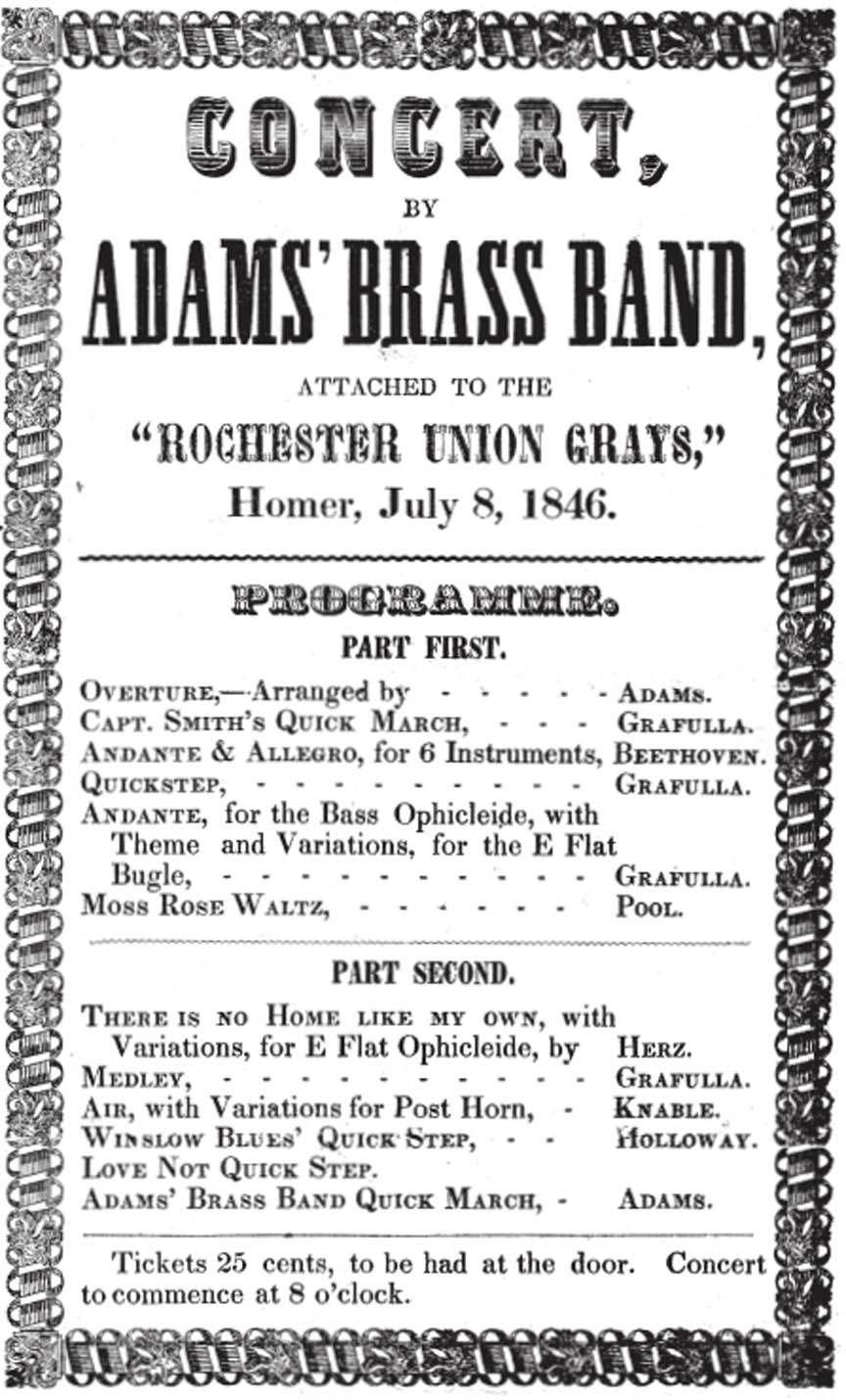
1846—London, England: “A Sunday Band of Hope,” a brief article in Punch magazine about bands playing on Sunday, includes a graphic of a bandsman sitting down by his ophicleide for a drink (see below image; public domain) (p. 189).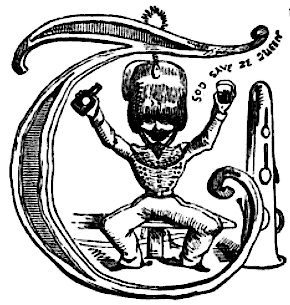
1846—Paris, France: A caricature by J.J. Grandville depicts Berlioz conducting a monstrous orchestra that includes a giant ophicleide (see below image; public domain) (source: wikimedia commons). The original version of the image, published in a Paris newspaper in 1845, was black and white and did not include the large ophicleide on the top-right. The version below was published in Louis Reybaud’s novel, Jérome Paturot a la recherche d’une position sociale, with a caption reading, “Fortunately the hall is solid…it can handle the strain.”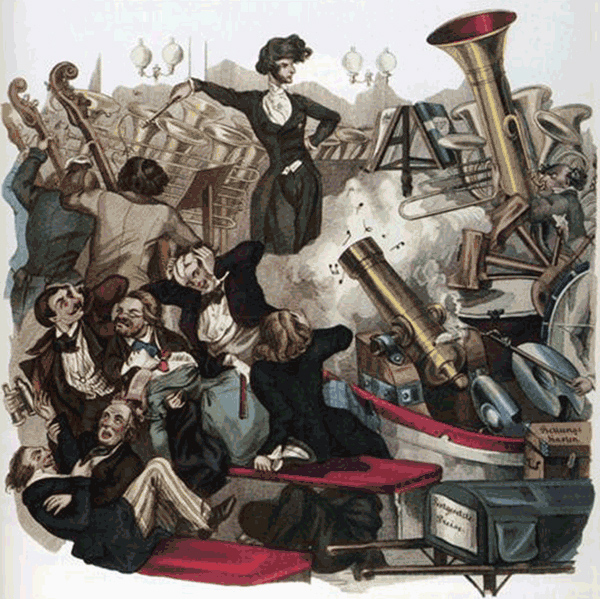
1847—France: A print depicting a religious procession (Procession of the Virgin) features an an ophicleide as the only instrumentalist (see bottom-left of below image; public domain) (Paris, Museum of European and Mediterranean Civilization).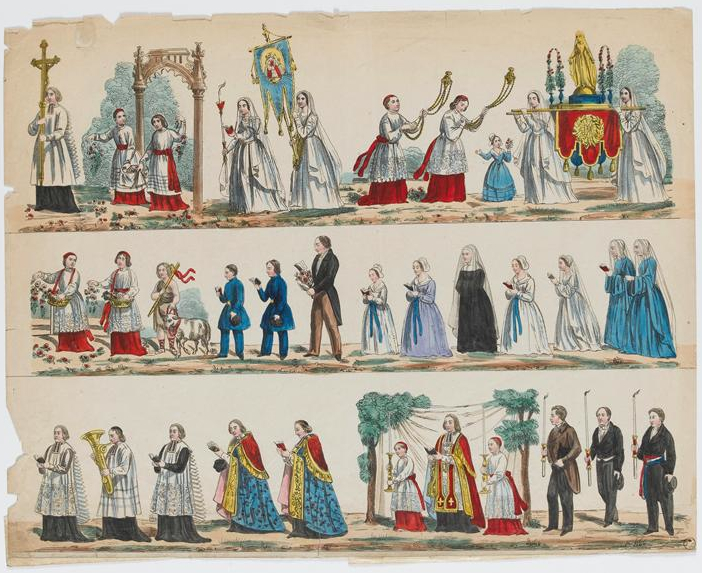 1847—Paris, France: Eugene-Hippolyte Forest’s satirical print, The Conservatoire, Classe d’Ophicléide, is published in Paris Musical. The subtitle reads “Court of the Tiny Ones–Section of the Prodigies” (see below image; public domain) (Fromrich, 139).
1847—Paris, France: Eugene-Hippolyte Forest’s satirical print, The Conservatoire, Classe d’Ophicléide, is published in Paris Musical. The subtitle reads “Court of the Tiny Ones–Section of the Prodigies” (see below image; public domain) (Fromrich, 139). 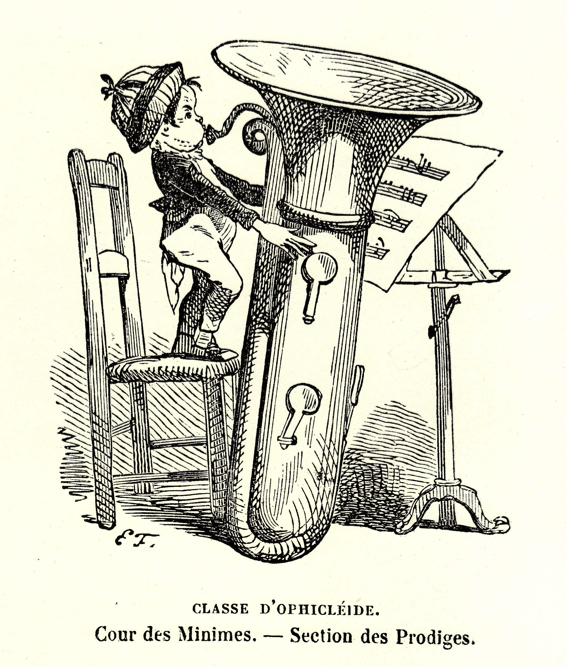
1848—London, England: A cartoon published in Punch magazine includes an ophicleide among members of a band marching in the street (see below image, click to expand; public domain) (vol. XIV, p. 236).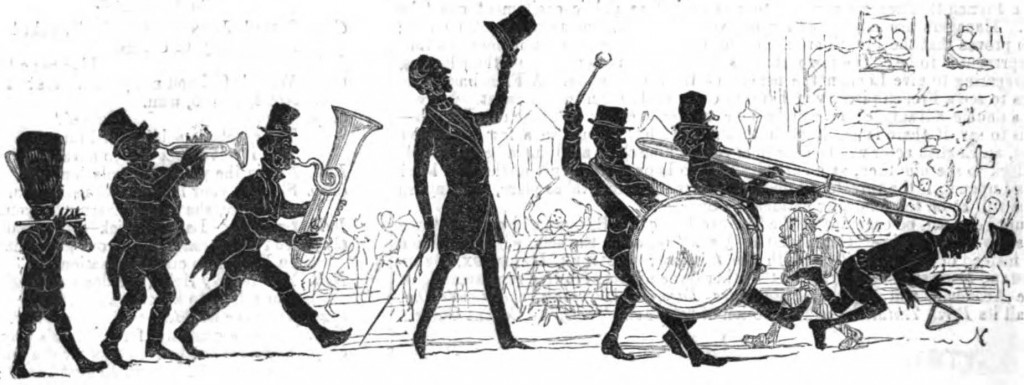
1848—Paris, France: Georges Kastner’s treatise on military music, Manuel Général de Musique Militaire, includes a page illustrating serpents and related instruments (see Kastner’s labels at the bottom of the image) used in military music (see below image; public domain) (Kastner, Militaire Pl. XVIII).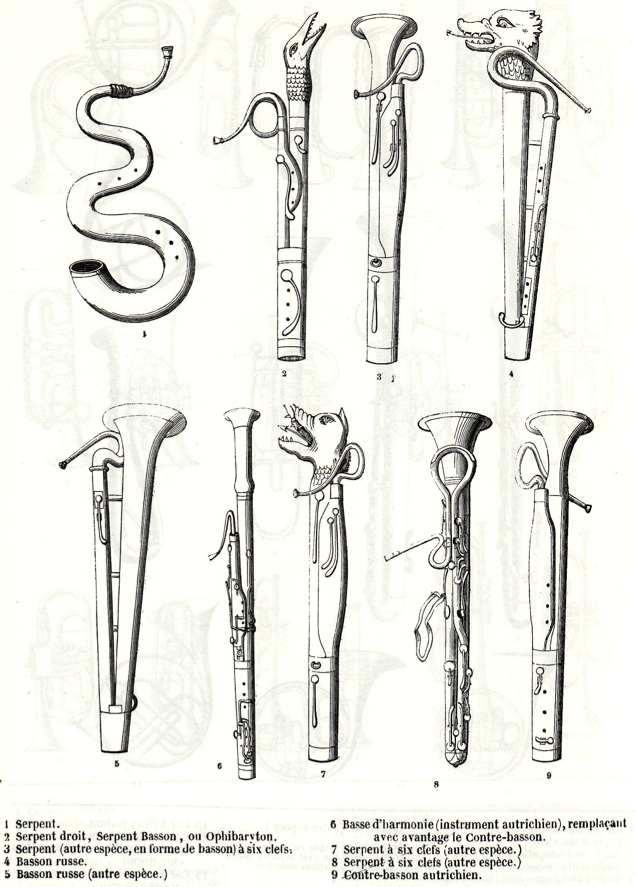 1848—Paris, France: Georges Kastner’s treatise on military music, Manuel Général de Musique Militaire, includes images of a pair of ophicleides used in military music (see below image; public domain) (Kastner, Militaire Pl. XVII).
1848—Paris, France: Georges Kastner’s treatise on military music, Manuel Général de Musique Militaire, includes images of a pair of ophicleides used in military music (see below image; public domain) (Kastner, Militaire Pl. XVII).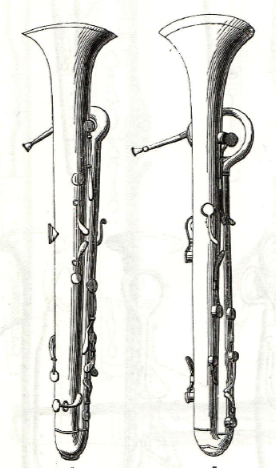
1849—London: England: Ye Brytysh Granadiers a Mountynge Guard at St. James Hys Palace Yarde, one of 40 satirical drawings from Richard Doyle’s Manners and Customs of Ye Englyshe in 1849, published in Punch magazine, includes an ophicleide in a marching band (see below image; public domain) (August 1, p. 43).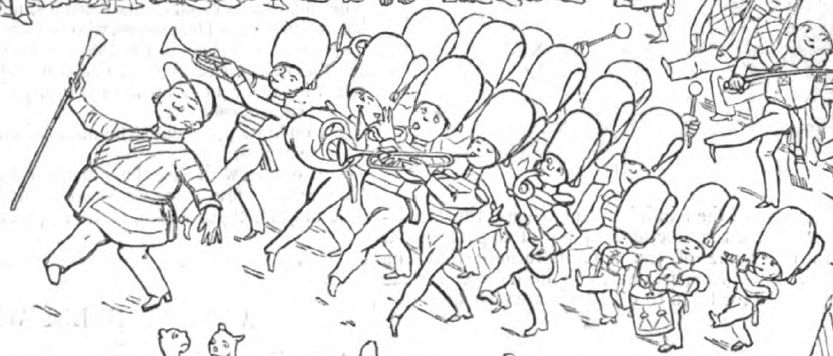
1849—London: England: A Promenade Concerte, one of 40 satirical drawings from Richard Doyle’s Manners and Customs of Ye Englyshe in 1849, depicts a large orchestra that includes at least 2 ophicleides (see below image; public domain) (Doyle pl. 40).
c. 1850—Strasbourg, France: Rod Nicker publishes an illustration of an infantry band and sapeurs that includes two ophicleide players (see detail and full image below; public domain) (Ryan 25).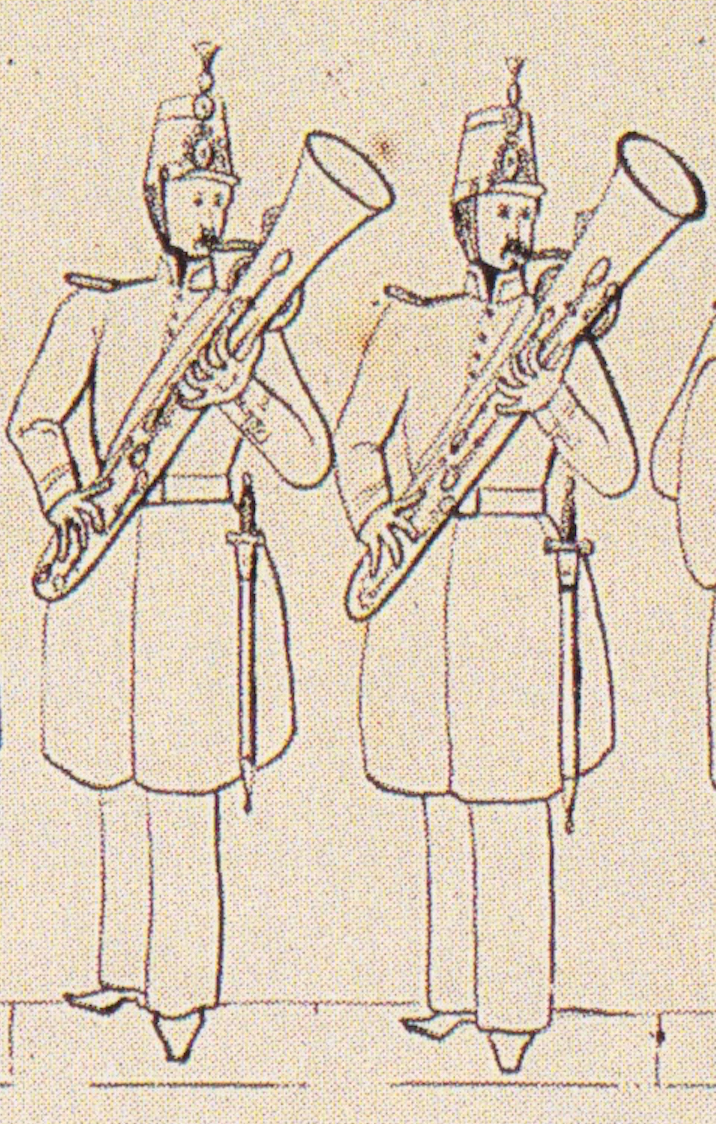
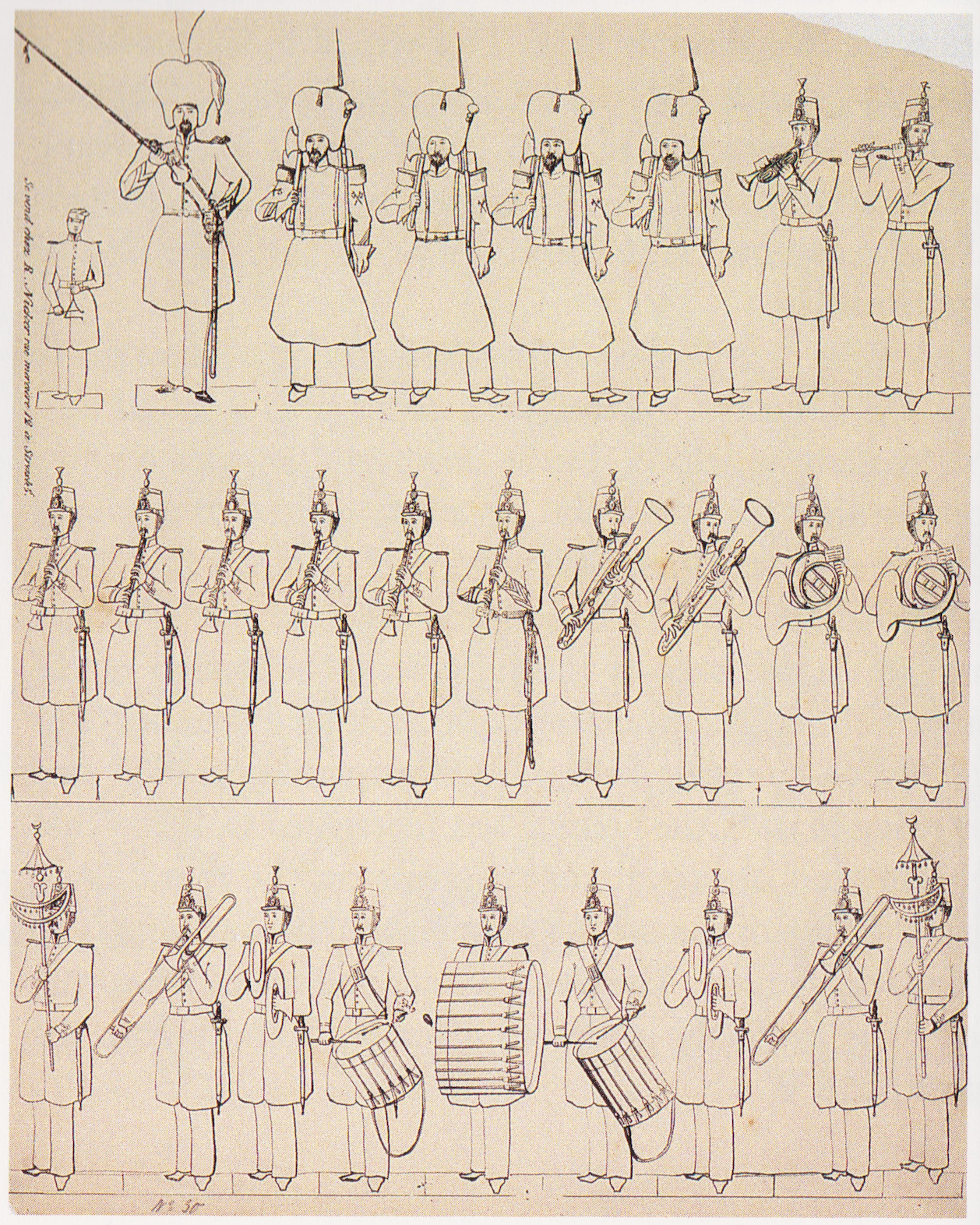
c. 1850—Paris, France: A humorous lithograph by artist Charles Edouard de Beaumont, printed by Aubert, shows a somewhat shabby-looking man with a serpent approaching two women. The caption beneath indicates one of the women saying “Clarisse, beware…the serpent!” (see below image; public domain) (source: Museum of Musical Instruments).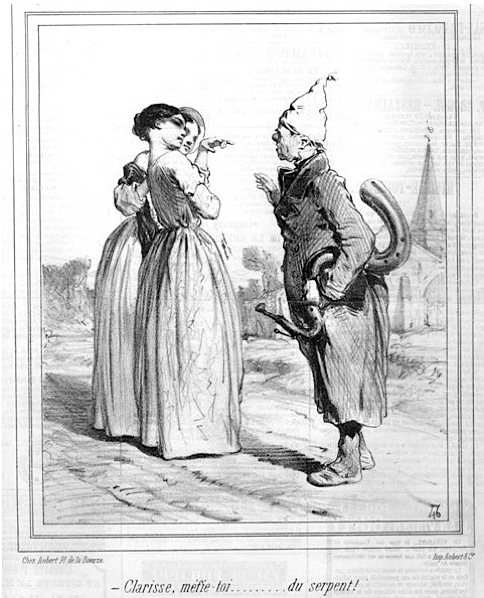
mid-19th century—Paris, France: Alphonse Leduc publishes Le Serpent du Village, a work for serpent or ophicleide and voice by A. Pilati (words by J.B. Vasseur). See below image (public domain).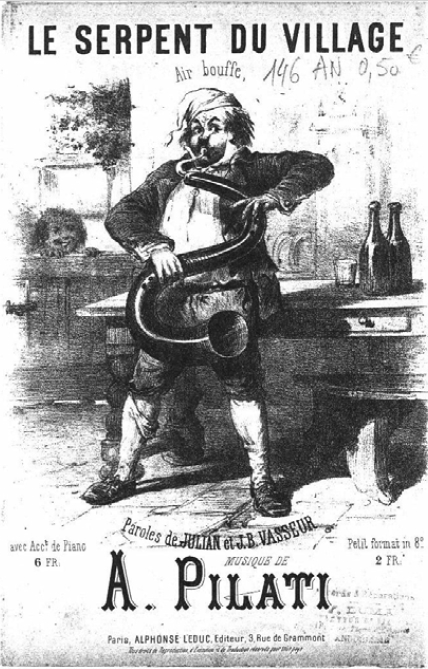 mid-19th century—Brussels, Belgium: A catchpenny print entitled Afbeeldingen van soldaten (Images of Soldiers), produced by Hemeleers-Van Houter, includes a musician playing serpent (see below detail; public domain) (Catchpenny Prints of the Dutch Royal Library).
mid-19th century—Brussels, Belgium: A catchpenny print entitled Afbeeldingen van soldaten (Images of Soldiers), produced by Hemeleers-Van Houter, includes a musician playing serpent (see below detail; public domain) (Catchpenny Prints of the Dutch Royal Library).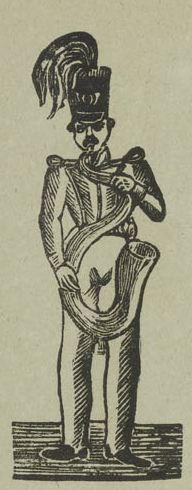
1850—An illustration features an ophicleide player from the Coldstream Guards Band in full uniform (see below image; public domain).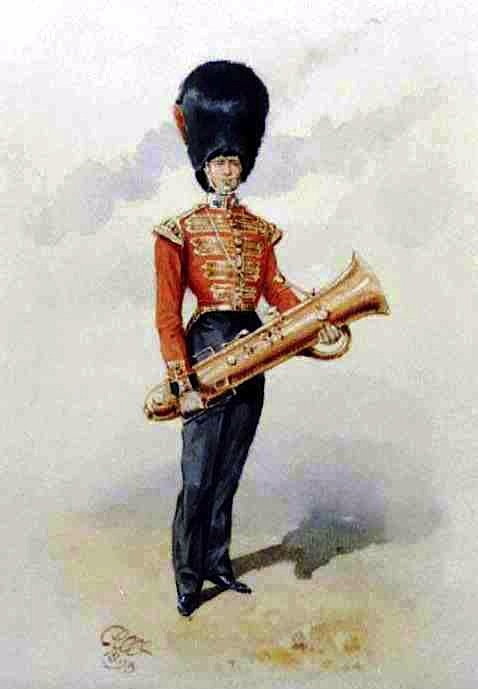
1850—Paris, France: The illustrated newspaper L’Illustration publishes a caricature of a religious scene featuring a serpent player accompanying a small group of vocalists (see below image; public domain) (March 30, 1850, p. 205).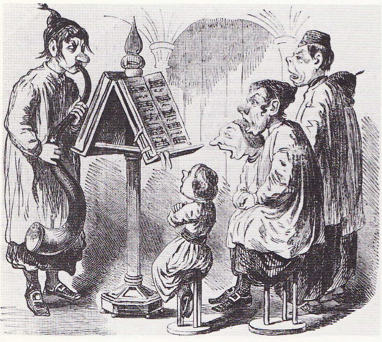
1850-1875—France: Musique d’infanterie française, a color lithograph printed by Pellerin, includes 3 ophicleide players among the infantry musicians (see below image–click picture for larger version; public domain) (Paris, Museum of European and Mediterranean Civilization).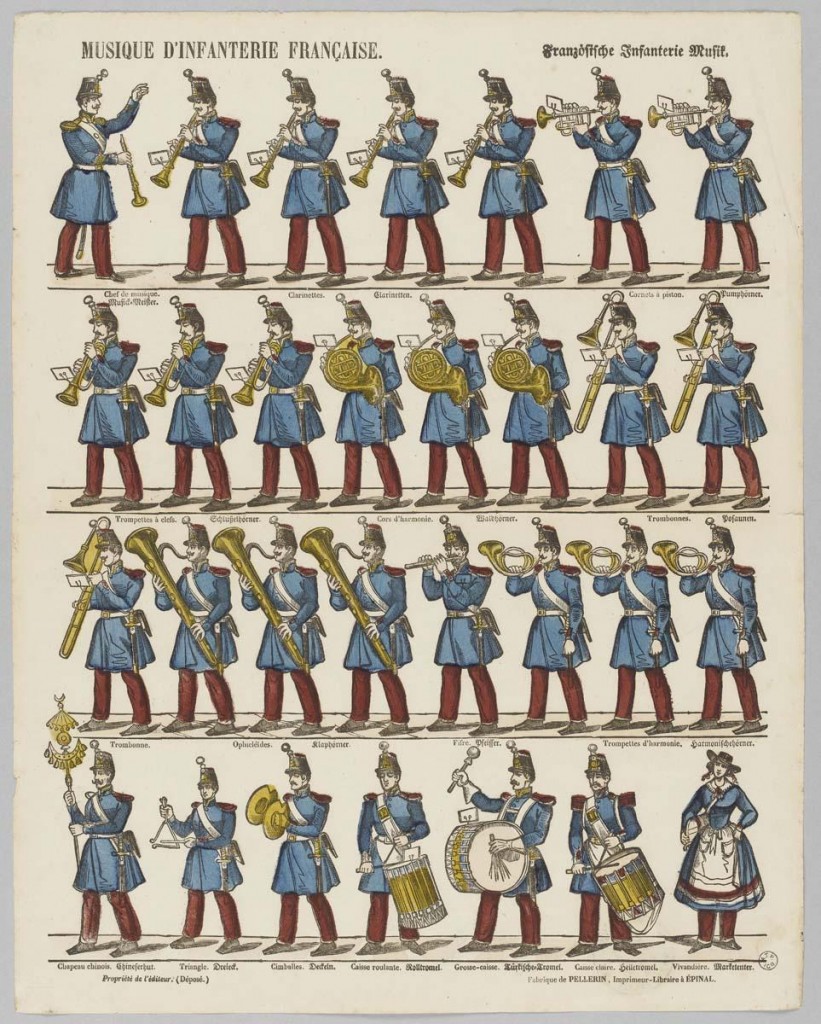
1850-1875—France: Musique d’infanterie française, a color lithograph printed by Pellerin, includes a pair of ophicleide players among the infantry musicians (see below detail, click picture for larger version; public domain) (Paris, Museum of European and Mediterranean Civilization).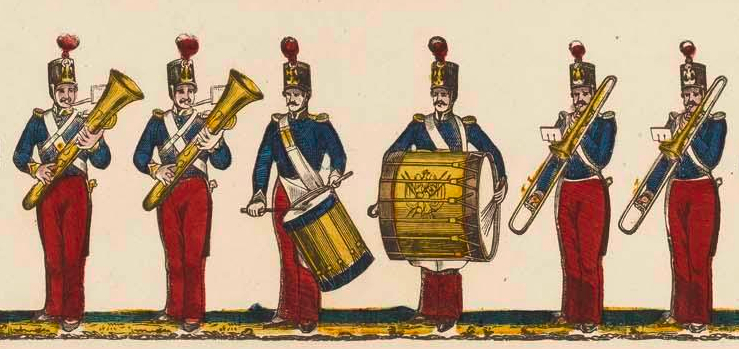
1851—An illustration of a British infantry band by Ebsworth includes both a serpent and an ophicleide (see below image; public domain).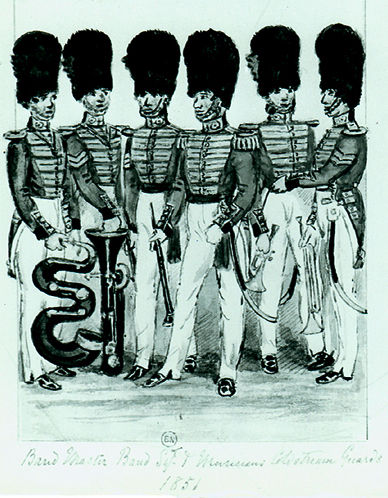 1853—London, England: H.G. Hine’s The Waits at Seven Dials portrays a group of “Christmas waits” or street musicians, including what may be an ophicleide. After the Municipal Corporations Act of 1835, there were no more official waits as funded by British municipalities, but ad hoc musicians would often form at Christmas time in hopes of raising money (see below image; public domain) (Illustrated London News, December 1853).
1853—London, England: H.G. Hine’s The Waits at Seven Dials portrays a group of “Christmas waits” or street musicians, including what may be an ophicleide. After the Municipal Corporations Act of 1835, there were no more official waits as funded by British municipalities, but ad hoc musicians would often form at Christmas time in hopes of raising money (see below image; public domain) (Illustrated London News, December 1853).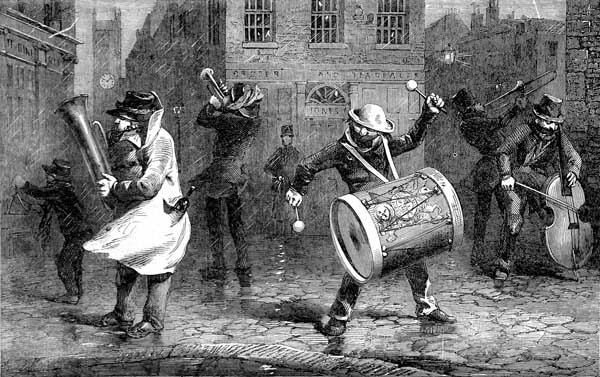 1854—France: A watercolor by Lhéritier titled L’amour dans un ophicléide depicts a man in military garb playing ophicleide (see below image; public domain).
1854—France: A watercolor by Lhéritier titled L’amour dans un ophicléide depicts a man in military garb playing ophicleide (see below image; public domain).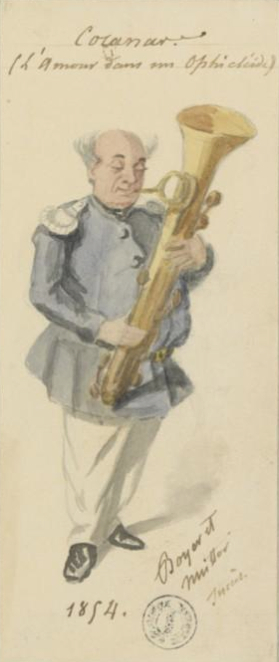
1855—Paris, France: Henri C. de Ploosen’s ophicleide method book, Nouvelle méthode d’ophicléide, is published. In addition to the image on the cover, a separate page features images diagramming the ophicleide and mouthpiece (see below images; public domain) (Ploosen cover and 5).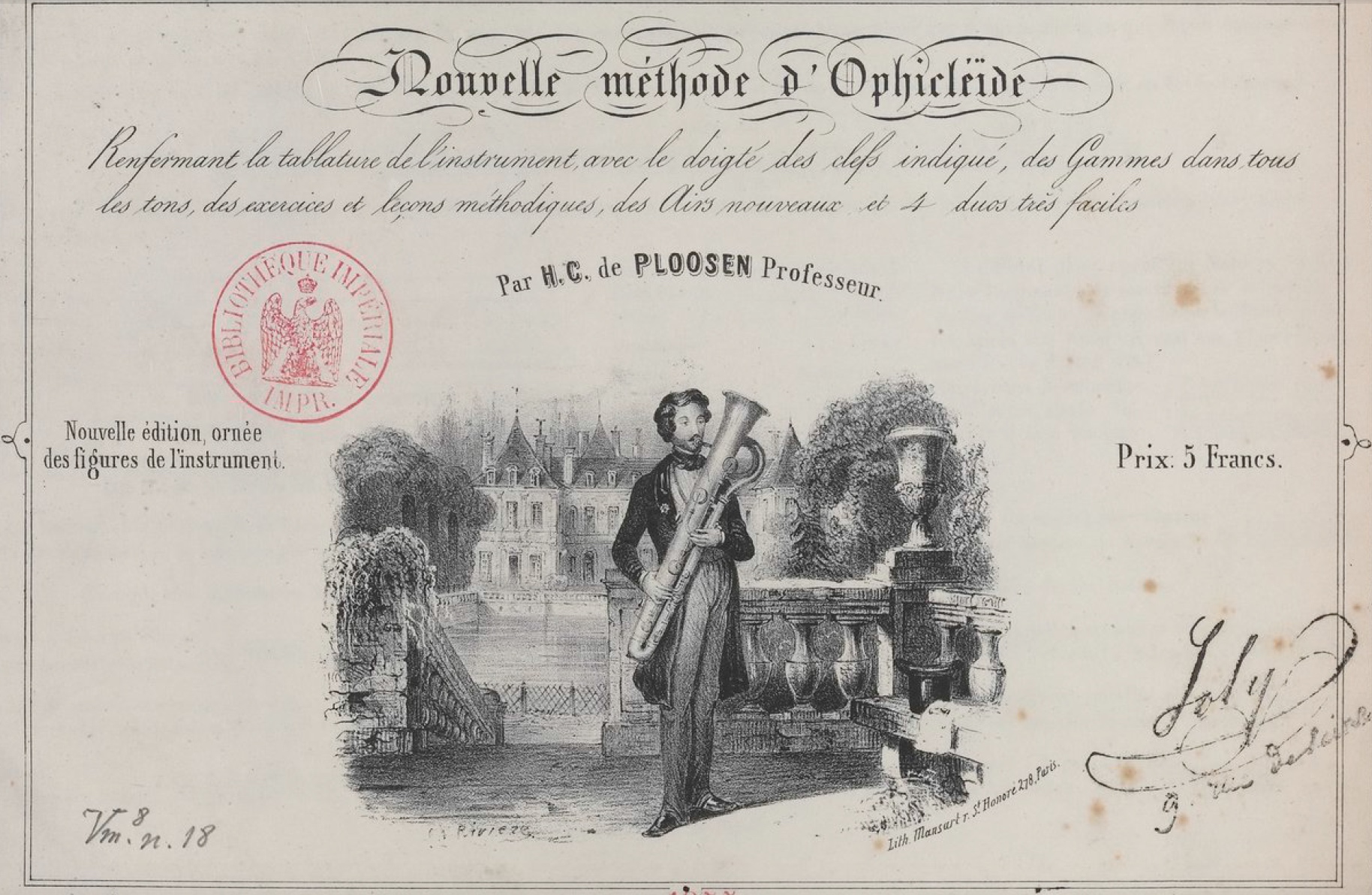
1855—New York: An illustration by Theodore Benecke titled Sleighing in New York includes a portrayal of a band performing from the balcony of Barnum’s Museum. One of the instruments appears to be an ophicleide (see below detail; public domain) (New York Public Library, Eno Collection of City Views; Bowles, Timpani 295).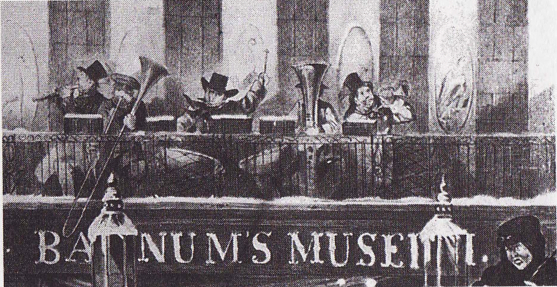
1857—Paris, France: Godefroy Durand’s Fête du pont du Gard: L’orchestre features a dance band that includes ophicleide (see below image; public domain) (L’Illustration, June 6, 1857, p. 356).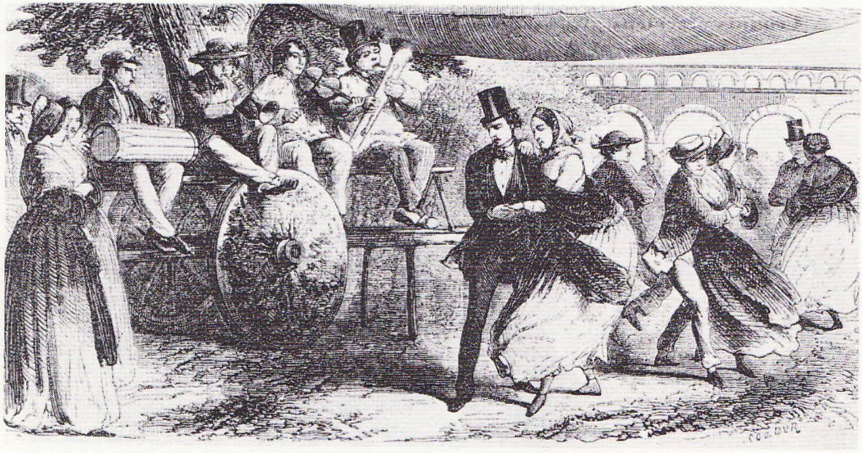
1857—Paris, France: The periodical L’Illustration prints a depiction of a military theatre with an orchestra that includes ophicleide (see below image; public domain) (September 5, 1857, p. 159).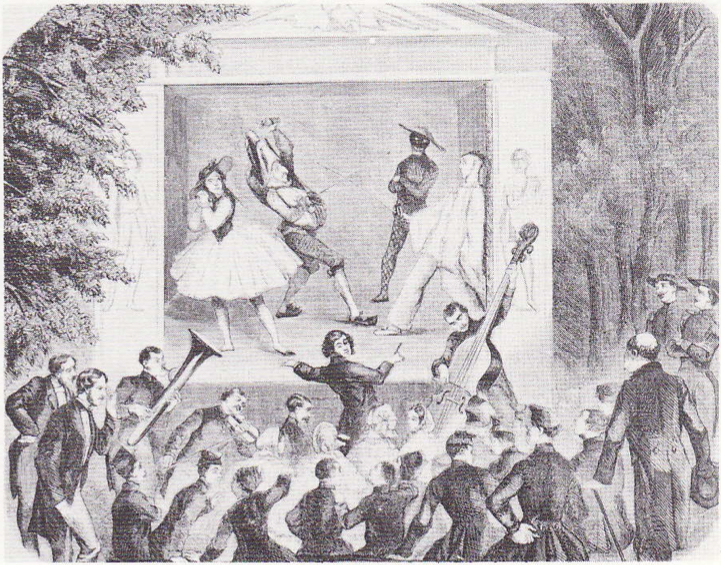
1858—London, England: An illustration of the band of the French National Guard published in London’s Illustrated Times includes what appears to be an ophicleide (see below image; public domain).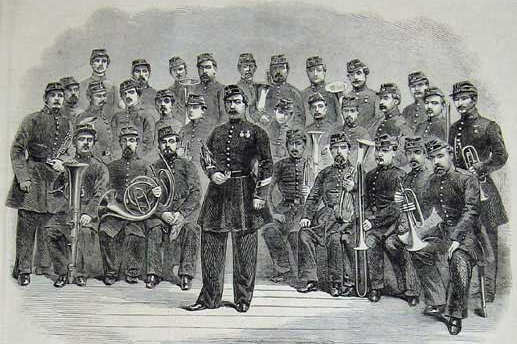 1858-1875—France: An engraving by Guillaumot of a serpent appears in the French dictionary, Dictionnaire raisonné du mobilier français de l’époque carlovingienne à la Rénaissance (see below image; public domain).
1858-1875—France: An engraving by Guillaumot of a serpent appears in the French dictionary, Dictionnaire raisonné du mobilier français de l’époque carlovingienne à la Rénaissance (see below image; public domain).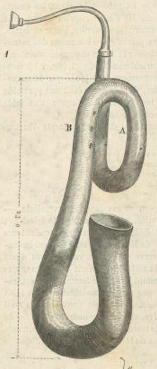 c. 1860—Peru: Artist Pancho Fierro depicts what appears to be an ophicleide as part of a wind band performing for a Peruvian wedding celebration in Fiesta de Matrimonio (see below detail and full image below; public domain) (Lavalle 38).
c. 1860—Peru: Artist Pancho Fierro depicts what appears to be an ophicleide as part of a wind band performing for a Peruvian wedding celebration in Fiesta de Matrimonio (see below detail and full image below; public domain) (Lavalle 38).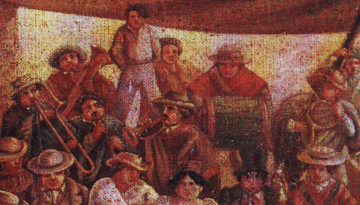
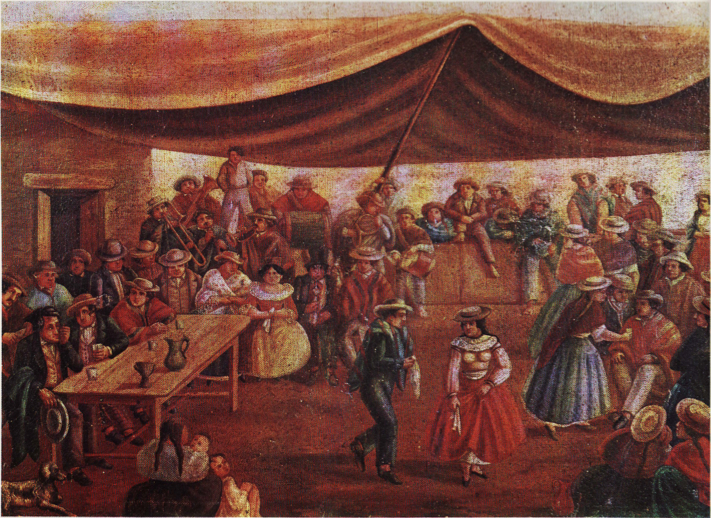 1860—England: An early photograph of the famous Besses o’ th’ Barn band includes ophicleide among an ensemble of primarily brass instruments (see below image; public domain) (Baines, Brass pl. XIV).
1860—England: An early photograph of the famous Besses o’ th’ Barn band includes ophicleide among an ensemble of primarily brass instruments (see below image; public domain) (Baines, Brass pl. XIV).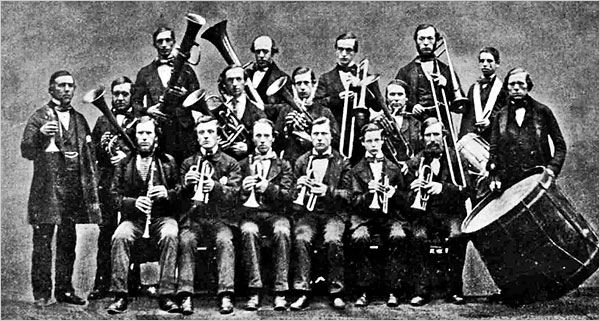 1860—Paris, France: La femme, faible créature, a print by Carlo Gripp, is published in L’Illustration (February 4, 1860, p. 77) (see below image; public domain).
1860—Paris, France: La femme, faible créature, a print by Carlo Gripp, is published in L’Illustration (February 4, 1860, p. 77) (see below image; public domain).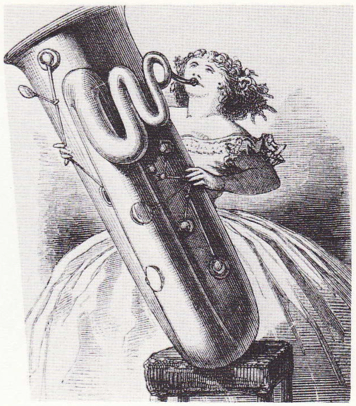 1860-1872—France: A color lithograph entitled Procession de Ste Anne d’Auray includes an ophicleide as part of the procession (see below image; public domain) (Paris, Museum of European and Mediterranean Civilization). For a similar image, see 1847, above.
1860-1872—France: A color lithograph entitled Procession de Ste Anne d’Auray includes an ophicleide as part of the procession (see below image; public domain) (Paris, Museum of European and Mediterranean Civilization). For a similar image, see 1847, above.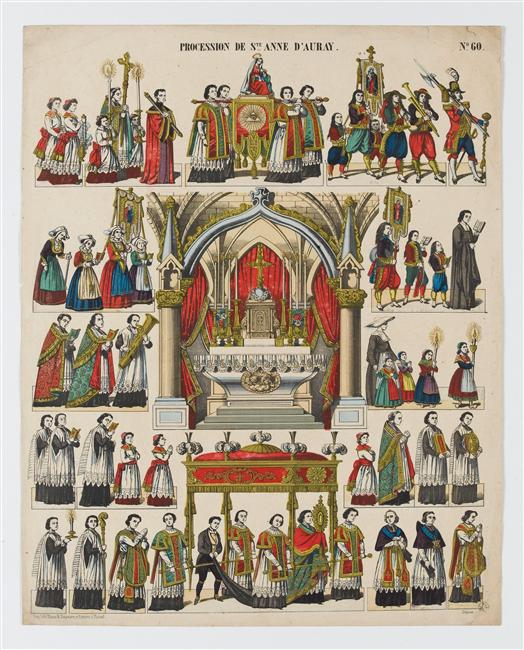 1861—Paris, France: A print after a sketch by Rogier, published in the periodical L’Illustration, depicts the entry and reception of European Commissioners in Damascus. Among the musicians is a pair of ophicleides and a rear-facing trombone (see below image; public domain) (February 23, 1861, p. 119).
1861—Paris, France: A print after a sketch by Rogier, published in the periodical L’Illustration, depicts the entry and reception of European Commissioners in Damascus. Among the musicians is a pair of ophicleides and a rear-facing trombone (see below image; public domain) (February 23, 1861, p. 119).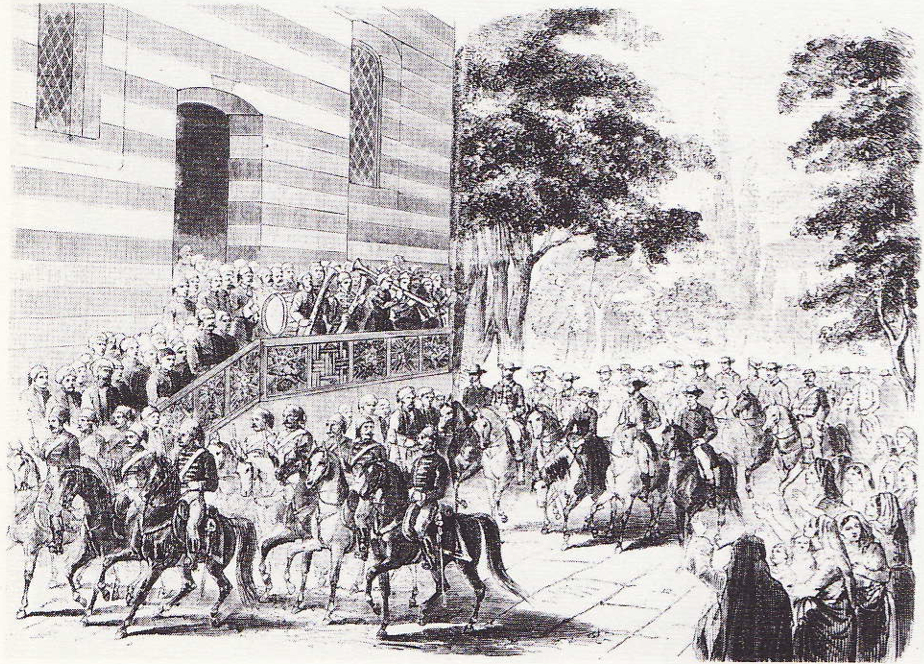 1862—France: Consequence of the Tax on Pianos, a print by satirist Amédée-Charles-Henri de Noe, aka Cham, is printed in Journal pour rire (see below image; public domain) (Fromrich 150).
1862—France: Consequence of the Tax on Pianos, a print by satirist Amédée-Charles-Henri de Noe, aka Cham, is printed in Journal pour rire (see below image; public domain) (Fromrich 150).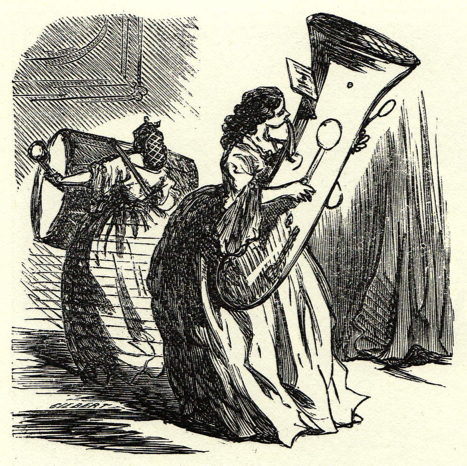 1862—Paris, France: Artist Janet Lange depicts an ophicleide player from the Mexican army in a print published in L’Illustration and titled Armée mexicaine—Musicien (see below image; public domain) (April 5, 1862, p. 214).
1862—Paris, France: Artist Janet Lange depicts an ophicleide player from the Mexican army in a print published in L’Illustration and titled Armée mexicaine—Musicien (see below image; public domain) (April 5, 1862, p. 214).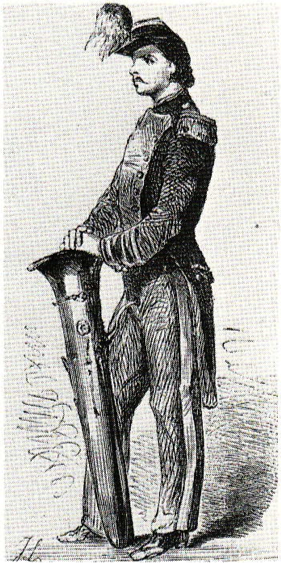
1862—Paris, France: A print by Jules Gaildrau entitled Fête des mécaniciens de la marine Impériale is published in the periodical L’Illustration. It includes an ophicleide among the band instruments at the celebration (see detail and full image below, after a sketch by Letuaire; public domain) (Dec 27, 1862, p. 432).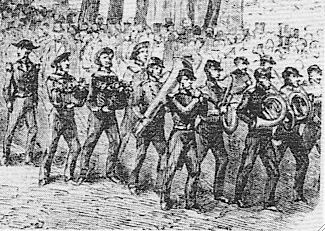
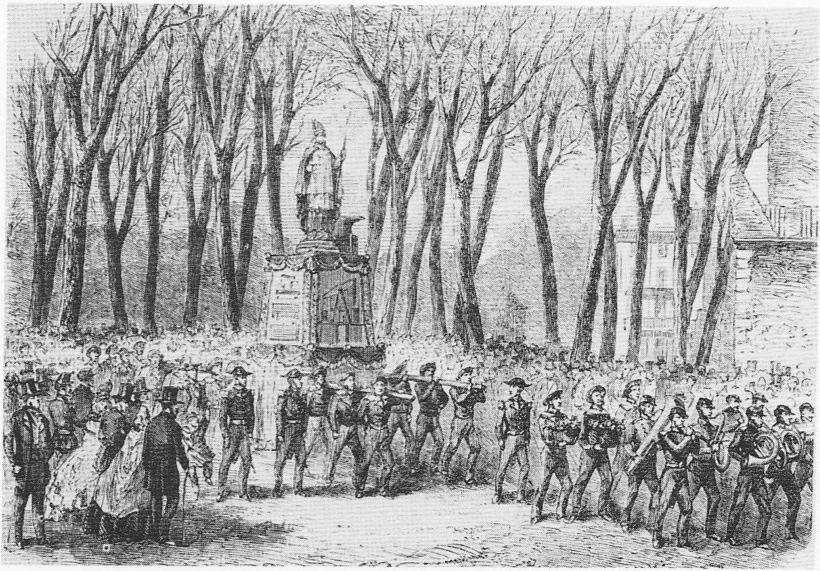
1862-71—Paris, France: A caricature by Draner (Jules Renard) from his collection, Types Militaires, reflects the two traditional homes of the serpent: church and military (see below image; public domain).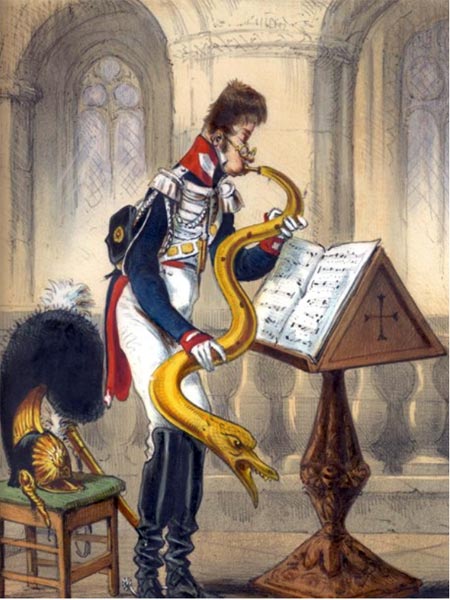
1863—Rome, Italy: Concerto di Frascati, a watercolor depicting military musicians in the town of Frascati, part of metropolitan Rome, features trombone and ophicleide (see below image; public domain) (Italian Digital Library; Istituto per la storia del Risorgimento italiano).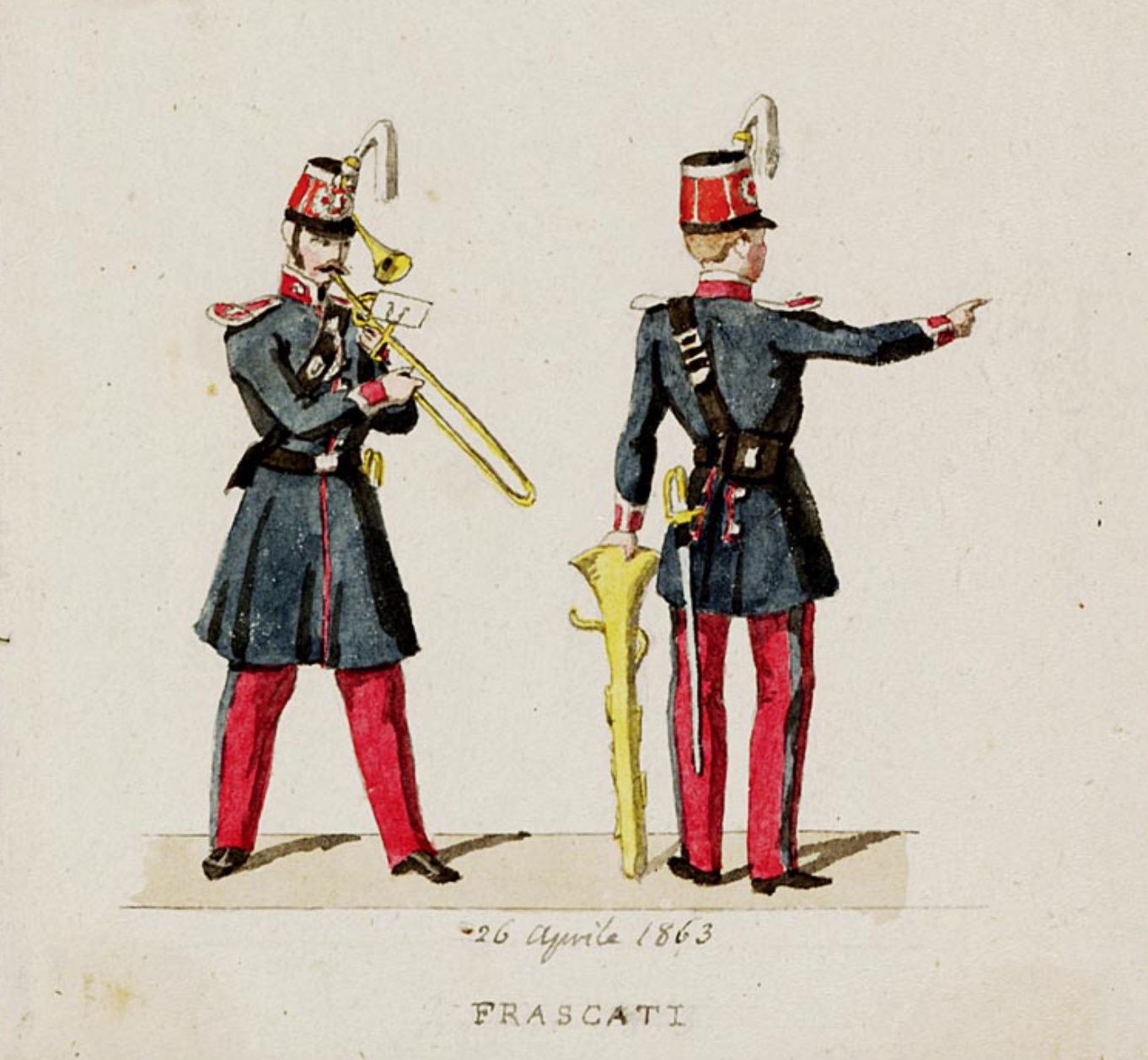
1865—Paris, France: A satirical graphic titled Domestic joys of parents whose daughters take part in women’s orchestras, published in Le monde illustré, includes a woman playing what appears to be an ophicleide (see below image; public domain) (Le monde illustré, 9, no. 442; Sept 30 1865).
1865—A satirical cartoon titled “The serpent starting to tempt the woman once again,” printed in Le monde illustré, features a woman playing a dragon-belled serpent (see below image; public domain) (Le monde illustré, 9, no. 442; Sept 30 1865).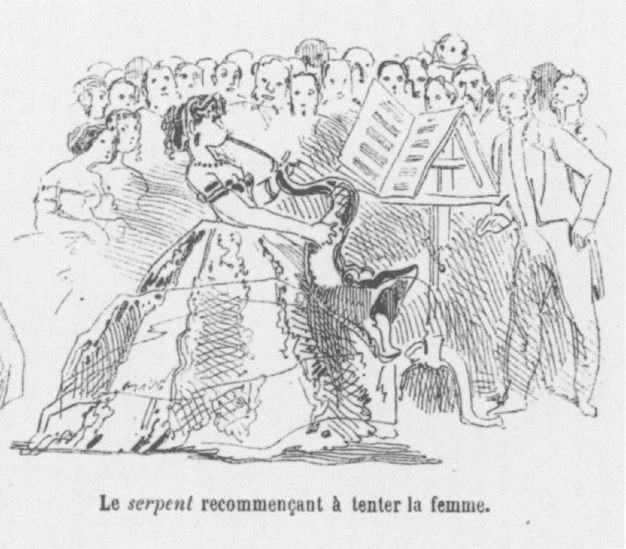
1865—Paris, France: The caption for a cartoon showing a man with an ophicleide over his head explains, curiously, that the musician uses his instrument to cure his migraine (see below image; public domain) (L’Illustration, April 8, 1865, p. 221).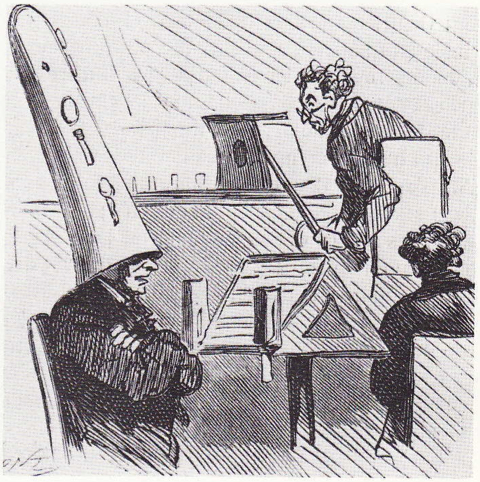
1865—Paris, France: The illustrated newspaper L’Illustration publishes a print depicting the Theatre imperial de l’Opera-Comique. What appears to be a man playing a serpent can be seen in the bottom-left corner of the picture (see below image; public domain) (December 23, 1865, p. 405).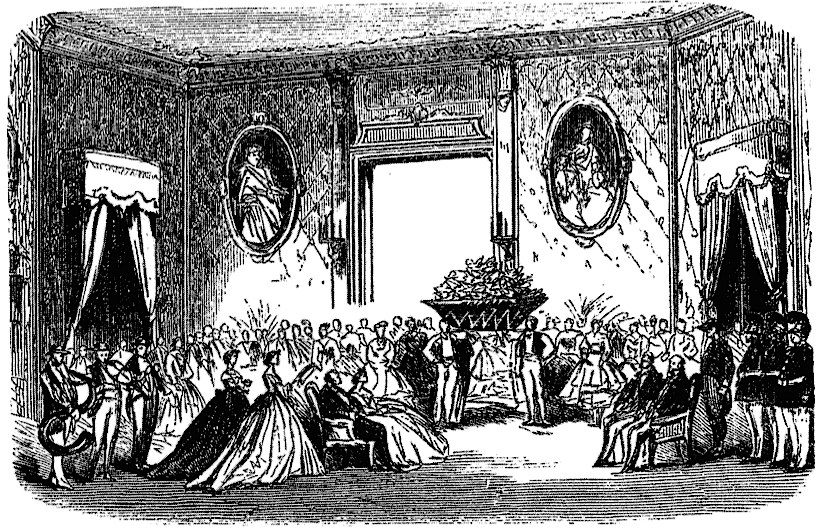
1865-1916—Netherlands: A painting by artist Willem Constantijn Staring (1847-1916) depicts bandsmen of the 9th Regiment Infantry, including a musician playing a green-colored serpent (see below image; public domain).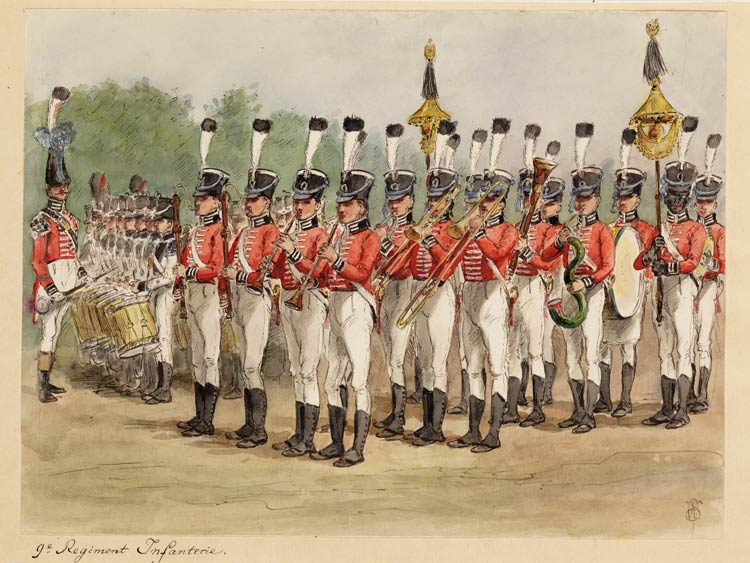
1867—Paris, France: A print after a drawing by Letuaire depicts the funeral convoy of Commander John Cornwall, US Navy, who died aboard the Miantonomah in Toulon Harbor. Among the musicians in the procession are two ophicleides (see detail and full image below; public domain) (L’Illustration, March 2, 1867, p. 140).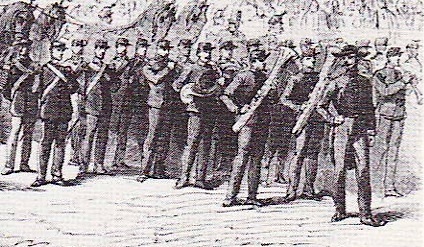
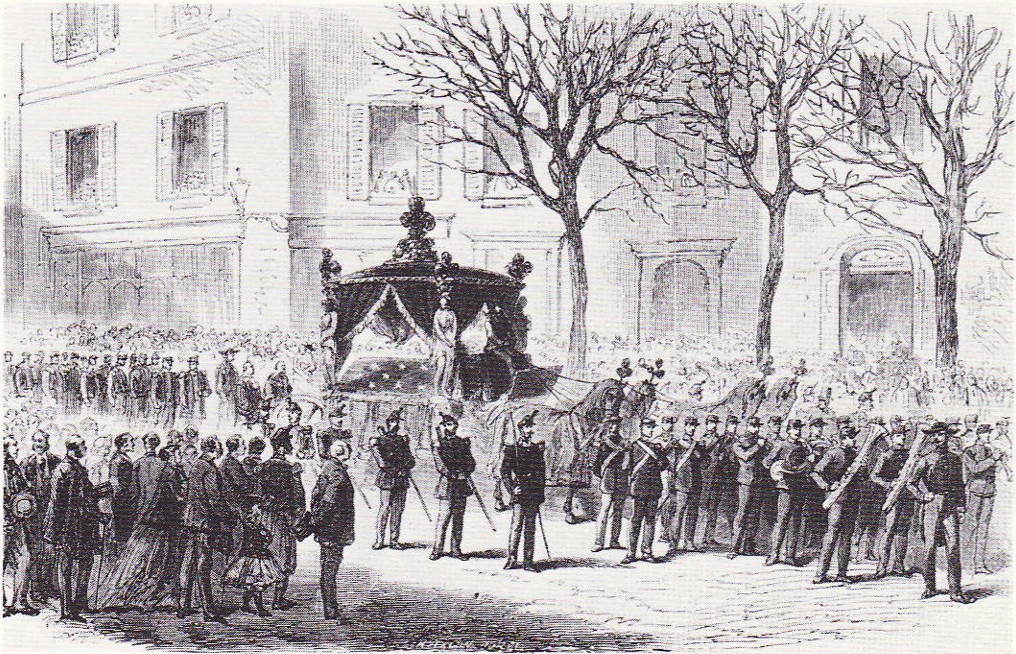
1870—Turnov, Czech Republic: An engraving after a drawing by A. J. Levy (1845-1897) portrays what appears to be an ophicleide playing with a brass band in the public square in Turnov (see detail below; public domain) (Volek plate 347).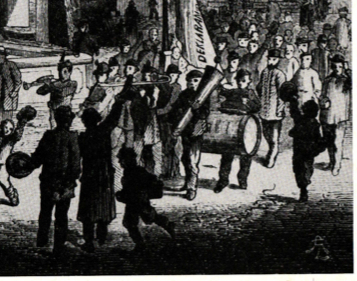 1871—Milan, Italy: Giuseppe Verdi makes the following comment about bass trombone in a letter to his publisher about the forthcoming Italian premiere of Aida: “I must insist on the fourth trombone. That bombardon is impossible. Tell Faccio [the conductor] to consult the first trombonist if he thinks fit, to see what should be done. I should prefer a bass trombone, which is of the same family as the others: but if it proves too tiring and difficult to play, take one of the usual ophicleides which go down to low B. In short, do whatever you please, but not that devil of a bombardon which does not blend with the others” (Leavis, Cimbasso).
1871—Milan, Italy: Giuseppe Verdi makes the following comment about bass trombone in a letter to his publisher about the forthcoming Italian premiere of Aida: “I must insist on the fourth trombone. That bombardon is impossible. Tell Faccio [the conductor] to consult the first trombonist if he thinks fit, to see what should be done. I should prefer a bass trombone, which is of the same family as the others: but if it proves too tiring and difficult to play, take one of the usual ophicleides which go down to low B. In short, do whatever you please, but not that devil of a bombardon which does not blend with the others” (Leavis, Cimbasso).
1872—Paris, France: A pair of humorous prints by Bertall titled Plus d’obéissance passive (more passive obedience) are published in the periodical L’Illustration. One of the images features an ophicleide player with a conductor (see below image; public domain) (June 29, 1872, p. 415).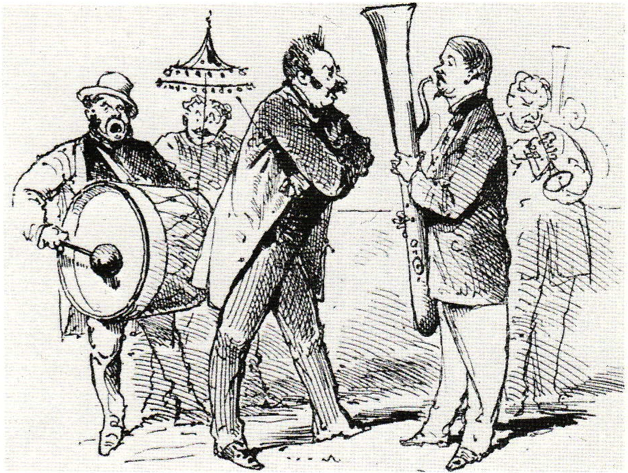 1872—London, England: A humorous depiction of an ensemble titled German Band is published in The Graphic, an illustrated weekly newspaper (see below image; public domain).
1872—London, England: A humorous depiction of an ensemble titled German Band is published in The Graphic, an illustrated weekly newspaper (see below image; public domain).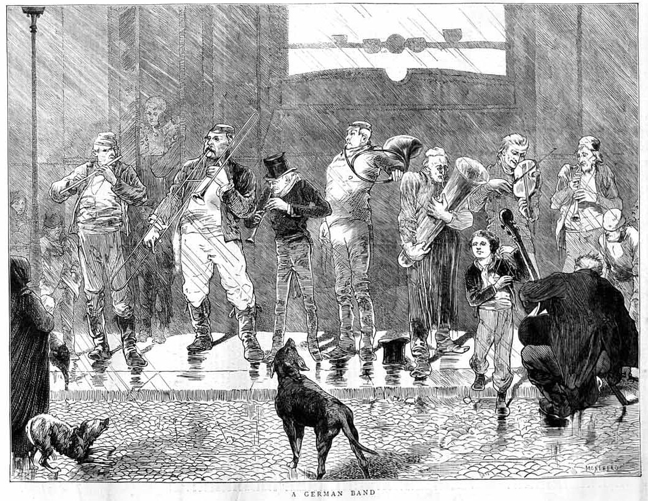
1874—Paris, France: A print by Bertall titled A serenade to M. de Lorgeril depicts a musical ensemble that includes what appears to be an ophicleide (see below image; public domain) (L’Illusration, February 28, 1874, p. 140).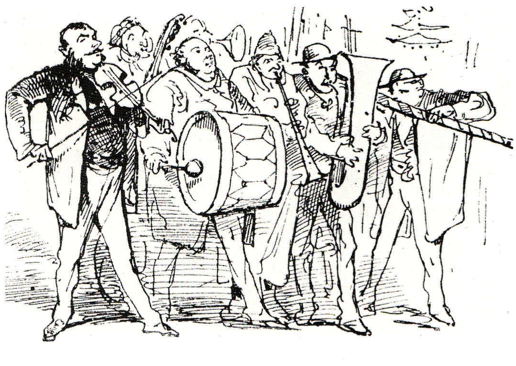
c. 1875—Paris, France: Choeur de six personnages en costume ecclésiastique devant un lutrin, a pen and ink drawing by French painter and illustrator Charles Henri Pille, features an ophicleide player accompanying 5 singers, all of them in religious garb (see below image; public domain) (Paris, The Louvre).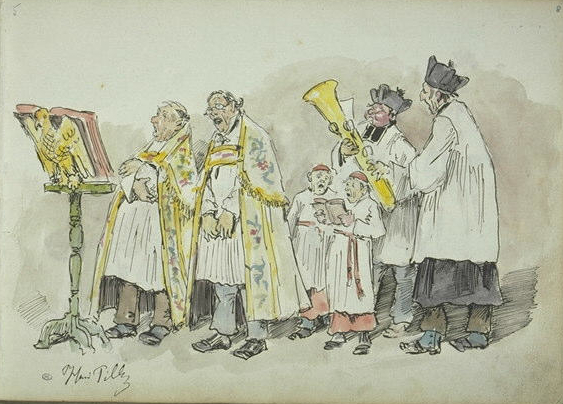
c. 1875—London, England: A set of caricatures by Major Thomas Strong Seccombe for a children’s alphabet book called Army and Navy Drolleries includes a lithograph of a bandsman playing ophicleide (see below image; public domain).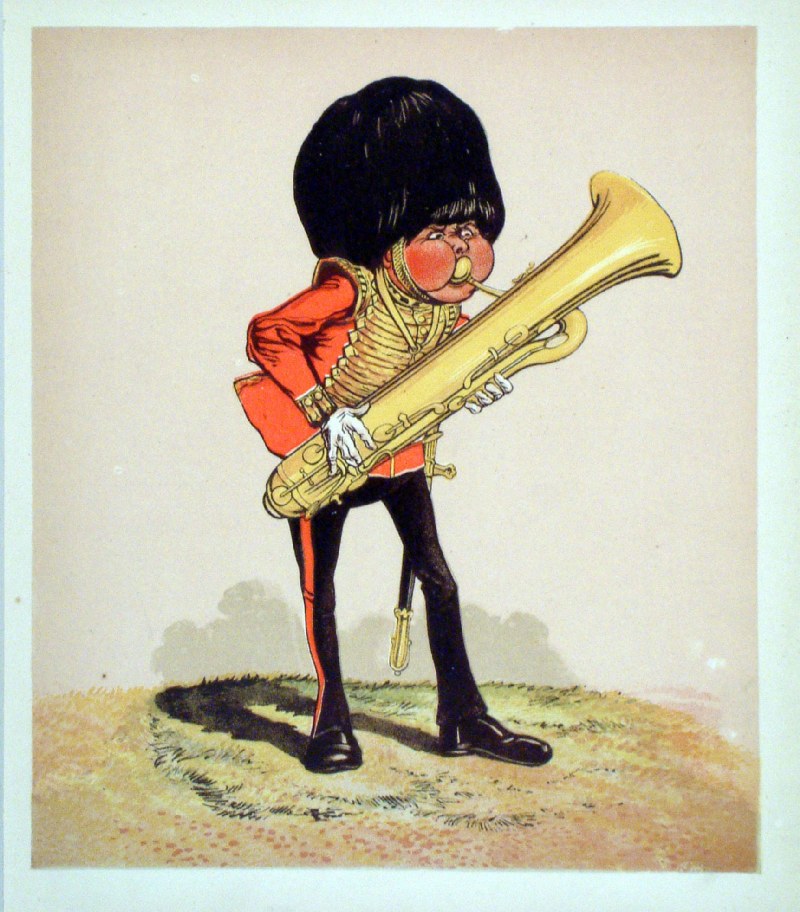
1875-1900—Epinal, France: An image published by Pellerin, entitled French Music (Dragoons), depicts a group of military musicians on horseback, including two playing ophicleide (see bottom row, below; public domain) (Museum of European and Mediterranean Civilization).
1875—Paris, France: An image of an ophicleide player getting rained on, titled The excursion to Lake Como thwarted by bad weather: A musician of the corporation Como, is published in the illustrated periodical, L’Illustration (see below image; public domain) (October 30, 1875, p. 274).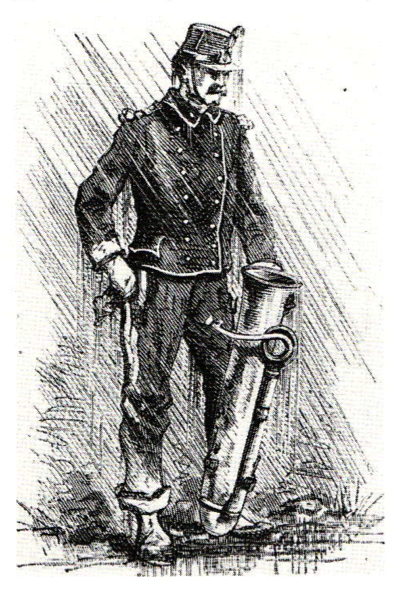
1876—Paris, France: Pépin’s, Musica de chambres, a political print published in Le Grelot (no. 278, August 6, 1876), depicts duelling ophicleides (see below image; public domain).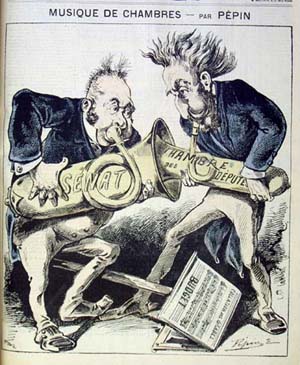
1876—Paris, France: Université illustrée publishes Chantres au lutrin, a print by Henri Brispot depicting a serpent with voices (see below image; public domain) (October 1876; source: Museum of Musical Instruments).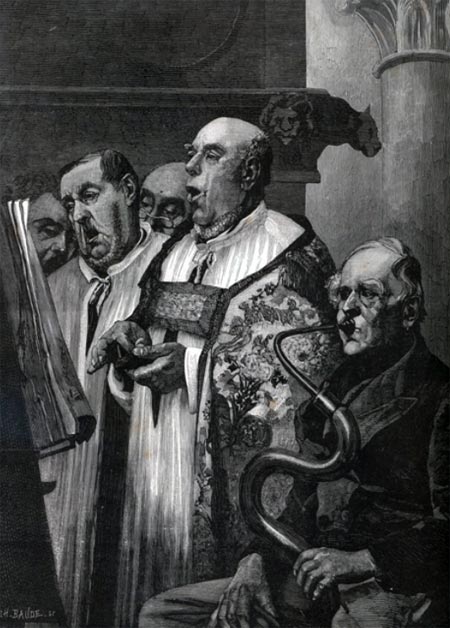
1879—Paris, France: A print of M. Denneulin’s Un Passage difficile is published in the illustrated periodical, L’Illustration (see below image; public domain) (March 8, 1879, p. 147).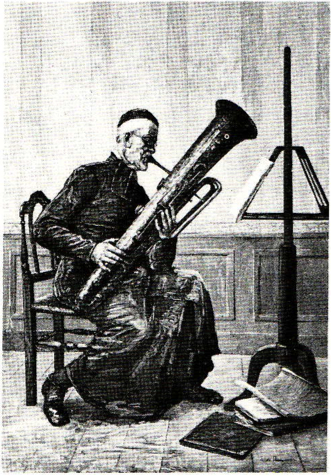
c. 1880—France: An oil painting very similar to several other images (e.g. 1879, above) shows a canon playing ophicleide (see below image; public domain) (source: Renard Music).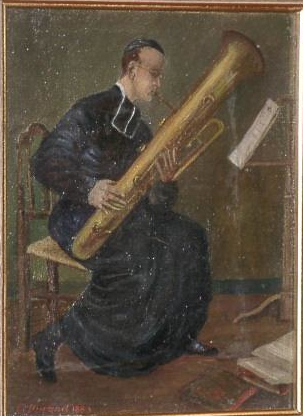
1883—Paris, France: L’Illustration publishes a caricature, titled Concours du Conservatoire, of an ophicleide player apparently impressing the judges at the conservatoire’s annual competition (see below image; public domain) (July 28, 1883, p. 61).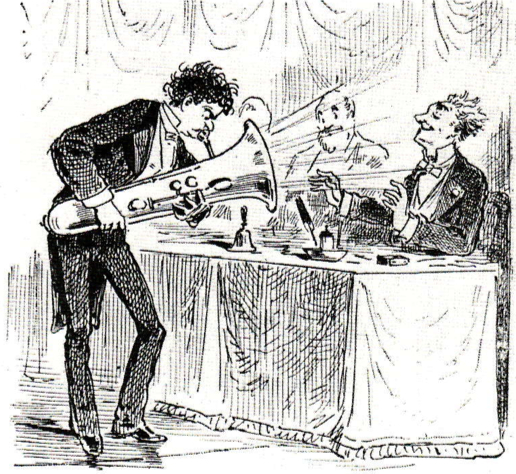
1883—United Kingdom: Macmillan publishes the third volume of the first edition of Grove’s Dictionary of Music and Musicians, which contains the below image of a serpent (see below; public domain).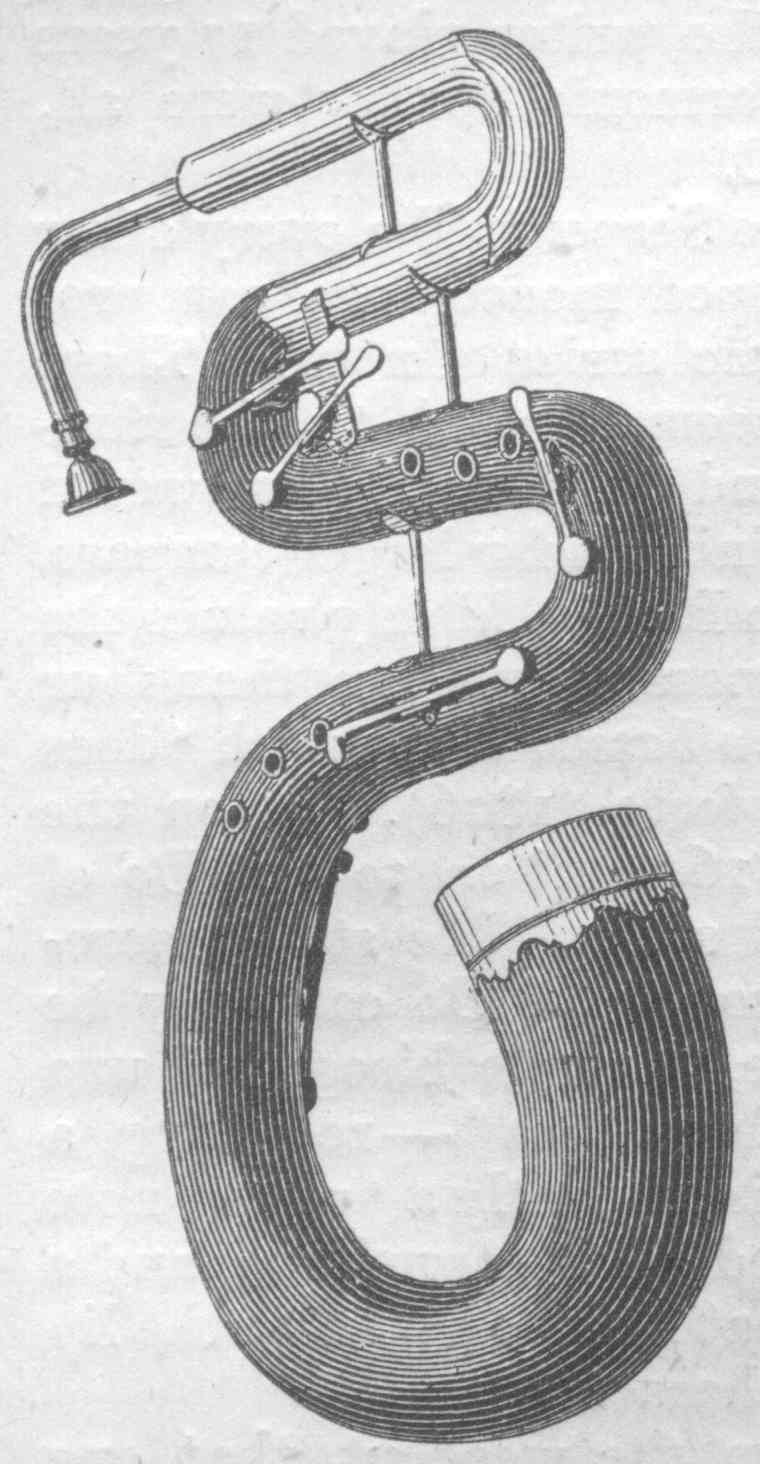
1883—France: Charles Gilbert-Martin’s L’homme Orchestra, asatirical political image published in the Don Quichotte magazine in July 1883, depicts a one man band that includes an ophicleide(see below image; public domain).
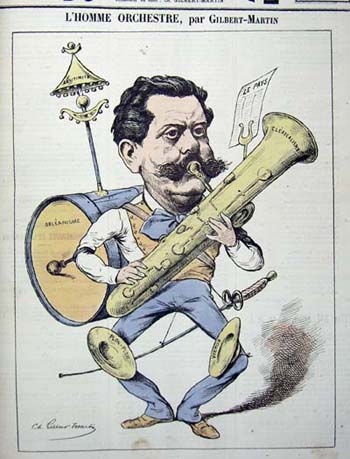 1886—Paris, France: The illustrated newspaper, L’Illustration, publishes a drawing of conservatory museum holdings, titled Le musée du conservatoire—Instruments a vent, that includes serpents (see below image; public domain) (July 24, 1886, p. 50).
1886—Paris, France: The illustrated newspaper, L’Illustration, publishes a drawing of conservatory museum holdings, titled Le musée du conservatoire—Instruments a vent, that includes serpents (see below image; public domain) (July 24, 1886, p. 50). 1887—France: Artist François Thévenot’s watercolor, La chorale de l’église de Vaucotte en 1887, depicts a choral rehearsal at the church of Vattetot-sur-Mer in which the music director holds an ophicleide (see below image; public domain).
1887—France: Artist François Thévenot’s watercolor, La chorale de l’église de Vaucotte en 1887, depicts a choral rehearsal at the church of Vattetot-sur-Mer in which the music director holds an ophicleide (see below image; public domain).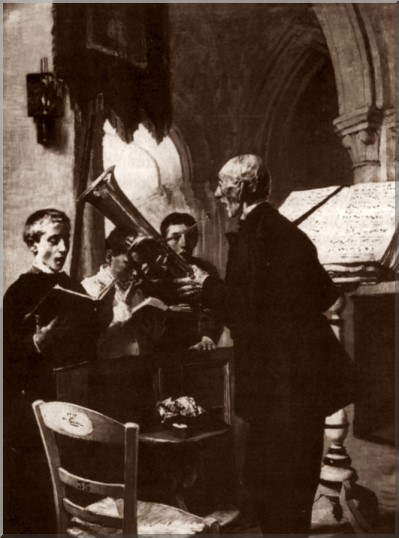 1887—France: A painting by Edmond de Boislecomte entitled The Lectern of Aulnay-les-Bondy features an ophicleide player in a sacred setting (see below image; public domain).
1887—France: A painting by Edmond de Boislecomte entitled The Lectern of Aulnay-les-Bondy features an ophicleide player in a sacred setting (see below image; public domain).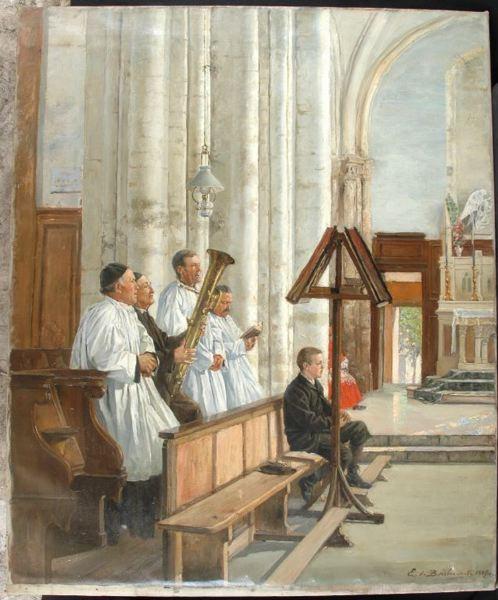 1888—Paris, France: François Sudre offers ophicleides in his catalogue (see below image; public domain) (Sudre, July 1888, p. 4).
1888—Paris, France: François Sudre offers ophicleides in his catalogue (see below image; public domain) (Sudre, July 1888, p. 4).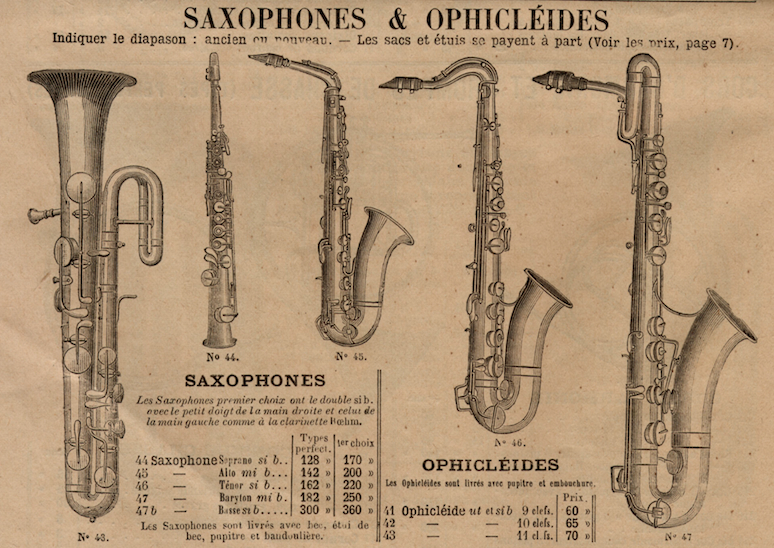 1888—Paris, France: Fernand Pelez’s Grimaces and Misery depicts poor circus workers situated on a platform, including a group of three seated musicians (see below detail and full image beneath; public domain) (Musée du Petit Palais, Paris).
1888—Paris, France: Fernand Pelez’s Grimaces and Misery depicts poor circus workers situated on a platform, including a group of three seated musicians (see below detail and full image beneath; public domain) (Musée du Petit Palais, Paris).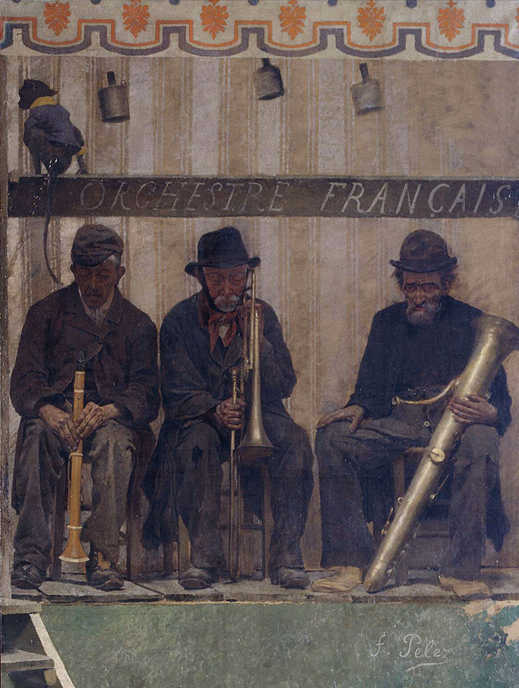
1889—London, England: Author George Bernard Shaw, in his music criticism column, comments on his family exposure to trombone: “I believe that a taste for brass instruments is hereditary. My father destroyed domestic peace by immoderate indulgence in the trombone; my uncle played the ophicleide—very nicely, I must admit—for years, and then perished by his own hand. Some day I shall buy a trombone myself.”
1893—Markneukirchen, Germany: A catalog for instrument manufacturer Paul Stark offers an ophicleide with several options (see middle of below image; public domain) (source: The Bassic Sax Blog).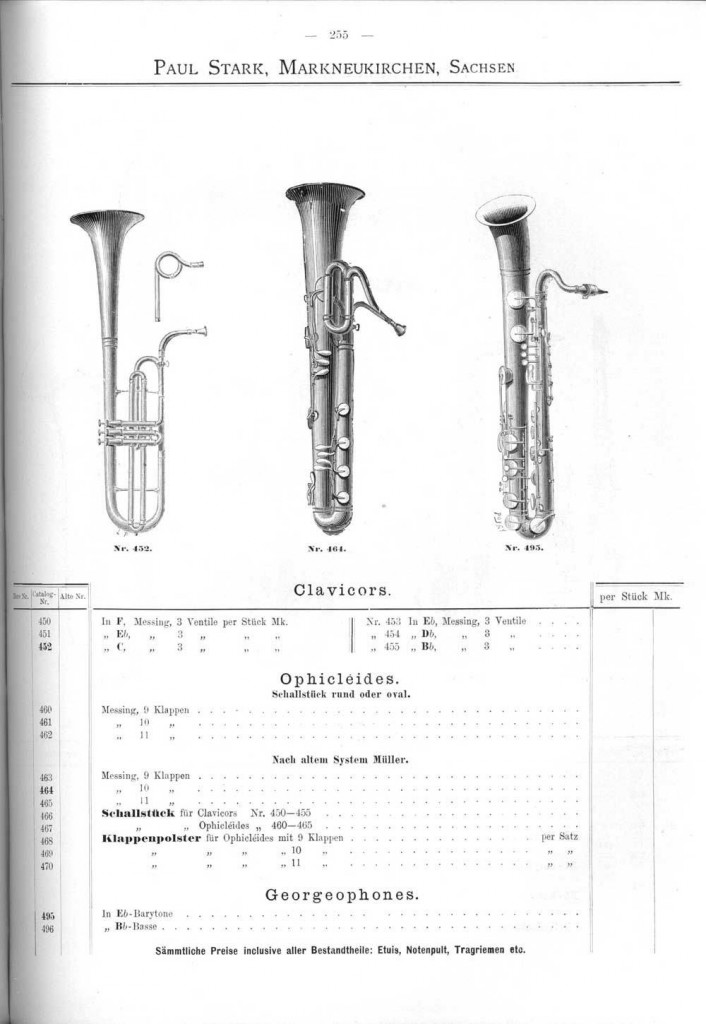
1894—Paris, France: A print by Henriot depicting a Salvation Army band in Paris’s Latin quarter includes what appears to be an ophicleide (see below image; public domain) (L’Illustration, February 10, 1894).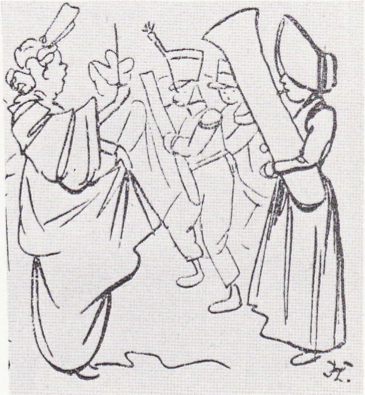 c. 1895—Rome, Italy: Spanish painter José Gallegos y Arnosa (1857-1917) depicts the ophicleide as a member of a small sacred ensemble accompanying a young boy’s chorus in two paintings, Choir Practice and Chorus (see below images; public domain). For a print based on these paintings, see here.
c. 1895—Rome, Italy: Spanish painter José Gallegos y Arnosa (1857-1917) depicts the ophicleide as a member of a small sacred ensemble accompanying a young boy’s chorus in two paintings, Choir Practice and Chorus (see below images; public domain). For a print based on these paintings, see here.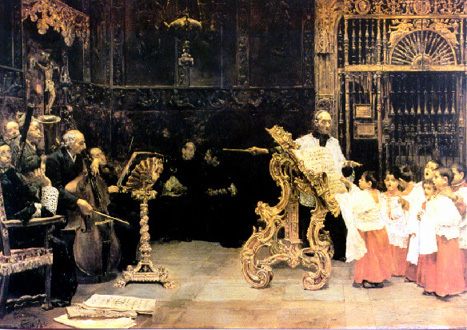
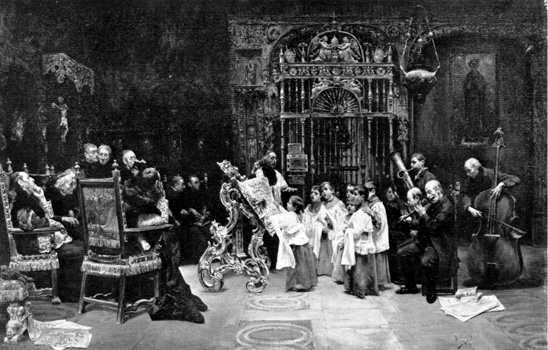
1895—Paris, France: Henriot’s comic, printed in L’Illustration, depicts a man in the cold conversing with an ophicleide player. The ophicleide player proclaims that he manages to stay warm by filling his horn with hot water (see below image; public domain) (March 16, 1895).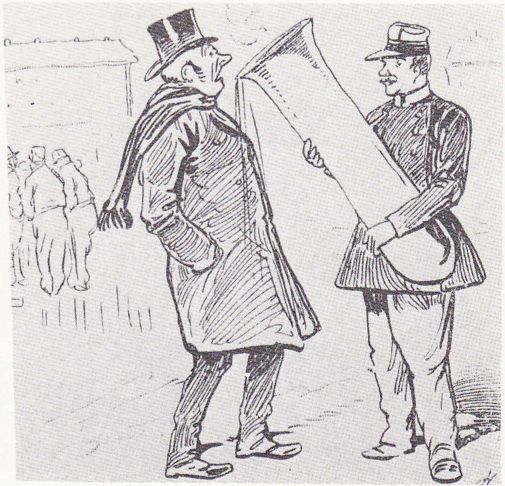
1895—Paris, France: An illustration of a concert of European toy soldiers for a music box by Henriot includes what appear to be multiple ophicleides (see below image; public domain) (L’Illustration, December 21, 1895, p. 4).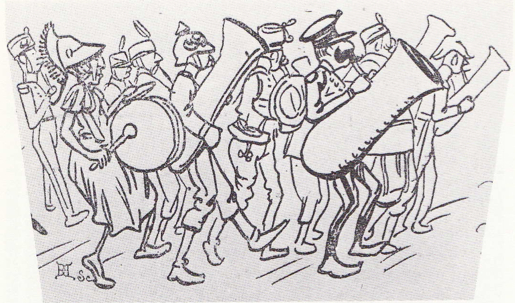
1897—Paris, France: The Soldier-Singers, a cartoon by Henriot, includes an ophicleide. The caption explains, “They add some canteen-singers to lend the regiment more gusto” (L’Illustration, June 26, 1897, p. 8) (see below image; public domain).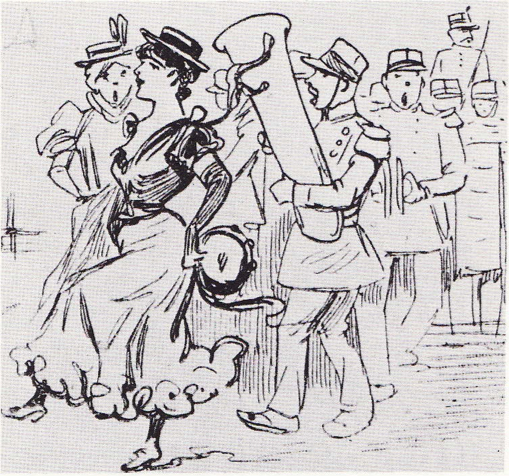
1897—Paris, France: Pépin’s La musique adoucit, etc…, a satirical political print, depicts two conjoined ophicleides (Le Grelot, no. 1389, Nov. 21, 1897) (see below image; public domain).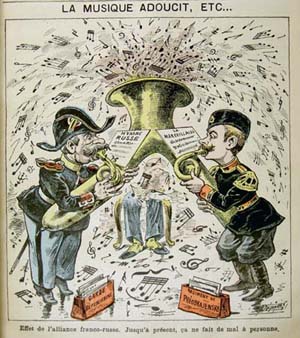
1897—Paris, France: An illustration for the cover of Figaro Illustré by H. Kaemmerer includes an ophicleide playing on stage at a Paris fair (see far left of below image; public domain) (Figaro Illustré 92, Nov. 1897).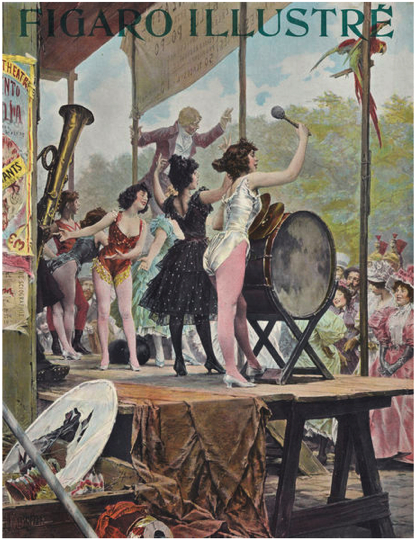
1897—Paris, France: A comic by Henriot (pseudonym for cartoonist Maigrot Henry) features an ophicleide being used to hold champagne by soldiers of the Préobrajensky regiment, a prestigious regiment of the Russian Imperial Guard. The caption reads, “La musique du régiment de Préobrajensky.—Encore des patriotes qui ont fourré dans ton ophicléide six bouteilles de champagne!—Je comprends maintenant pour quoi il ne voulait pas jouer!” (see below image; public domain) (L’Illustration, Nov 20, 1897).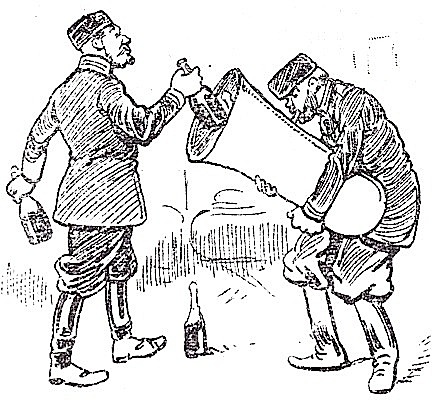
1898—Paris, France: A photograph published in L’Illustration includes a man holding an ophicleide. The caption reads “Brocanteurs emportant leur butin,” or, loosely translated, “Junk dealers taking their loot” (see below image; public domain) (March 12, 1898, p. 200).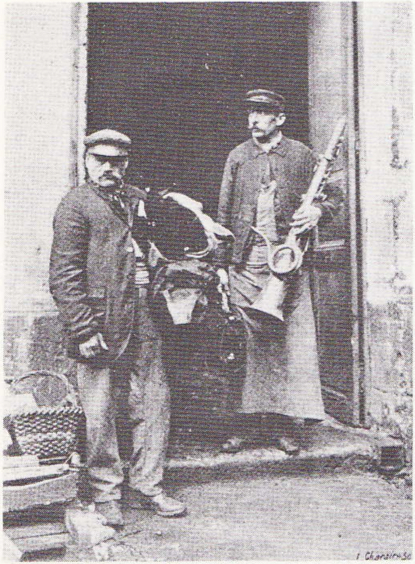
1898—Paris: Children watching a French soldier play the cymbals, military band in background, originally printed in L’épopée du costume militaire français, includes a soldier holding a serpent (see below image, click to expand; public domain).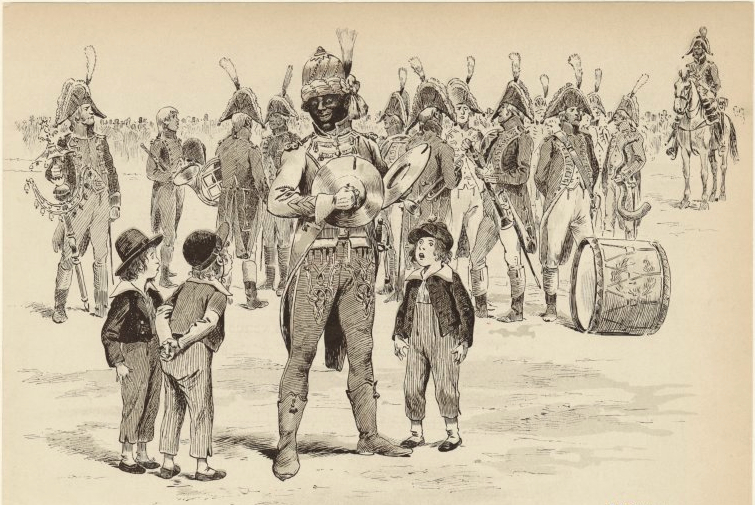
c. 1900—France: An image entitled Musique d’Infanterie by Maurice Orange (1867-1916), depicting military musicians of an earlier era (1806), includes a serpent and what is probably a buccin, or trombone with dragon-head bell (see below image; public domain).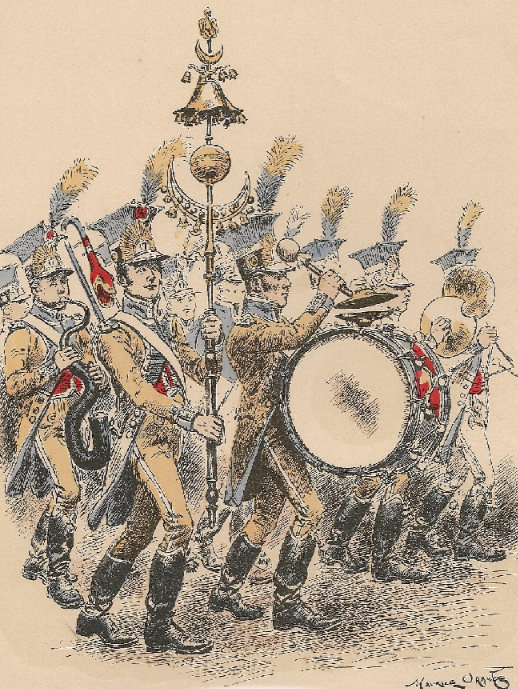 c. 1900—Philadelphia, PA (?): A painting by Jean Leon Gerome Ferris (1863-1930) entitled Liberty’s Pulpit includes a man holding an ophicleide. Use of an ophicleide in the painting could be a reflection of the artist’s training in France (see below image; public domain).
c. 1900—Philadelphia, PA (?): A painting by Jean Leon Gerome Ferris (1863-1930) entitled Liberty’s Pulpit includes a man holding an ophicleide. Use of an ophicleide in the painting could be a reflection of the artist’s training in France (see below image; public domain).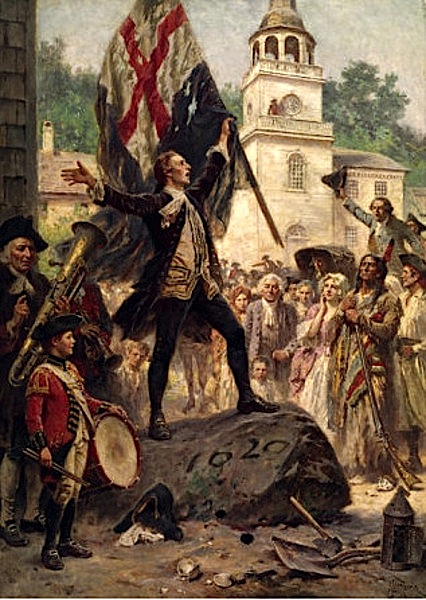
c. 1900—A French chocolate advertisement depicts a soldier playing ophicleide (see below image; public domain).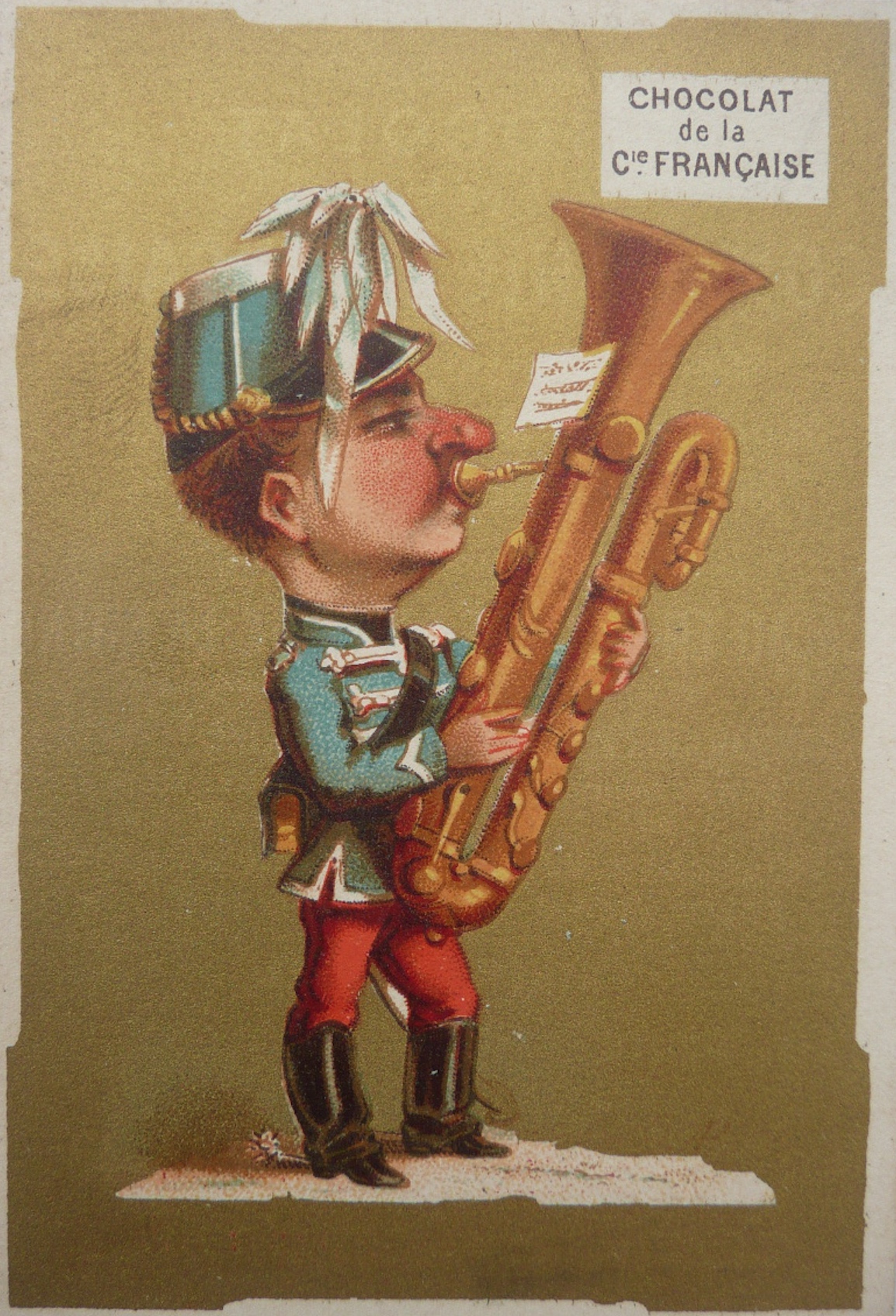
1900—Boston, MA: Louis Charles Elson includes a picture of a serpent in his discussion of musical instruments in Famous Composers and Their Works (see below image; public domain) (Elson Famous 140).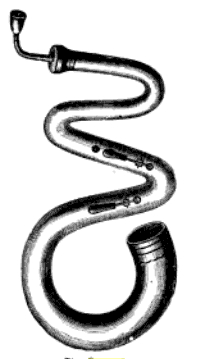
1906—A postcard by R. F. Outcault from Buster Brown Series No. 1000 depicts a young ophicleide player (see below image; public domain) (Serpent Newsletter, September 2011 [black and white version]).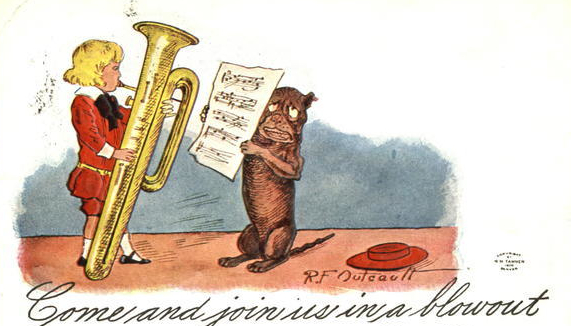
c. 1908—Cuba: Enrique Peña’s popular Cuban band, Orquesta típica, includes an ophicleide (figle) (see below image; public domain) (source: wikimedia commons).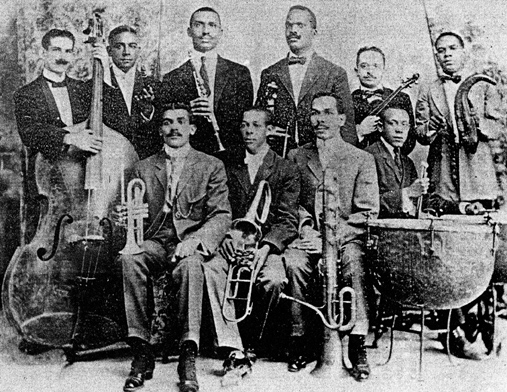
1909—Normandie, France: A postcard from Normandie, France features a photograph of a serpent player, probably from a rural church in France, playing from what appears to be a book of plainchant (see image below; public domain) (source: temposenzatempo).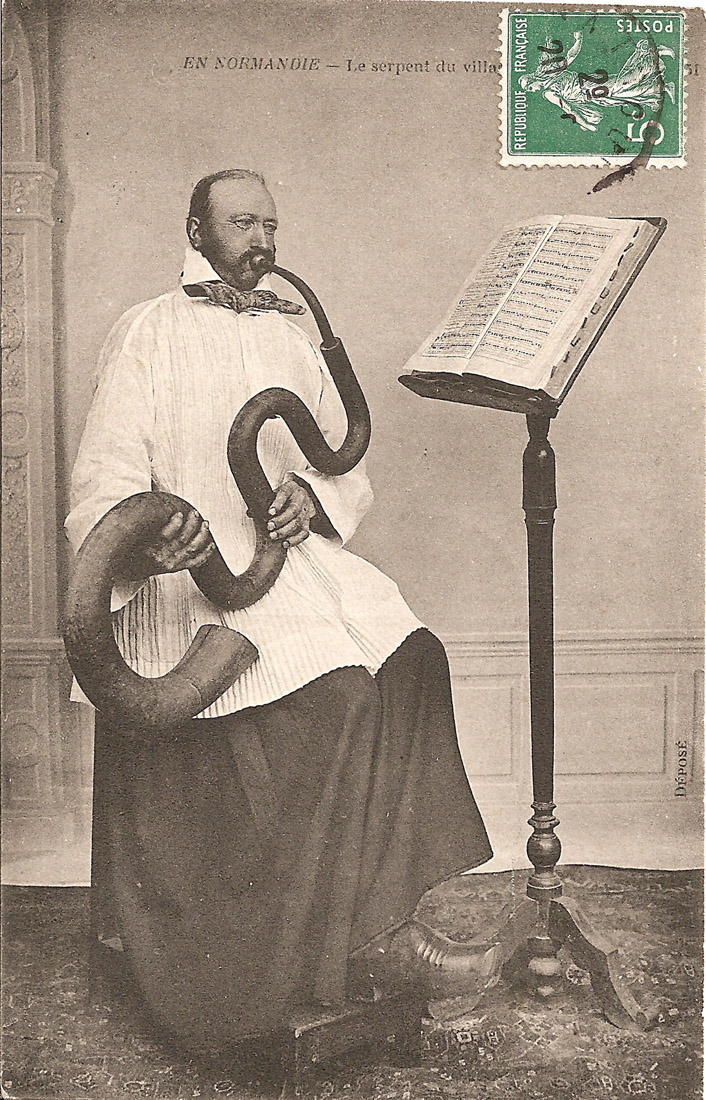
1909—An oil painting shown cantors playing bassoon and ophicleide is signed “Galla 1909” (see below image; public domain) (source: Renard Music).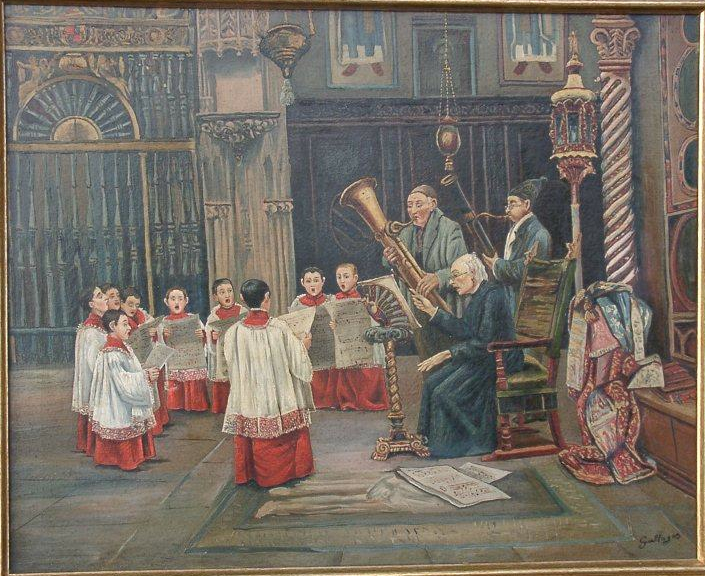
1909—Paris, France: A. Robida’s Le Patron Nicklaus, with illustrations by the author, includes an illustration of ophicleide participating in a serenade (see below image; public domain) (Robida 267).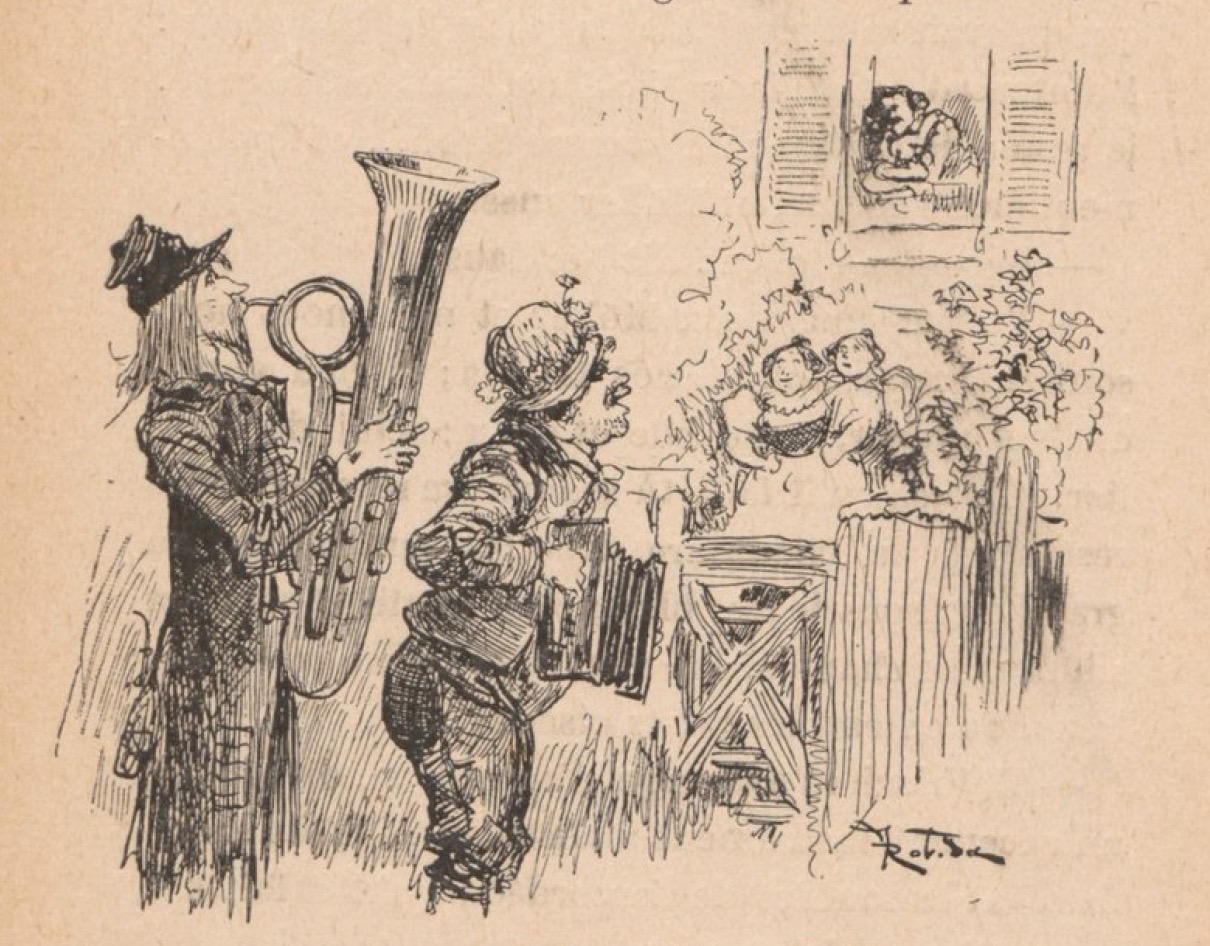
c. 1910—France: A postcard celebrating the French musical instrument company Couesnon features a young boy playing an ophicleide (see below image; public domain) (source: temposenzatempo). The same photograph is also found in the company’s 1912 catalogue (see 1912, below).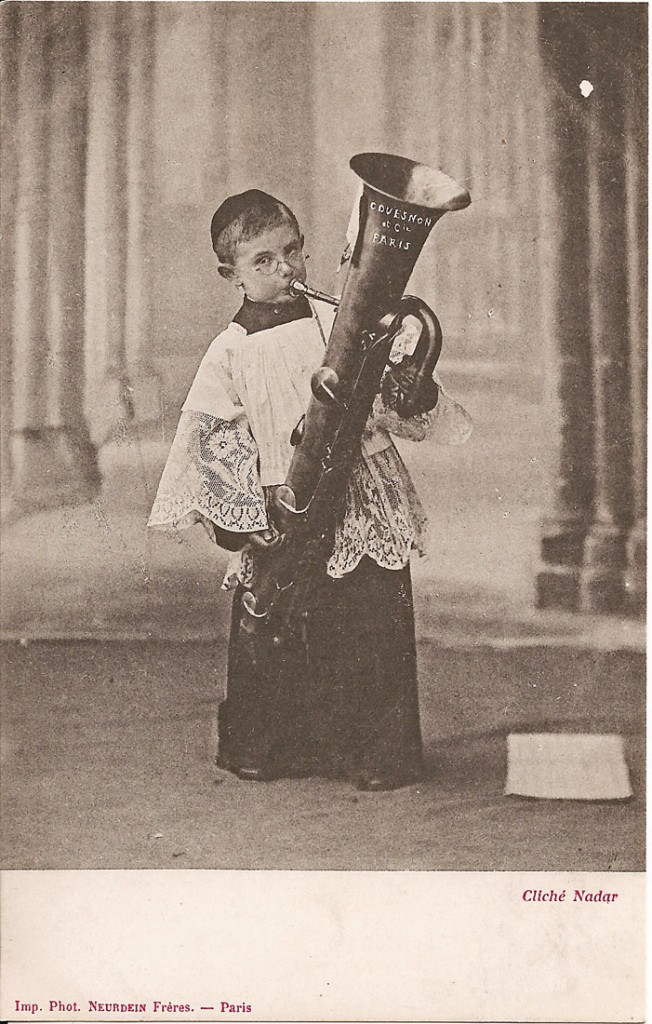
1910—England: The entry on ophicleide in the 1910 edition of Grove’s Dictionary of Music and Musicians includes the following statement: “Since the date of the first edition of this work the ophicleide has become obsolete.” Elsewhere in the article is the statement, “The tone of the ophicleide is, from its difference of scale and of material, less tender and veiled than that of its predecessor the serpent, but on the other hand it has greater compass and equality than that rather primitive contrivance.” The photograph included with the entry is shown below (see below image; public domain) (Grove’s, vol. 3, p. 473).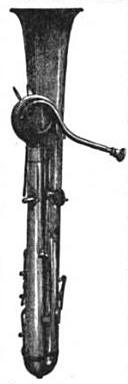 1912—Milan, Italy: In Ettore Panizza’s 2nd revised and updated Italian edition of Berlioz’s orchestration treatise, Panizza discusses contrabass trombone: “Berlioz does not mention the contrabass trombone. Its pitch corresponds to an octave below that of the tenor trombone. In Italy the introduction of a new instrument of this type was due to Giuseppe Verdi, and it adopted the name of this great musician. I refer to the ‘trombone basso Verdi’ in B flat. Its tone is fine, mellow and homogeneous, especially in its middle range, while being slightly weak in the bottom and high register. It is notated at concert pitch, that is the written note is the actual note sounded, in spite of the instrument being pitched in B flat. Verdi, who, as we have seen, had been its inspiration, wrote an important part for it in his Otello and later in Falstaff. Today this trombone has become very common in Italian orchestras, and almost all the parts for ophicleide or for tuba are played on the trombone Verdi” (Meucci).
1912—Milan, Italy: In Ettore Panizza’s 2nd revised and updated Italian edition of Berlioz’s orchestration treatise, Panizza discusses contrabass trombone: “Berlioz does not mention the contrabass trombone. Its pitch corresponds to an octave below that of the tenor trombone. In Italy the introduction of a new instrument of this type was due to Giuseppe Verdi, and it adopted the name of this great musician. I refer to the ‘trombone basso Verdi’ in B flat. Its tone is fine, mellow and homogeneous, especially in its middle range, while being slightly weak in the bottom and high register. It is notated at concert pitch, that is the written note is the actual note sounded, in spite of the instrument being pitched in B flat. Verdi, who, as we have seen, had been its inspiration, wrote an important part for it in his Otello and later in Falstaff. Today this trombone has become very common in Italian orchestras, and almost all the parts for ophicleide or for tuba are played on the trombone Verdi” (Meucci).
1912—France: A catalogue issued by the French musical instrument company of Couesnon advertises several ophicleide models. A young boy is shown demonstrating the instrument in the top-right of the page (see below image; public domain) (source: www.luthiers-miercourt.com).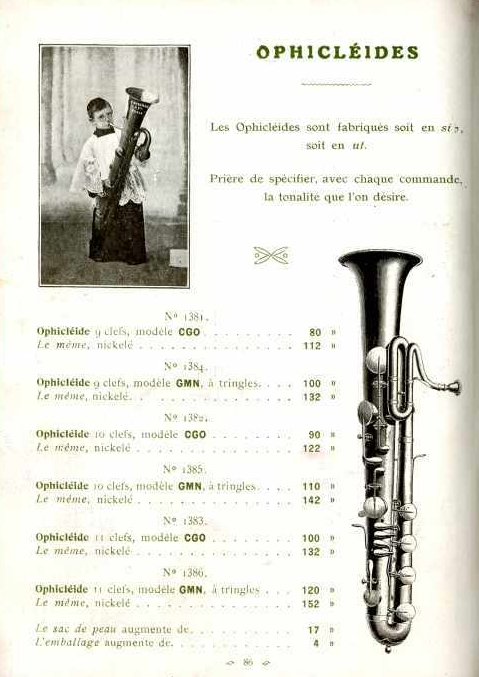
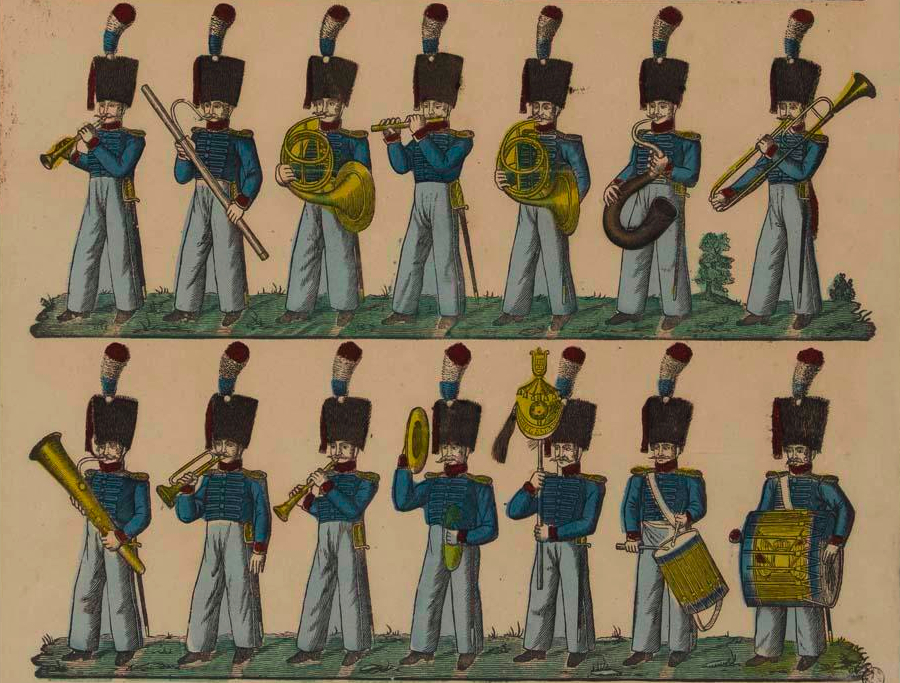
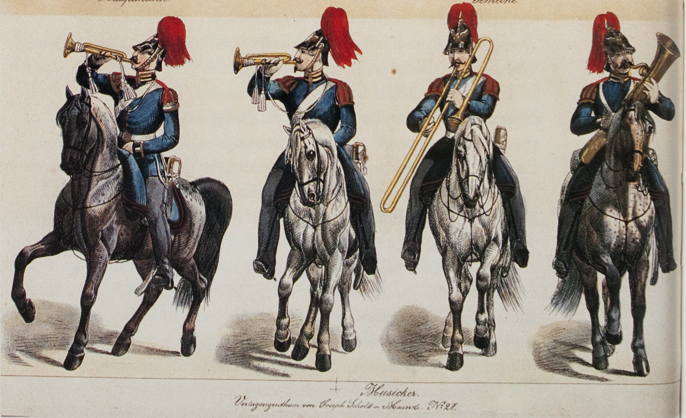
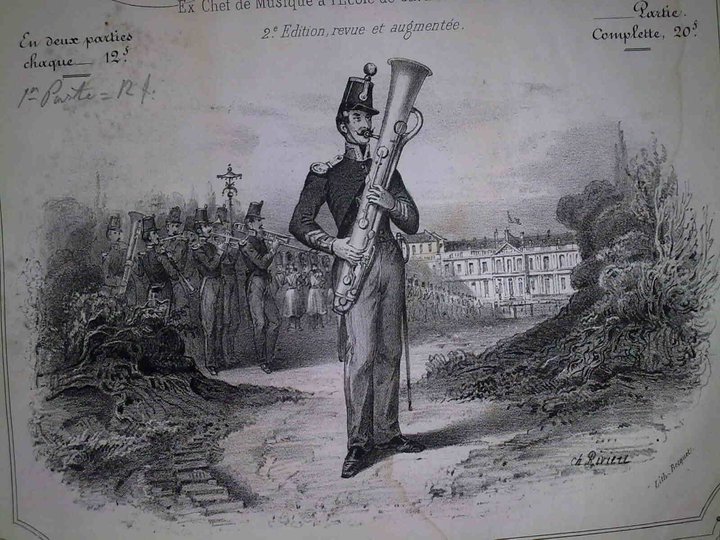
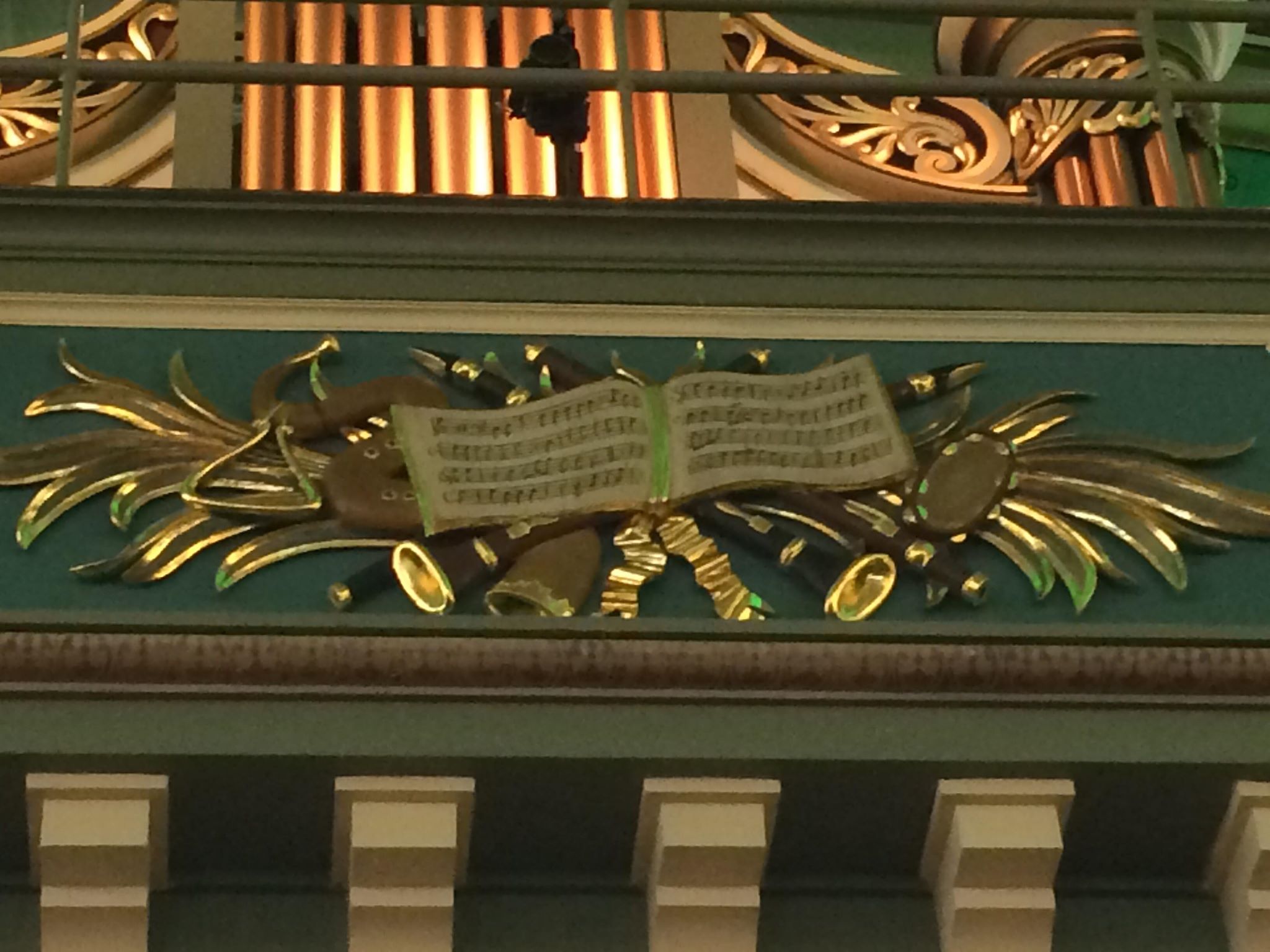
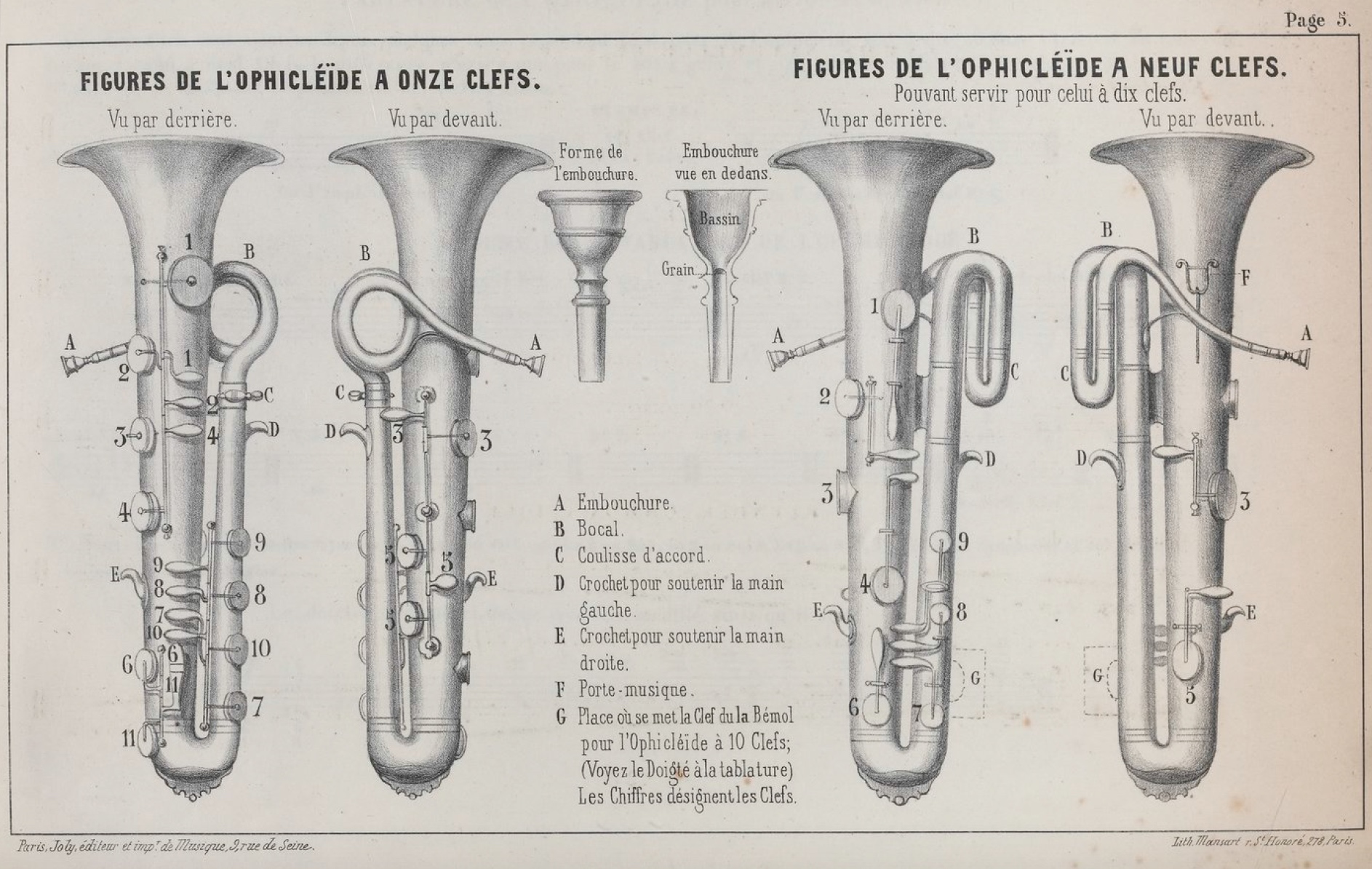
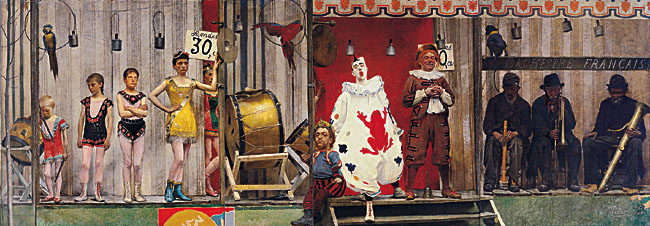
tony george
Bravo! what a fabulous resource. If I come across any pics you don’t have would you mind if I sent them to you?
wkimball
Thanks, Tony. Yes, absolutely—I would appreciate any pics you’ve got!
ACHARD Claude
“1865-1916—Netherlands: A painting by artist Willem Constantijn Staring (1847-1916) depicts bandsmen of the 9th Regiment Infantry, including a musician playing a green-colored serpent (see below image; public domain).”
La musique de ce régiment est décrite telle qu’elle existait vers 1807-1808 et, en tout cas, avant 1810. Cf. Les gravures du Bourgeois de Hambourg qui ont été prises sur le vif.
wkimball
Claude,
Thank you for your note. I use that span of dates because that was what my source indicated; however, I will continue to look for a source to verify the dates you suggest. It is also a question of listing the artwork by the date it was created versus the date it is intended to depict. This is an issue even in some of the very earliest trombone iconography; the Bellini procession, for example, was painted in 1496, but was intended to represent an event that took place several decades earlier (see the 15th century timeline). Most of the time I list the work of art at the creation date.
Thanks again,
Will
Bev Rock
Hi Will!
I’m not a musician but stumbled upon your site which I found absolutely fascinating!
The instruments and the old pictures are wonderful.
Thank you for gathering together information such as this which brings so much
pleasure and knowledge to people like me!
Regards
Bev
Greetings from Australia!!
wkimball
Bev,
G’day! Great to hear from an Aussie! Thank you much for your kind words. I’m glad you enjoyed the site.
Will
ACHARD Claude
Très intéressant. Une documentation étonnante!
wkimball
Claude,
Thank you very much! I’m glad you enjoyed it.
Will
S.F. Hall
Here’s one that’s unusual–right angles and terminated in a square bell…
http://www.europeana.eu/portal/record/09102/7E7CEA716D05B5719E908465434D6127BAA709DB.html
wkimball
I’ve seen a serpent like you’re describing, although I can’t seem to see it on the link you’ve provided. Here’s the one I’m thinking of:
https://kimballtrombone.com/2010/06/12/new-timeline-image-trombone-and-serpent-together/
Edwin Macadam
Will – Long time ago I once saw a copy of a Christmas card depicting angels on a blue background playing numerous musical instruments, but never got the chance to study it carefully. I wonder could this be what you have depicted in your 5th and 6th illustrations?
It was said to be a reproduction of a painting in the Prado Museum, and dated from the 15th century, if I remember correctly. The angel playing what I thought was a possible early type of serpent had the bell of the instrument above her head, rather like a modern sousaphone, but did not play it in the same way, ie not wrapped around her body.
I’ve never seen another copy or reproduction, but you might have better luck!
wkimball
Edwin,
That does sound a lot like the 5th and 6th illustrations. And the Prado would of course fit with the “Spanish school” designation. I’ll have to poke around and see what I can find.
Thanks!
Will
Pierre Ribo
Dear,
Your blog is a real gold mine…. Congratulations
I prepare a lecture to present during a trip in Japan. It talks about links between steps in instrument making and desired musical goals. I would like to present 2 photos and mention your comments, with you name!. Do you agree?
Best regards
Pierre
wkimball
Pierre,
Thank you, I’m glad you have found the site useful! Feel free to present those photos and comments in your lecture in Japan. It would be kind of you to mention the website.
Thanks,
Will
PARTOUCHE David
Sir,
All my thanks for this wonderful site very well documented.
Friendship of a serpentist and ophicleidist.
David
wkimball
Thank you, David. Thanks for dropping by!